- The Most Beautiful Castles To...

The Most Beautiful Castles to Visit in Normandy, France

Travel Writer
It doesn’t take much for a castle to look magical. All it really needs is towers, ramparts and maybe a knight or two. But these ‘châteaux’ in Normandy are particularly alluring – some sit on rocky cliffs surrounded by lush valleys and others carry centuries-old history on their weary fortifications. Read on to discover the most beautiful castles to visit in Normandy.
Mont saint-michel.

Technically more a fortified abbey on a rocky island than a castle, Mont Saint-Michel is one of the most impressive sights in Normandy. Dating to the ninth century, it was a Christian pilgrimage site for years, keeping invaders at bay with high ramparts and the high waves crashing onto them. It also served as a prison in the 15th century, detaining opponents to the French monarchy. Now, more than 3m tourists visit Mont Saint-Michel every year to stroll around the grand medieval fortifications and view the abbey.
Château de Gisors

The construction of this 11th-century fortress was commissioned by King William II of England to protect the Anglo-Norman territory from the French crown. Initially, it was a wooden keep upon a 15m (50ft) motte, but was later reinforced with a circular stone curtain wall. King Philip II of France captured the castle in 1193 and added a prison tower and barbican. Today, the French Ministry of Culture recognises the Château de Gisors as a monument historique , protected status that signifies the importance of the building to the heritage of France. Legend has it, treasures of the Knights Templar are hidden somewhere on the grounds, but they are yet to be unearthed.
Château Gaillard

Château Gaillard has been overlooking the River Seine above the commune of Les Andelys since medieval times – though beautiful ruins are all that remain. Built as a military base for Richard the Lionheart in the 12th century, this chateau is a prime example of an early concentric fortification. It was also one of the first castles in Europe to use machicolations – wall openings that allowed those inside to pour hot oil or boiling water (or drop stones) on attackers. Galliard changed hands several times during the Hundred Years’ War, until the French captured it in 1449. Its destruction was ordered by Henry IV of France in 1599.
Château d’Harcourt

Though only the façade of the old entrance vestibule, the chapel and one of the outbuildings remain from the initial 12th-century structure, several enhancements were added over the years to make Château d’Harcourt habitable – a curtain wall and nine round towers were built in the 13th century and there was another remodelling in the 17th century. In 1944, the SS Das Reich division of the German army set the castle on fire and with it more than 150 precious paintings. Today, Château d’ Harcourt is home to one of the oldest arboretums in France, created back in 1802, and has a botanical collection of more than 200 species.
Château de Creully

The lovely Château de Creully was built in the 11th century, but it’s been heavily modified over the years. It consists of a medieval enclosure with vaulted rooms and a square tower, while a Renaissance turret was added later. It wasn’t until about 1360 when it got its fortress design. During the Hundred Years’ War, the castle kept changing hands between the English and the French, with each making modifications to the structure. The chateau also played an important role in the D-Day landings of the Allied troops in Normandy, with the square tower serving as the BBC headquarters until 1944. The castle now holds events such as weddings, exhibitions and conferences.
Château de Falaise

Another castle that changed hands multiple times is Château de Falaise. William the Conqueror was born on this very site around 1028, in an earlier castle replaced by the current chateau . This was eventually inherited by William’s descendants, before being captured by King Philip II of France in the 13th century. During the Hundred Years’ War, the chateau had many more occupants before it was abandoned in the 17th century and bombarded during World War II. The castle of today, which stands on a cliff above the town of Falaise, includes many parts from the 12th- and the 13th-century structure. Around 1840, it was designated a monument historique.

Become a Culture Tripper!
Sign up to our newsletter to save up to $1,200 on our unique trips..
See privacy policy .
Château de Gratot

In the Norman countryside a few kilometres from the English Channel, Château de Gratot is among the most picturesque of the bunch. Its four towers were built between the 13th and 18th century and are surrounded by a large moat. The most distinct is the Fairy Tower; legend says it was once the room of a fairy who married the Lord of Argouges. For their peculiar union to work, there was one rule: the lord was never to mention death in front of the fairy. But, eventually, he accidentally did, and so the fairy flew out the window and they never saw each other again. If you visit Gratot, don’t forget to look for the fairy’s handprint in the stone.
Château de Caen

Built around 1060 by William the Conqueror, Château de Caen is one of the largest medieval enclosure castles in Europe, and offers some of the prettiest city views of Caen. The castle has been at the forefront of many battles over the years, with the English occupying it during the Hundred Years’ War. It now houses St Georges Church, built by Henry I (William’s son) in 1123; an underground area called the Rampart Rooms; a medicinal garden; and two museums, the Museum of Normandy and the Museum of Fine Arts. The chateau was declared a monument historique in 1997.
Château d’Arques-la-Bataille

Even though there’s not much left of the 12th-century Château d’Arques-la-Bataille, the ruins of this historic chateau reveal its tormented past. The castle endured several battles before becoming the last Norman castle to surrender to King Philip II of France in 1204, thus uniting Normandy with his growing French territory. Château d’Arques-la-Bataille was also where Joan of Arc was held in 1431, before she was tried and sentenced to death in Rouen. Standing on a rocky outcrop, this historic property is now the ideal spot for vistas across the Varenne Valley and all the way to the sea.
Château de Carrouges

This dreamlike chateau made from brick, slate and granite sits within the Normandie-Maine Regional Nature Park and was built as a stately residence between the 14th and 17th centuries. Unlike other medieval castles in Normandy, Carrouges is an example of French Renaissance architecture. It has a decorative wrought iron gate and a rectangular garden designed by Francois Gabriel in the 16th century. He also added two symmetrical wings to the garden borders. The castle belonged to Le Veneur de Tillières family until 1936, when they sold it to the French government. Inside, there’s the Louis XI Chamber (where the king stayed for one night in the 15th century), along with portraits of the chateau ’s previous owners. Looking for a gorgeous place to stay in France? Check out our pick of the best hotels in Honfleur, for every traveller, bookable with Culture Trip.

An Essential Guide to the Beautiful Porquerolles Island, France

8 Top Flea Markets and Thrift Stores in Marseille

20 Unmissable Attractions in Provence

The Most Beautiful Beaches in Nice, France

The 11 Best Coastal Towns and Cities to Visit in France

Unmissable Attractions in the Loire Valley

The 8 Best Beaches to Visit in France

The 7 Most Beautiful Beaches in and Around Montpellier

30 Unmissable Attractions in Lille

The Top 10 Things To Do in Toulon, France

The Top 17 Romantic Destinations to Visit in France

Unmissable Attractions in St Tropez
Culture Trip Summer Sale
Save up to $1,200 on our unique small-group trips! Limited spots.

- Post ID: 1002076218
- Sponsored? No
- View Payload
- Skip to primary navigation
- Skip to main content
- Skip to primary sidebar
- Skip to footer

Normandie Lovers
To awaken your senses in Normandy - Claire et Manu’s Blog
Château de Carrouges (Normandy): visit + photos
by Sèverine HARZO , Region Lovers | March 29, 2024 | no intrusive ads, no sponsored content, just some affiliate links - if you use them, we get a small commission (read more)
Planning a trip to Normandy ? We strongly recommend a visit to the Château de Carrouges . A choice stopover, halfway between Alençon and Argentan. The château is one of the 2 jewels of Normandy’s heritage, along with Mont-Saint-Michel . Erected during the Hundred Years’ War, its red-brick walls resonate with captivating stories. They plunge visitors into the prestigious past of the Lords of Carrouges, who owned the site for 7 centuries!
In this article, you’ll find a selection of useful tips to help you prepare for your visit. You’ll spend an unforgettable moment immersed in the history of one of Normandy’s great aristocratic residences!
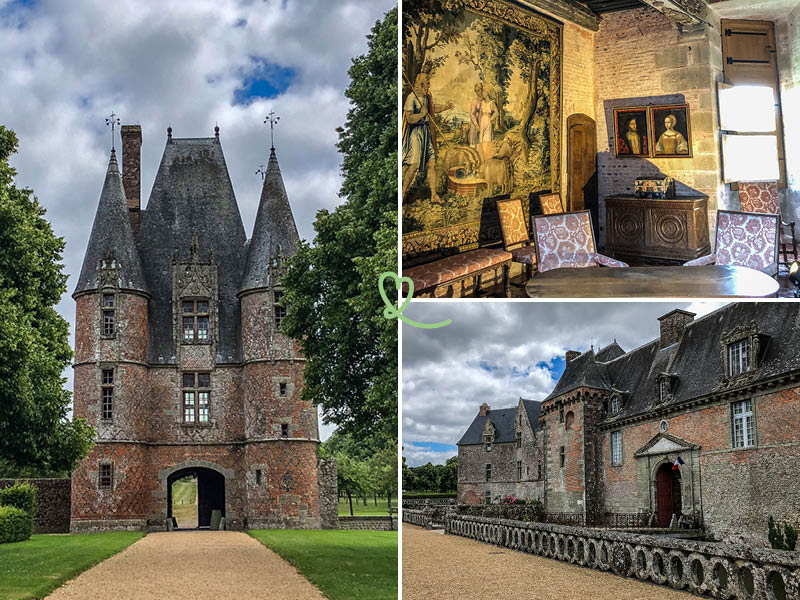
This guide is completely independent , based on our experiences. We visited the region anonymously, making our own choices and paying our bills in full.
Why visit Château de Carrouges in Normandy?
Is the castle worth it our opinion:.
Yes, the Château de Carrouges is well worth a visit. In fact, it’s one of our Top 3 most beautiful châteaux in Normandy , for a number of reasons:
- Fascinating, immersive history: the château is a plunge into the great history of Normandy and France. The fantastic tales attached to it, legends and true stories, took us on a real journey back in time.
- Its remarkable architectural structure: the castle is built on marshland. Built between the 14th and 16th centuries, it’s a solid, imposing residence of granite, brick and slate, surrounded by a moat.
- An enchanting natural setting: the enclosed park is a vast green expanse of gardens, groves, canals, terraces and lawns. We discovered some exceptional 17th-century ironwork.

Why is the Castle of Carrouges famous?
Château de Carrouges is famous for its small entrance châtelet , considered to be the first Renaissance monument in Normandy. The château was also the first major project of a famous dynasty of architects, the Gabriels , who built Versailles and Paris in the 18th century. Find out more here .
It’s also famous for the stories and legends that have fascinated us. First, there’s the legend of the Carrouges fairy , with whom the master of the house was in love and who was killed by his wife, bringing a curse on the family. Find out more here .
But above all, there’s the true story of Jean de Carrouges . To save his wife Marguerite’s honor, he was one of the protagonists of the last judicial duel in French history in 1386. This famous duel is the subject of Ridley Scott ‘s film The Last Duel . Matt Damon plays Jean de Carrouges on screen.

Our favorite moments
During our visit, the stormy Normandy skies plunged the château into a cinematic atmosphere that amused us greatly.
- We loved the châtelet , located at the main entrance to the estate. This is your first view of the castle, and you can see it from a great distance: from the center of the village, over 1 km away. It sets the tone with its red and black brickwork and Renaissance elegance. A real gem!
- The square-plan, central open staircase is monumental. Designed by architect François Gabriel, we were very impressed. It has retained its faux-brick painted rendering. The vaults supporting the steps and the thick railings are supported on each level by a single granite pillar.
- The antechamber in the apartments of the Blosset dwelling is splendid, with carved beams and a large fireplace whose hood is painted with a hunting scene. Its secret doors intrigued us.

History in brief
Château de Carrouges is a stronghold of the Hundred Years’ War . It occupies a strategic position on the battle line between the King of France and the King of England. The one we’re visiting today is not the original château. It was located on the hill above the village of Carrouges. Looted and destroyed by the English, it was rebuilt in the marshes below in 1367.
It wasn’t until the 15th century that the château became a seigniorial dwelling , when the property reverted to the Blosset-de-Saint-Pierre family through marriage. King Louis XI was received here in 1473. We loved the recreation of her bedroom decor.

By marriage again, the Le-Veneur-de-Tillières family took over the estate at the end of the 15th century, turning it into a prestigious residence. Cardinal Jean Le-Veneur was ambassador and chaplain to Francis I. It was he who had the entrance châtelet built, which we liked so much.
Catherine de Médicis stayed at the château in 1570. But it was in the 17th century that the building reached its splendor. The interior decorations were then magnified and the gardens redesigned by the ancestors of the architects of Versailles.
The château was listed as a historic monument in 1927 and became state property in 1936. Find out more here .

WHERE TO STAY IN Normandy
We particularly appreciate staying in Normandy:
- Bayeux – our hotels selection
- Honfleur – our hotel selection

For more ideas, take a look at our article on the best places to stay in Normandy . And if you already have an idea, take a look at our selections:
- Best hotels in Etretat
- Best hotels in Mont-Saint-Michel
- Best hotels in Rouen
- Best hotels in Caen
- Best hotels in Le Havre
- Best hotels in Deauville
Access and map: Carrouges castle, in Carrouges
Where is this historic monument.
Château de Carrouges is just over 1km from the village of Carrouges, in the Orne department (61320), Normandy.
- Driving time to Alençon: 30min
- Driving time to Argentan: 30min
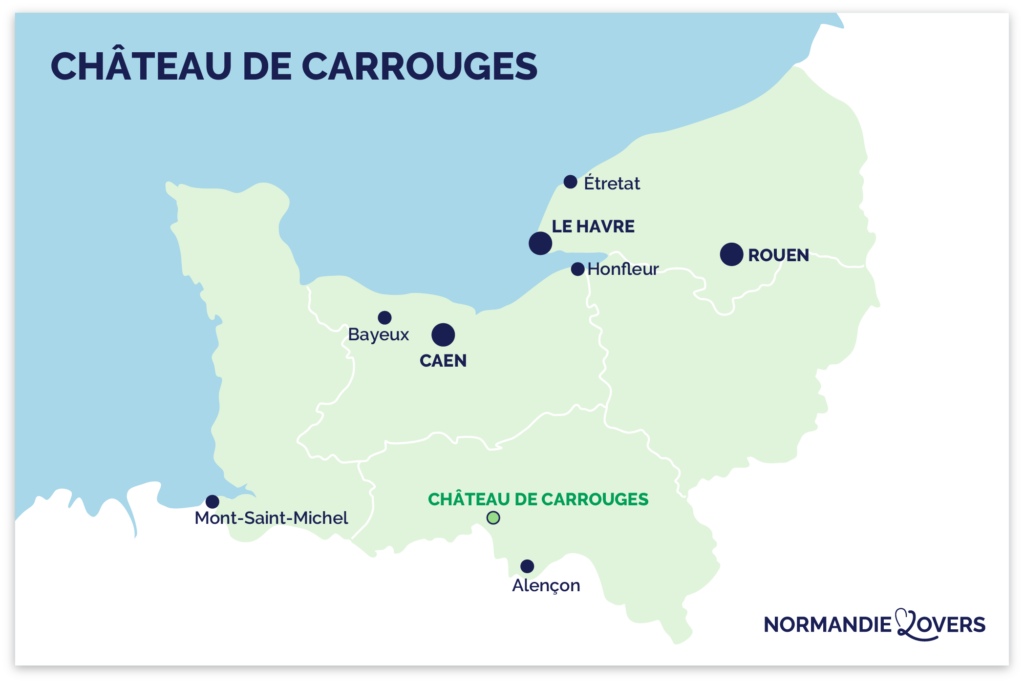
How to get there?
There are several ways to get to Château de Carrouges:
- By car: the easiest way. The site is well signposted from the village of Carrouges and very easy to get to.
- By bike: the château has the Accueil Vélo label! Carrouges lies on the Véloscénie cycle route linking Paris to Mont-Saint-Michel. Find out more here

OUR ADVICE FOR RENTING A CAR IN Normandy
- Compare prices on our preferred platform: DiscoverCars – one of the best rated sites.
- Choose a car that is comfortable enough (distances can be long) but compact (some parking lots and villages are narrow).
- Think of the complete insurance (some roads are tortuous and narrow).
- There is a lot of demand, book it early .
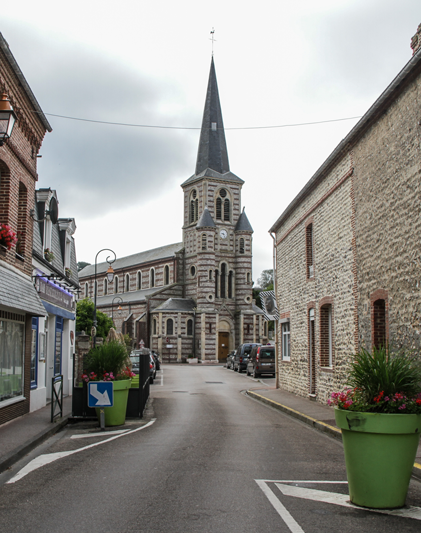
Useful tips: duration, schedules, eating…
Best time to visit.
Spring and autumn are particularly pleasant times to visit Château de Carrouges. The colors of the vegetation in the gardens and the surrounding Normandy countryside provide a magnificent backdrop for the red bricks.
Summer is obviously busier. We recommend visiting in the morning or late afternoon, for greater peace of mind and to take advantage of the slanting lights that add contrast to the imposing castle structure.
And don’t forget to check the weather forecast before you come – we’re in Normandy!

Length of visit and main difficulties
Allow 1h to 1h30 to visit the castle. Afterwards, you’re free to stroll through the park and enjoy its gardens and conservatory orchard.
The castle’s staircases are an architectural treasure trove. They can, however, make the experience difficult for people with reduced mobility. However, adapted routes are possible. Assistance schemes have also been set up. For more information, click here .
Dogs are allowed in the park, but not in the castle.

Advice on how to visit
Free tour documents are available at the château reception desk. They are available in 11 languages .
On our visit, once through the châtelet gate, we headed for the drawbridge. Today, it’s a standing bridge , with railings featuring magnificent ironwork. It leads to the fortress courtyard.
From here, we visited the keep , then climbed the staircase to the Chartrier tower, before entering the seigneurial dwelling on the second floor. We continued our visit in the more classical wings, from the central open staircase to the village hall .
At the time, this was the official meaning of the visit. It has since been modified. You can download the tour map in English, French or Spanish here , at the bottom of the page.

USE OUR GUIDE TO PLAN A DREAM TRIP TO Normandy
All the information you need for your trip:
- 8 maps that make planning easier
- 160+ pre-selected locations
- Practical advice
- 300+ photos to help you choose
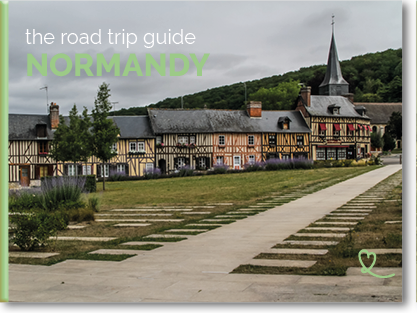
Visiting with children
From the age of 5 upwards, there are activities for the whole family to enjoy.
The 10-hectare park is ideal for stretching your legs, and you can picnic in the conservatory orchard. Find out more here .
Strollers are allowed in the park, and you can leave them in a dedicated area during your visit. A changing table is available in the courtyard toilets.

Schedules and rates
The castle is open:
- January to April and September to December : the castle from 10am to 12:30pm and from 2pm to 5pm the park from 10 a.m. to 5 p.m. On December 24 and 31, the site closes at 4pm.
- from May to August: the castle from 10am to 12:45pm and from 2pm to 6pm the park from 10 a.m. to 6 p.m. Last access 1/2 hour before site closes Closed on January 1, May 1, November 1 and 11 and December 25
Full price : €7 Free for children under 18
Check out the latest rates and the complete list of discount beneficiaries here .

Guided tours
Visits to the château are free of charge , with a tour document provided free of charge.
Conference tours are available, in French and English, for groups of 10 or more. They last around 1h30. Price: €9 per person.

From spring to autumn, the orchard picnic area with its view of the château is a real pleasure. Tables await you in the shade of the apple trees.
The château also offers 2 gastronomic get-togethers , on reservation:
- a visit to the château and a meal in the old bakery or guard room
- tour, lunch at the château, presentation of the park and Géoparc Normandie Maine, visit to the Maison du Parc and Poiré tasting.
See conditions and book here .

Subscribe to our Newsletter
- Get away from it all with Region Lovers’ beautiful destinations!
- Once a month
- Advertising-free

Start of tour: from Renaissance châtelet to original keep
Even before entering the castle, we were impressed by its red brick walls. They are emblematic of its robust yet elegant buildings.
The streamlined silhouette of the châtelet
The châtelet, with its slender towers and soaring roofs, looked like something out of a fairy tale. It is the gateway to the Parc du Château de Carrouges. It was built between 1505 and 1533. Underneath its Gothic appearance, however, it bears witness to the transition to the Renaissance . It is considered the first monument of this style in Normandy.

Brick was chosen because of the clay soils of the Carrouges marshes and, in the case of the châtelet, because of the revival of this material during the Renaissance. We loved the elegant backdrops it can create. They become increasingly visible as you get closer. They alternate red and black bricks.

The keep, core of the castle
Once you’ve reached the front of the château, you can clearly make out the massive silhouette of the keep. Built in the 14th century, this is the original château. Its construction was ordered by Charles V to make Carrouges a stronghold to defend the entrance to Normandy. Its arches and machicolations bear witness to this. We loved imagining Jean de Carrouges and his wife Marguerite. They were living there at the time of the last legal duel (1386) between Jean and his enemy, Jacques le Gris, accused of raping Marguerite.

The keep is built on 3 levels. On the first floor, the courtyard leads to the common room , which served as a kitchen. This is a central room in the life of the chateau. There’s a well and the famous Carrouges stone , which really intrigued us. This is a tithe stone (or royalty stone). It gave the Carrouges measure for liquids, flour or grain at fairs and markets.

Continuation of the tour: the Blosset medieval wing
We continued our visit upstairs via the Chartier tower staircase. This leads to the wing of the château that houses the Blosset-de-Saint-Pierre medieval dwelling. The layout is still as it was in the 15th century. The decor, on the other hand, was installed in the 17th century.
The opulent bedroom of Louis XI
At the time of the Blosset family, this room was known as a “chambre de parement “ . This is a more intimate room where VIP guests were welcomed. It was here that Louis XI spent the night of August 14, 1473, on his way to Mont-Saint-Michel . We loved the room’s warm, wood-panelled decor, tall fireplace and four-poster bed.

The apartments of the medieval dwelling
A small door leads to the north salon and then to the antechamber of honor , whose decoration we admired. The hood of its mantelpiece is painted with a magnificent hawk-hunting scene . It dates back to the 16th century. The carved motifs on the beams are superb. Tapestries, furniture and paintings enrich the décor, taking us back through the ages.

End of visit: the classic wings of a prestigious residence
The link between the 15th-century dwelling and the grand apartments is made by a square-plan central open staircase, which we loved. It was reserved for the distribution of private apartments and also allowed servants to pass through.
Large apartments
Once past the central open staircase, you pass through a succession of lounges. They are the work of architect François Gabriel . First there’s the dining room, then the summer lounge , whose intimacy we really appreciated. This is the smallest room on the floor. Its large-scale arabesque wallpaper and hand-printed fabrics are a marvel!

Next is the portrait salon , before moving on to the grand salon . It’s a bright corner room with light woodwork and 4 high windows overlooking the park. We liked its vast proportions. They were created in the 19th century by combining 2 former salons.

The honours of the village hall
Finally, the main staircase leads to the reception hall, which also serves the grand salon. Designed by architect François Gabriel, this staircase was originally plastered and painted with faux brick. Yielding to the fashion of the time, its walls were stripped bare when it was restored in the 1960s.

The Salle des Fêtes is the largest room in the château, and is the last room on the tour. It’s a former painting gallery that was later used for theater, music and dance. The musicians were housed in a lofty grandstand. The basket-handle ceiling paneling is a modern design. It dates back to the 80s. During our visit, we saw an exhibition by photographer Sabine Pigalle. Find out more here .

Frequently asked questions
What is the legend of jean de carrouges.
This is not a legend but a true story . Jean de Carrouges was one of the protagonists in France’s last judicial duel in 1386. He took on his former friend, Jacques Le Gris, in a single combat, to clear the honor of his wife, Marguerite de Thibouville, who accused Le Gris of raping her.
His story inspired American director Ridley Scott to turn it into a film: The Last Duel starring Matt Damon as Jean de Carrouges, Adam Driver as Jacques Le Gris and Jodie Comer as Marguerite de Thibouville. Find out more here .

Are there any special events or exhibitions at Château de Carrouges?
Yes, absolutely, the Château de Carrouges hosts many events within its walls: exhibitions, concerts, conferences … During our visit, we really enjoyed the exhibition by photographer Sabine Pigalle in the village hall. The works on display revisited famous portraits by Europe’s greatest Renaissance painters. To enhance your visit, we invite you to consult the château diary here .

Are the Maison du Parc and the Geopark accessible from the château?
The Maison du Parc naturel régional and the Géoparc Normandie-Maine are open from April 1 to October 31 and offer a wide range of activities. They are located halfway between the village of Carrouges and the castle. Their visit is included in some of the guided tours of the château. The store sells regional products. Find out more here .

PLAN YOUR TRIP TO Normandy
Inspiration destinations
- Deciding where to go in Normandy – the best destinations
- Our weekend ideas: best-of , romantic , unusual , seaside , luxury , family
- 16 seaside hotels in Normandy
- The most beautiful charming hotels in Normandy

- Best things to do in Normandy
- Best cities in Normandy
- Most beautiful beaches of Normandy
- Most beautiful villages of Normandy
- Best castles of Normandy
- Best abbeys of Normandy
- Read our complete guide to visit the Mont-Saint-Michel
- Discover the D-Day sites

- Where to stay in Normandy – best places and hotels
- See our tips for renting a car at CDG airport , Orly airport , Beauvais airport , Caen , Rouen , Bayeux …

SHE MADE THE TRIP Claire

SHE WROTE THE ARTICLE Sèverine
Region lovers' 10 commitments.
- Visit all the places we tell you about.
- For each city, stay in at least one hotel and visit the ones we recommend.
- For each city, eat in at least one restaurant, visit the ones we select.
- Pay all our invoices in full, refuse any partnership or sponsorship.
- Periodically update our articles, with the help of our readers.
- Enrich our articles with our first-hand experiences.
- Use 99% of our own photos
- Use digital tools in a reasoned and transparent way, feeding them with information verified on site.
- Provide information on the traveler/writer pairing that gave rise to the article.
- Tell you what we do, and do what we tell you!
Claire and Manu
Find out more about the team and our history.

SEARCH OUR SITE
Our multi-destination blogs.
Regionlovers.fr
ZigZagroadtrips.com
OUR OTHER REGIONS TO DISCOVER
LoireLovers.fr
CorsicaLovers.fr
ProvenceLovers.fr
CanariasLovers.com
CHANGE LANGUAGE
Discover the travel guide
Legal / Terms of use / Privacy policy
Terms and conditions of sale

Sign Up Today
Start your 14 day free trial today

History Hit Story of England: Making of a Nation
10 of the Most Striking Castles in Normandy
As one of the great historic regions of france, normandy is bursting with a number of stunning castles with equally compelling histories to match. here's our pick of 10 of the best..

Lucy Davidson
27 aug 2021, @lucejuiceluce.
Known for its First World War beachheads and white cliffs, any visit to Normandy is enriched by its fantastic local culture, food , and history. Many of its historical sites dotted across the region date back to when Normandy was a powerful Dukedom during the Middle Ages which, like Burgundy, rivalled in power and prestige to the kingdom of France. The Hundred Years’ War ravaged the region, and left behind it a number of castles which are now popular visitor attractions.
From the picturesque Falaise Castle and the imposing Mont Saint-Michel to the historic Gaillard Castle, the Castles of Normandy are absolutely mind-blowing places to discover. Here’s our pick of 10 of the best castles to jumpstart any adventure in Normandy.
What are the best Castles in Normandy?

1. Falaise Castle
Falaise Castle is a fortress located in the south of the commune of Falaise in Normandy, France . William the Conqueror , the son of Duke Robert of Normandy, was born at an earlier castle on the same site in about 1028.
Construction was started on the site of the earlier castle in 1123 by Henry I of England. In about 1207, after having conquered Normandy, King Philip II of France ordered the building of a new cylindrical keep. Possession of the castle changed hands several times during the Hundred Years’ War . The castle was abandoned during the 17th century. Since 1840 it has been protected as a monument historique.

2. Mont Saint-Michel
Mont Saint-Michel is an imposing historic village in Normandy, France, which dominates the skyline from its position atop a small rocky island. Joined to the coast via a causeway, Mont Saint-Michel is best known for its Benedictine Abbey and Parish Church.
Today, visitors flock to Mont Saint-Michel to view the remarkable Abbey and Church and to stroll through its ancient streets. Many other sites remain, including the medieval ramparts, the Mont Saint-Michel Museum of History, a Maritime Museum, and the 14th century Tiphaine’s house.

3. Chateau de Pirou
The picturesque Chateau de Pirou in Normandy is one of the oldest Norman castles in existence and is now a popular attraction. The site has been occupied since the 9th century, although at that time it was a wooden construction and was updated to stone in the 12th century.
It was built to defend the nearby harbour. Surrounded by a moat, with granite towers and turrets, and defended by five gates, Chateau de Pirou is simply a wonderful building, constructed just as we might imagine a fortified castle would be built. It was built by the Lords of Pirou, one of whom found favour with William the Conqueror during the Battle of Hastings , and was rewarded with an estate in Somerset. During the Hundred Years War, Pirou came under siege numerous times, and ownership of the castle changed on many occasions. It is possible to walk up to the ramparts and walk along the castle walls, which provides excellent views.

4. Gaillard Castle
Gaillard Castle is a ruined medieval castle, located above the commune of Les Andelys in Normandy, France. Construction began in 1196 under the auspices of Richard the Lionheart . It has a complex design, and uses early principles of concentric fortification; it was also one of the earliest European castles to use machicolations.
The castle changed hands several times in the Hundred Years’ War, but in 1449 the French captured the castle from the English king definitively, and from then on it remained in French hands. The inner bailey is open to the public from March to November, and the outer baileys are open all year.

5. Creully Castle
The Château de Creully is an 11th-century castle in Normandy. The castle has been modified throughout its history. In around 1050 it did not resemble a defensive fortress but a large agricultural domain. In around 1360, during the Hundred Years War, it was modified into a fortress. During this period, its architecture was demolished and reconstructed with each occupation by the English and the French.
At the end of the war, ownership of the castle returned to baron de Creully. Twenty two barons of the same family had succeeded to the castle between 1035 and 1682. In 1682, the last baron of Creully, Antoine V de Sillans, heavily indebted, sold the castle to Jean-Baptiste Colbert, minister of Louis XIV , who died the following year without living there. Descendants of Colbert occupied Creully until the French Revolution in 1789, when it was confiscated. The castle’s large halls are used today for various events, including weddings, concerts, exhibitions and conferences.

6. Châteauneuf-sur-Epte Castle
The ruined castle of Châteauneuf-sur-Epte is in the commune of Château-sur-Epte in Normandy, France. Construction started around 1097 by William Rufus, King of England, to reinforce the frontier along the Epte river. The castle occupied a site on the border between the Duchy of Normandy and the Kingdom of France.
The castle’s role declined in the 16th century and it was ordered to be dismantled in 1647. Today the ruins are private property.

7. Caen Castle
The Château de Caen is a Norman built around 1060 by William the Conqueror. His son Henry I then built the Saint George’s church, a keep and a large hall for the ducal Court.
Today, the castle serves as a museum that houses the Museum of Fine Arts of Caen, the Museum of Normandy and the Exchequer of Normandy.

8. Château de Courcy
The Château de Courcy is a ruined castle in Normandy typical of 12th-13th century military architecture.
At the start of the 17th century, it was demolished by order of Richelieu and, losing all military function, slowly became an agricultural enterprise. The condition of the site has continued to deteriorate and very little survives today.

9. Château de Conches-en-Ouche
The Castle of Conches-en-Ouche is a ruined fortress in Normandy which was largely demolished in the 16th century. Construction dates back to 1034 and the castle was captured by Philip II of France in 1199.
Conches-en-Ouche Castle was the target of bitter fighting during the Hundred Years’ War and changed hands several times before being finally taken by the French in 1449. In 1591, members of the Catholic League took refuge there; seen as a potential base for enemies of the monarchy, it was demolished soon afterwards.

10. Colombières Castle
The Château de Colombières is a medieval castle built during the 14th century in Colombières, Calvados, Normandy. Located between Bayeux and Isigny-sur-Mer, near the Landing Beaches, the Château de Colombières is one of the most notable of Normandy at the time of the feudal military fortresses.
Today, Count Etienne de Maupeou d’Ableiges and his children will tour you around their prestigious residence.

Castles in Normandy
Normandy has not only been at the centre of France’s history for centuries but Europe’s too. It’s where William the Conqueror set sail for England from, and some of the most fearsome battles of World War Two took place on its beaches.
The landscapes are dotted with pretty towns such as seaside Honfleur, Rouen and its cathedral, and the extraordinary offshore monastery of Mont Saint Michel.
This charming region of northern France has some of the most evocative places in the country. In this post, we’ll take you to some of the most fascinating and beautiful castles in Normandy.
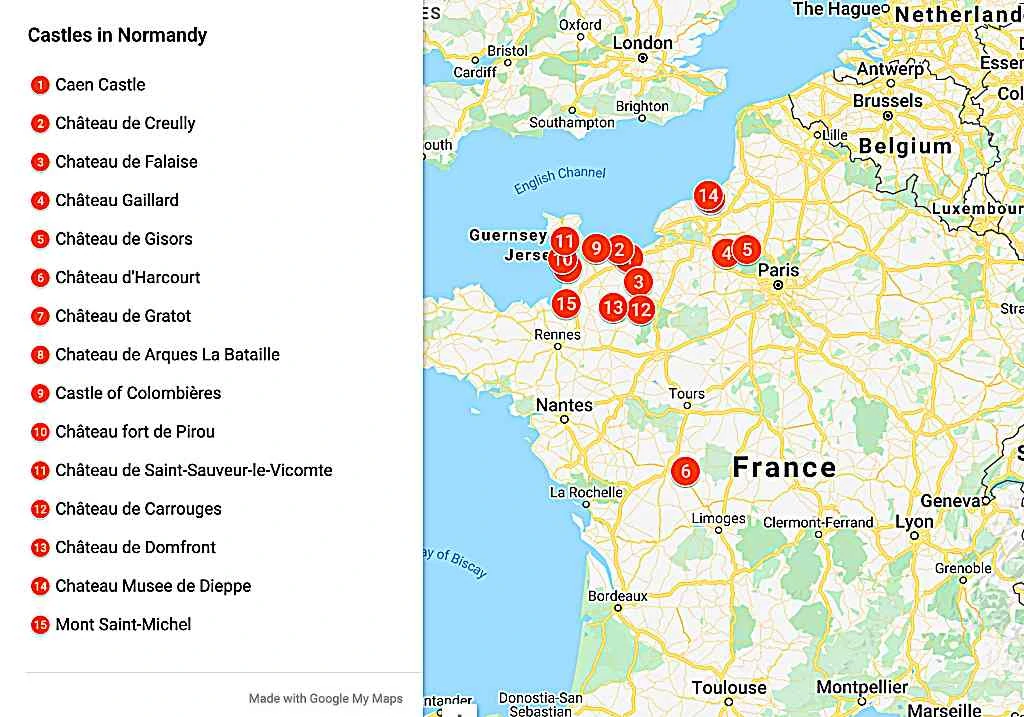
15 Castles to Visit in Normandy
1. chateau de caen.
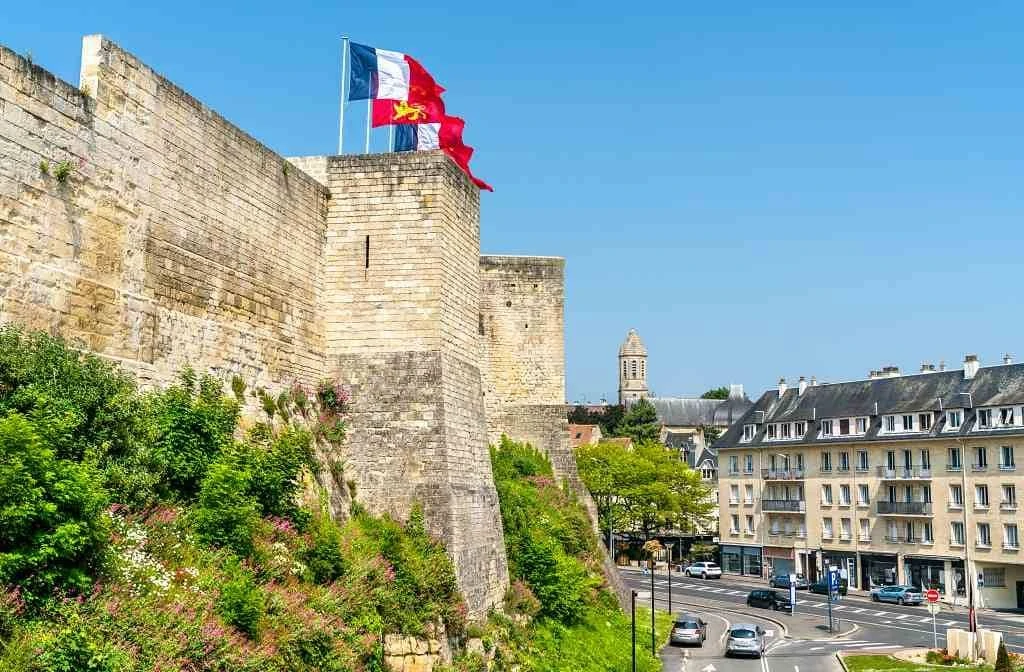
Built atop the fortress of William the Conqueror, Château de Caen is one of the largest medieval enclosure castles in Europe. It has been at the forefront of many battles over the years, with the English occupying it during the Hundred Years’ War.
From the castle, there are a number of impressive views of the city of Caen. There’s also a medieval medicinal garden and an underground area called the Rampart Rooms. Now, the castle is home to two of the most important museums in the region – the Museé de Normandie and the Museé des Beaux-Arts.
Where: Caen When: 11 th century Open for Visit: Yes. check here for more information.
2. Chateau de Creully

This feudal castle was built over centuries, beginning in the medieval period. It’s located between the cities of Caen and Bayeux and consists of a medieval enclosure with vaulted rooms and a square tower.
A Renaissance turret was added later. The castle played an important role in the D-Day landings of the Allied Troops in Normandy, with the square tower becoming the headquarters of the BBC until 1944.
Where: Creully-Sur-Seulles When: 11 th – 15 th century Open for Visit: Yes. Check here for more information.
3. Chateau de Falaise
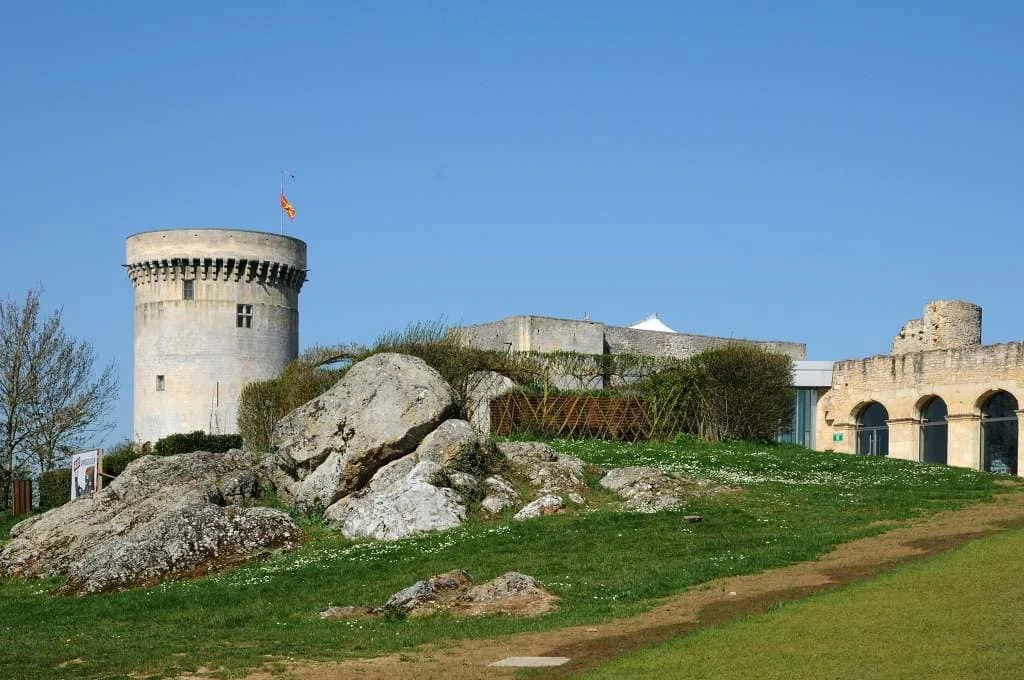
Also known as Château Guillaume le Conquerant (William the Conqueror’s castle), Falaise is the birthplace of the man who marched on the United Kingdom.
The original castle here was built by a Viking chieftain in the 10 th century, but what you are able to see today is a couple of centuries newer than that. It is perched atop a rocky crag – falaise actually means cliff in French. The town of Falaise was badly damaged in the Second World War, but the castle is well maintained and preserved.
Where: Falaise When: 12 th – 13 th century Open for Visit: Yes. Check here for more information.
4. Chateau Gaillard
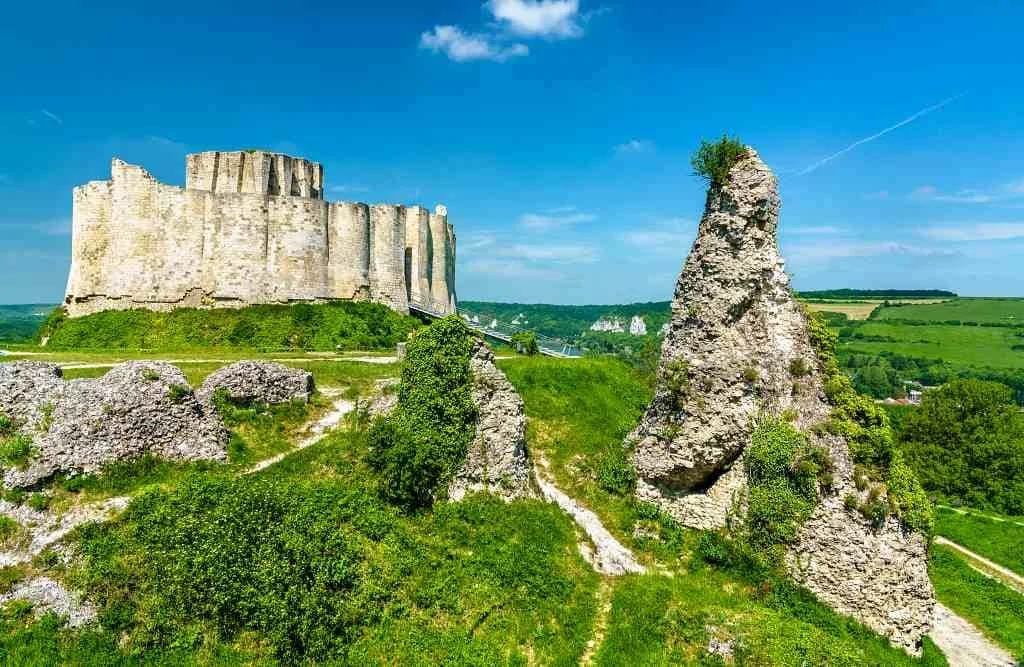
Perched on a cliff overlooking the Seine River, Château Gaillard is considered a medieval military masterpiece. Built by Richard the Lionheart in the 12 th century in Les Andelys, it is one of the earliest examples of a concentric fortification .
A castle of this size would usually take around ten years to build, but this one took two. Despite that, the stronghold stood for centuries before Henry IV of France ordered its demolition in 1599. Nowadays, the castle is in a ruinous state, but it still has exquisite views of the Seine River and surrounding landscapes.
Where: Les Andelys When: 12 th century Open for Visit: Yes. Check here for more information.
5. Chateau de Gisors
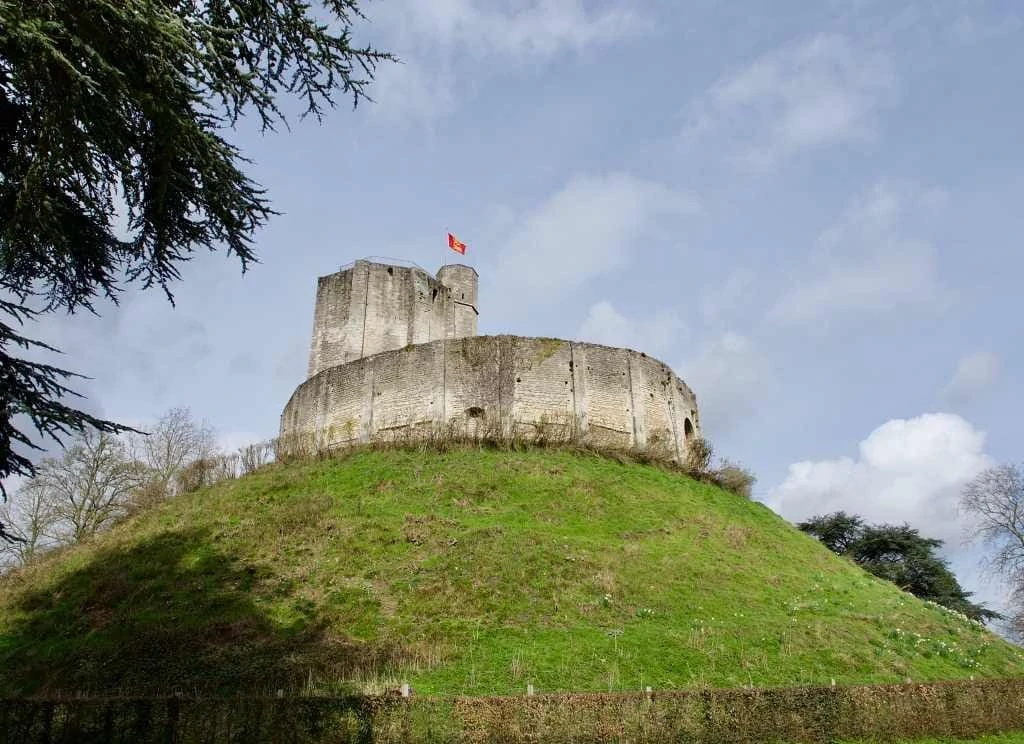
One of the most important fortresses for the Dukes of Normandy, Château de Gisors was built in the 11 th century. Initially, it was a wooden keep upon a 15-metre motte, but it was reinforced in the following century with a circular stone curtain wall.
Local legend says that the castle is the hiding place of the treasures of the Knights Templar. In the middle of the 20 th century, digging took place, but as yet, the treasure has not been found.
Where: Gisors When: 11th century Open for Visit: Yes. Check here for more information.
6. Chateau d’Harcourt
Château d’Harcourt is one of the best-preserved castles in France and is home to the oldest arboretum in the country. It is an excellent example of medieval architecture; however, it was remodelled in the 14 th and 17 th centuries.
The castle is surrounded by a large curtain wall and a double ditch, so it’s set up very well to defend against attacks. To learn more about the site, there is a permanent exhibition in the castle, while the arboretum is a lovely place for a walk; it was added to the castle in 1802.
Where: Chauvigny When: 12 th century Open for Visit: Yes. Check here for more information.
7. Chateau de Gratot

This castle’s four towers that were built from the 13 th to 18 th centuries are safely surrounded by a large moat. Set among the fields of the Norman countryside, Château de Gratot is the home of a mesmerising legend.
Long ago, the Lord of Argouges supposedly spotted a young lady swimming in a refreshing forest pool. She happened to be a fairy. He was never to mention death in front of the fairy – who became his wife – and for years, all was well. However, when he finally did, she is said to have flown out of the window in one of the castle’s towers.
Where: Gratot When: 14 th century Open for Visit: Yes, click here for more information .
8. Chateau d’Arques-la-Bataille
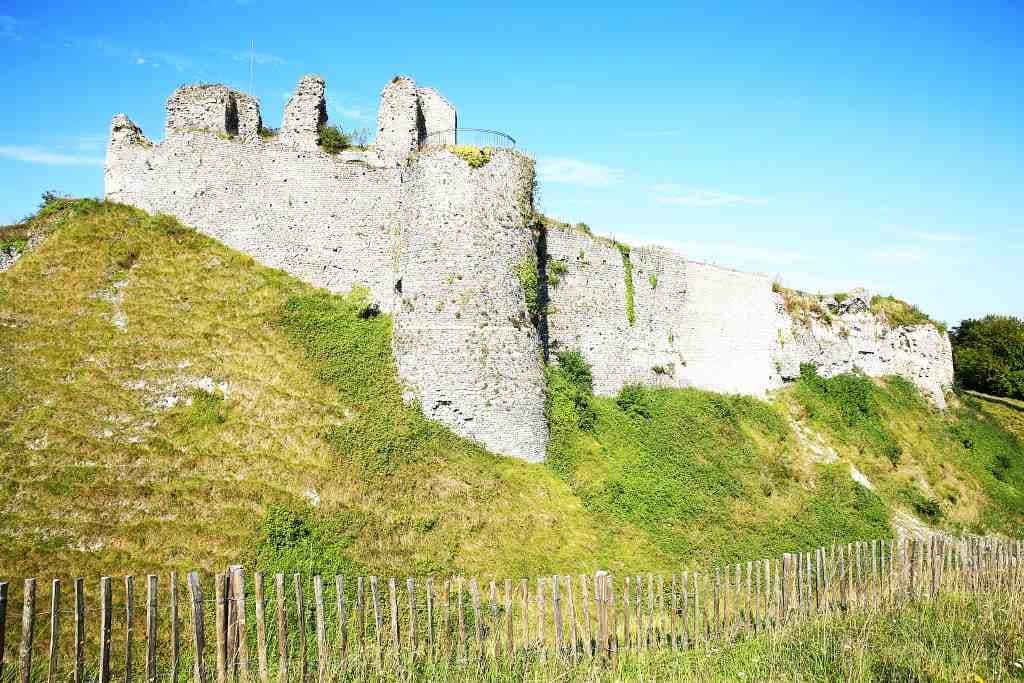
It was here that one of the most important battles in Norman history took place, but nowadays, it’s a bit of a hidden gem in the La Varenne Valley. It stands on a rocky outcrop, and there was a building here before the 12 th -century structure.
Originally, the castle was intended for Count William of Talou, the uncle of William the Conqueror. Their relationship was not close though, and uncle deserted nephew in the middle of the Battle of Domfront in 1049.
Where: Arques-la-Bataille When: 12 th century Open for Visit: No. The fortress is closed as the ruins are unstable. But you can view from outside!
9. Chateau de Colombières
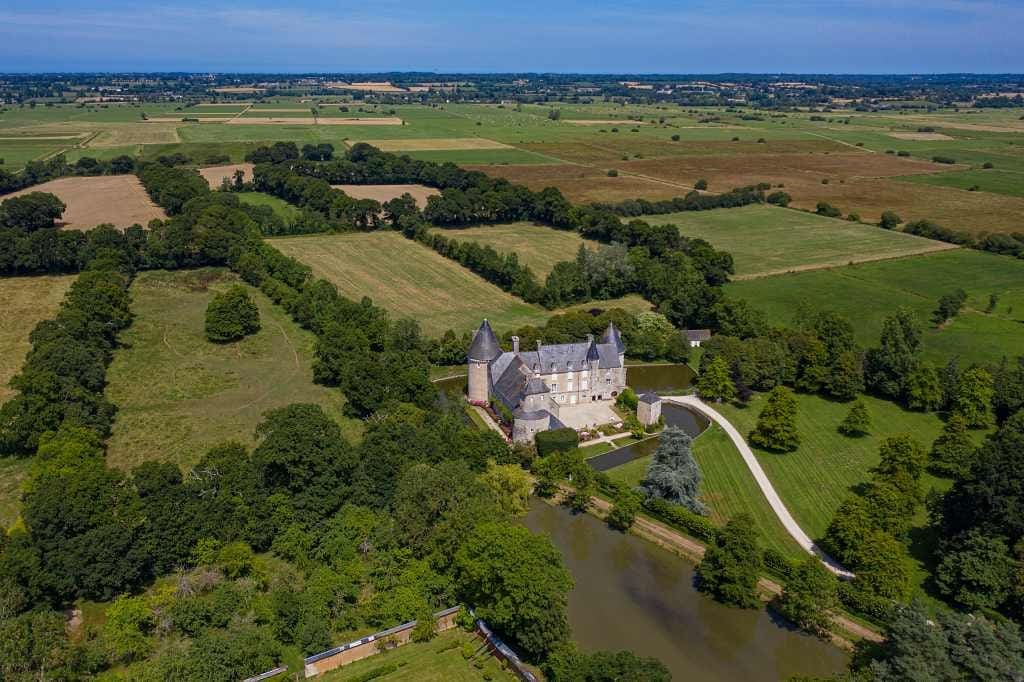
Hidden away in the Regional Natural Park of the Cotentin and Bessin Marshlands, Château de Colombières is known as the watchtower of the marshlands and played an essential role in World War II.
Its history goes way back though, with it being one of the most important and finest military fortresses during France’s feudal period. The 14 th -century castle has a number of round towers, a moat, and beautifully kept gardens. Nowadays, you can stay overnight in the castle as it’s a bed and breakfast.
Where: Colombières When: 14 th century Open for Visit: Yes. The castle is a bed and breakfast, but you can arrange a guided tour to see it and learn about its history. Check here for more information.
10. Château de Pirou

The Château de Pirou’s initial incarnation was a wooden castle, supposedly made by fairies – at least, according to legend. What is certain is that it was home to the Lords of Pirou. It is built upon an original Viking site and saw many sieges over the years.
The main part of the castle, which is built on an island, has been conserved. It is, in fact, a farm within five defensive gates. Since 1966, the castle has been being restored. Now you can visit and enjoy not only the castle itself but a gift shop selling local products.
Where: Pirou When: 12 th century Open for Visit: Yes. Check here for more information .
11. Château de Saint-Sauveur-le-Vicomte
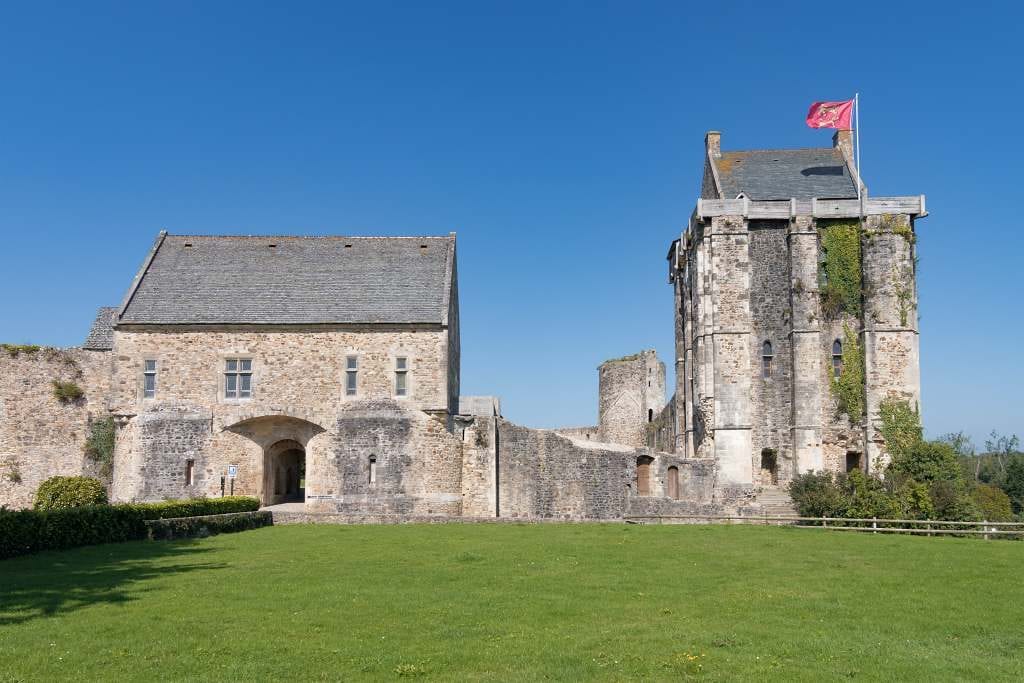
This imposing castle was besieged twice in the Hundred Years’ War, but it still retains much of the original structure. There is a fortified enclosure, 12 th and 14 th -century towers, and a dungeon.
It lies on the banks of the River Douve and has been listed as a French monument historique since the year 1840. The castle is located in the village of the same name.
Where: Saint-Sauveur-le-Vicomte When: 11 th and 12 th centuries Open for Visit: Yes. Check here for information.
12. Château de Carrouges
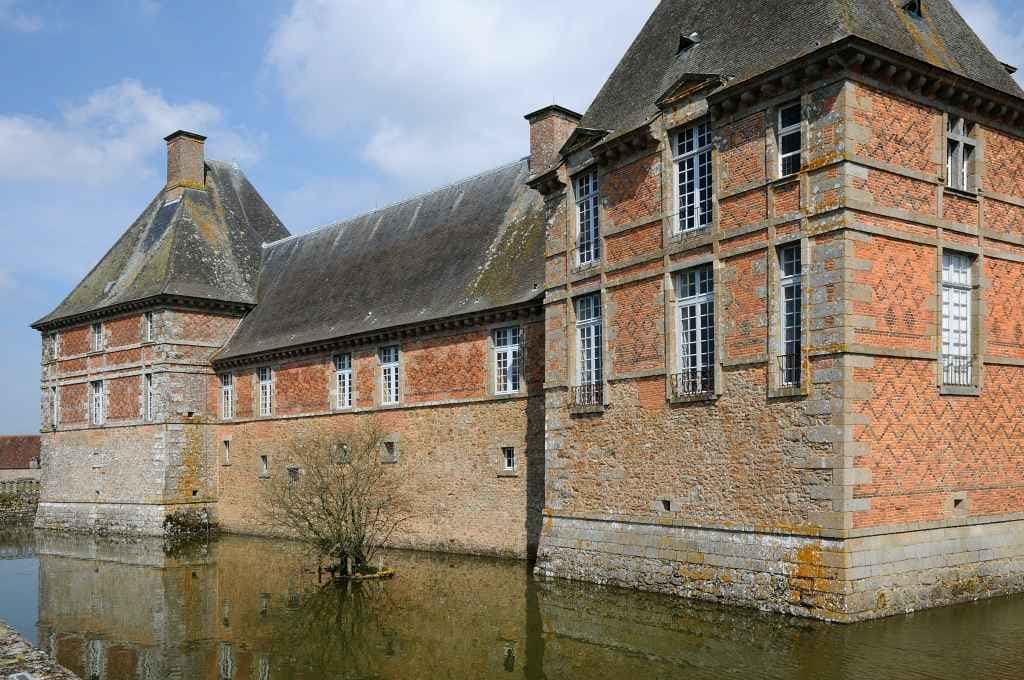
Built from brick, slate, and granite between the 14 th and 17th centuries, Château de Carrouges lies in the heart of the Normandie-Maine Regional Nature Park. Unlike many of the medieval castles in Normandy, Carrouges is an example of French Renaissance architecture.
Inside, there is a Louis XI Chamber (which is where the king stayed for one night in the 15 th century) and a Portraits salon with images of all the château’s owners.
Where: Carrouges When: 14 th century Open for Visit: Yes. Click here for more information.
13. Château de Domfront
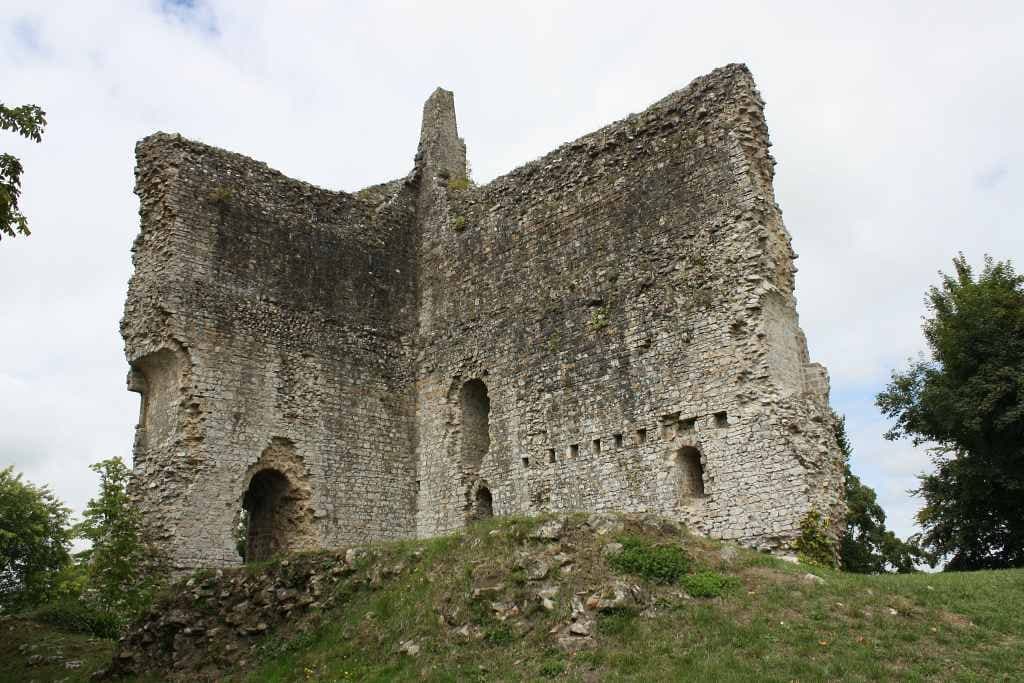
When strolling through one of the public parks of Domfront en Poiraie, it’s hard to imagine a medieval battle taking place there, but that’s exactly what happened in 1051 when it was besieged by William the Conqueror.
There has been a whole other castle built on the site since then, with the current vestiges dating back to the 12 th century when it was built by Henry Beauclerc. What you can see are the remains of a keep and chapel.
Where: Domfront en Poiraie When: 12 th century Open for Visit: Yes. The ruins are in a public park, and there is no entry fee.
14. Château de Dieppe
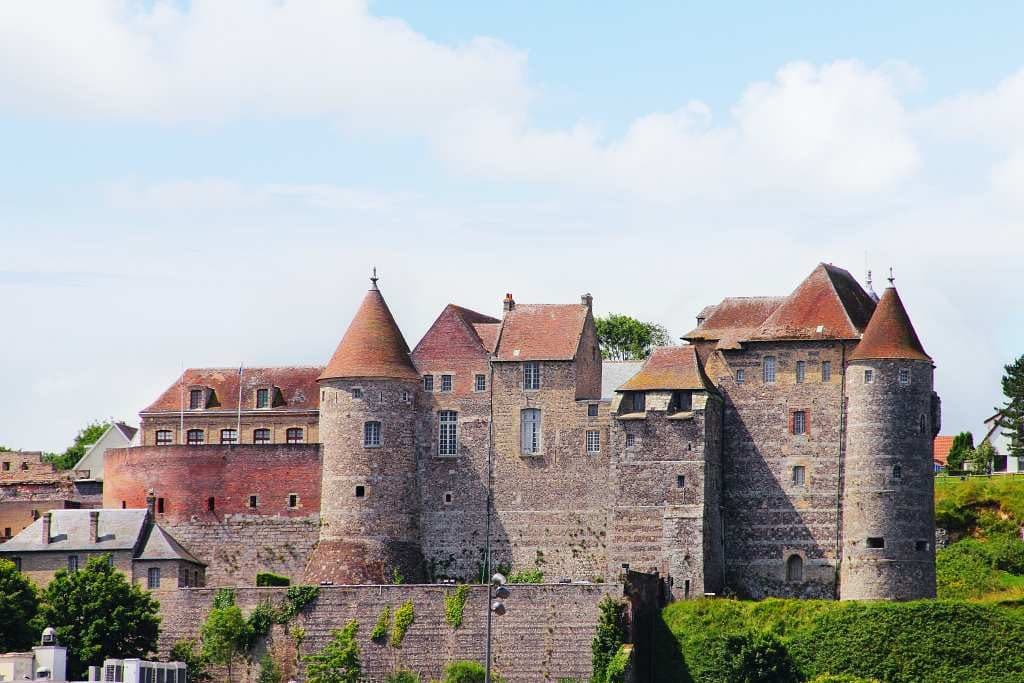
Now the museum of Dieppe, the city’s castle faces out to the English Channel and would have been one of the first lines of defence against invaders from the British Isles.
A castle was founded on the site in 1188 by King Henry II of England, but that was destroyed only seven years later. The current building dates back to the 14 th century. As a museum, it holds furniture, art, and the largest collection of ivory in Europe.
Where: Dieppe When: 14 th century Style: Several architectural styles Open for Visit: Yes.
15. Μont Saint-Michel
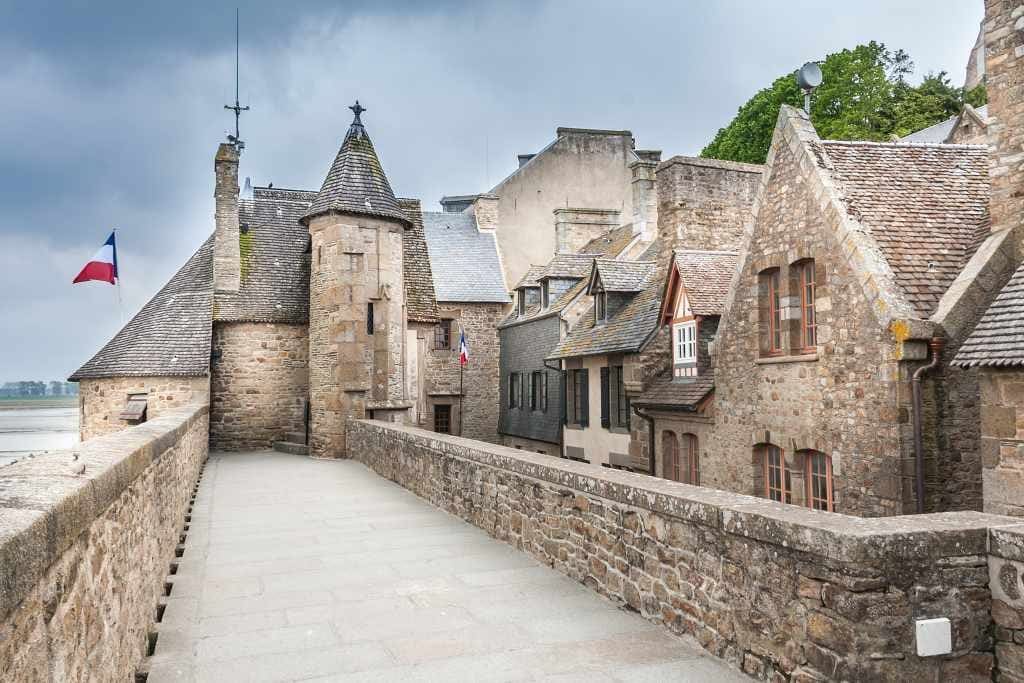
Although Mont Saint-Michel is not technically a castle, this fortified tidal island of the Normandy Coast is one of the most impressive sights in France.
The city dates back to the 13 th century, but the monastery is around 500 years older. Visiting the island is one of the top things to do in Normandy; it’s easy to spend a day wandering around the village, which is like no other in the world!
Where: Avranches When: 13 th century Style: Gothic Open for Visit: Yes, but make sure to check the tides before crossing over.
Leave a Comment Cancel reply
Save my name, email, and website in this browser for the next time I comment.

The 14 Most Beautiful Castles in Normandy, France
By catherine - March 1, 2019

Castles are popular destinations for all kinds of world travellers. If you love to marvel at architecture from eras gone by, experience history first hand, or simply stroll through unique locations, the castles of Normandy, France are excellent choices.
However, the Normandy castle options are also plentiful, and many travellers just don’t have time to see them all. By focusing on castles that genuinely capture the feel of the region and are remarkable landmarks for historical periods, you can make the most of the time you do have while visiting.
Table of Contents
Where is Normandy, France?
1. chateau de caen, 2. chateau de creully, 3. chateau de falaise, 4. chateau gaillard, 5. chateau de conches-en-ouche, 6. chateau de gisors, 7. chateau d’harcourt, 8. chateau de gratot, 9. donjon de chambois, 10. chateau d’arques-la-bataille, 11. chateau d’orcher, 12. chateau de rouen, 1. hotel chateau de sully, 2. chateau de canisy.
One of 18 regions in the country and historically referred to as the Duchy of Normandy, the Normandy area of France is located in the northwestern section of the country. A significant portion of Normandy borders the English Channel, and the region featured heavily in battles during the Hundred Years War as well as World War II.
During the Hundred Years War, many castles near Normandy, France, were fortified, ensuring they could serve as strongholds during battles. This allows them to be monuments to architectural styles across several centuries, allowing you to see how the locations grew and changed over time.
The Most Beautiful Castles in Normandy
There are numerous castles in Normandy, France, and you could easily justify making a trip to nearly all of them. However, some are more striking than others or play more significant roles in history, increasing the odds that they should land on your must-see list if you want to experience the most beautiful castles Normandy has to offer.
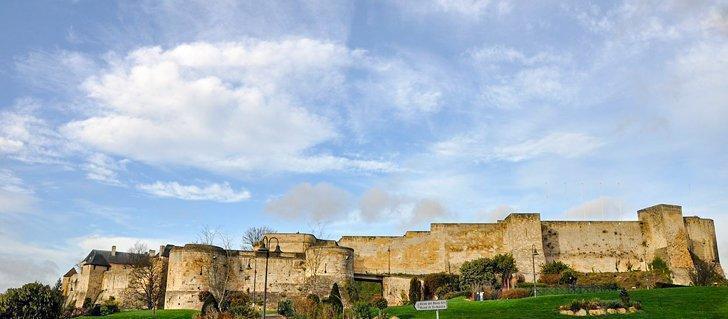
[Photo via Benoit-caen [ CC BY-SA 3.0 ], via Wikimedia Commons ]
Today, Chateau de Caen is home of the Musee des Beaux-Arts de Caen (the Museum of Fine Arts of Caen) and the Musee de Normandie (the Museum of Normandy). Saint George’s church, built by Henry I, William the Conqueror’s son in 1123, is also on site.
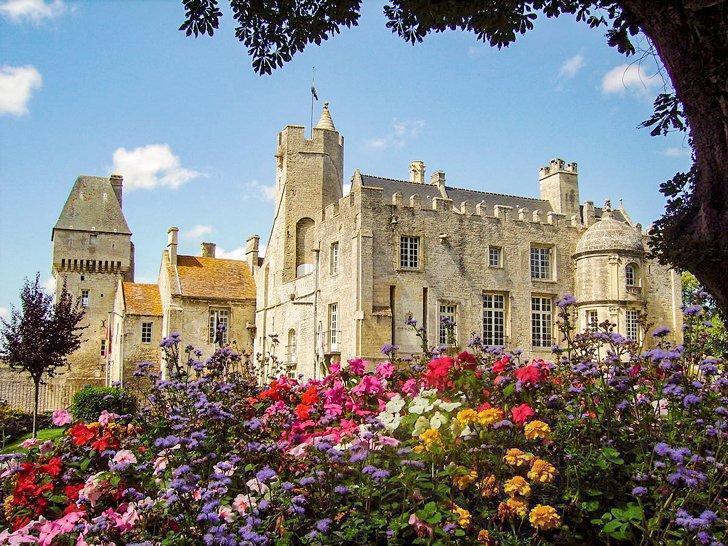
[Photo via By elfabriciodelamancha – Creully, Public Domain, Link ]
Even with numerous changes over the years, the structure is absolutely breathtaking today. Plus, during warmer months, it is surrounded by colourful flowers, making the natural stonework even more wonderous to behold.
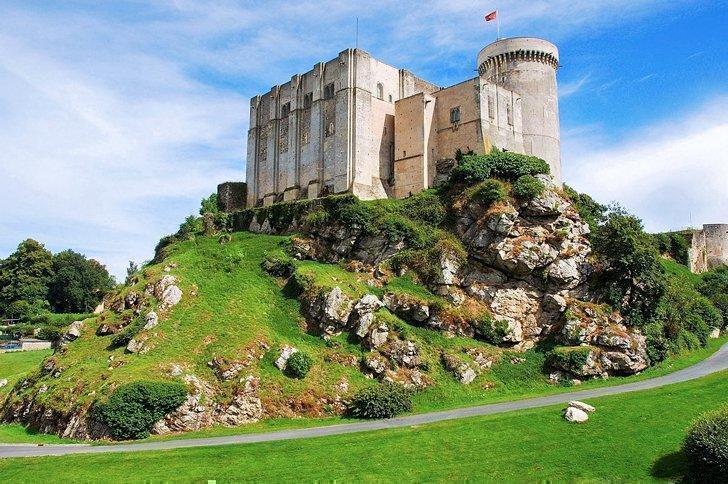
[Photo via By Viault – Own work , CC BY-SA 4.0 , Link ]
Featuring a fortress design and quintessential tower today, it is a must see for anyone visiting the region. Plus, it was listed as a historical site in 1840, and even sustained some damage during World War II (though three keeps remained untouched), making it ideal for history buffs.

[Photo via By Anabase4 – Own work , CC BY-SA 3.0 , Link ]
Chateau Gaillard is one of the earliest castles in Europe to use machicolations, the openings in the wall that allowed those inside to pour hot oil, release boiling water, or drop stones on attackers.
The outer baileys remain open to the public all year while the inner bailey can only be visited between March and November.

[Photo via By Eponimm – Own work , CC BY-SA 4.0 , Link ]
Members of the Catholic League took refuge at the site in 1591. Since it severed as a possible base for enemies of the crown, it was demolished in the 16 th century, though some of the structure remains.
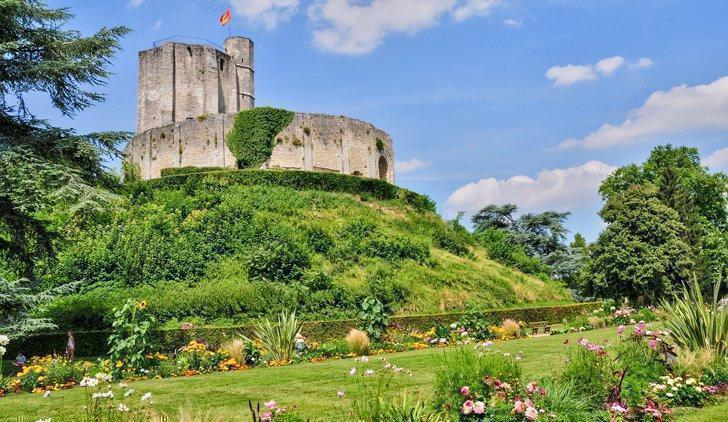
[Photo via Deposit Photos]
Some of the initial structure was constructed in 1095. Reinforcement work was performed in 1161, converting some wooden portions of the structure to stone. The octagonal keep is thought to be one of the best-preserved examples of a shell keep in Europe.

[Photo via Jacky Delville [ CC BY-SA 4.0 ], via Wikimedia Commons ]
However, modernization in the 17 th century saw segments of the original design demolished to make the site more habitable, allowing light to enter living spaces. However, it is still a wonder and was listed as a historic site.

[Photo via Selbymay [ CC BY-SA 4.0 ], via Wikimedia Commons ]
Numerous towers and buildings were constructed on the site over the years, and an excellent exhibit near the entrance chronicles the “Eight Centuries of Life,” detailing the castle’s history and various restoration projects. Artistic events are also frequently hosted at Chateau de Gratot, along with an annual theatre production, allowing it to serve as a cultural center in the region.
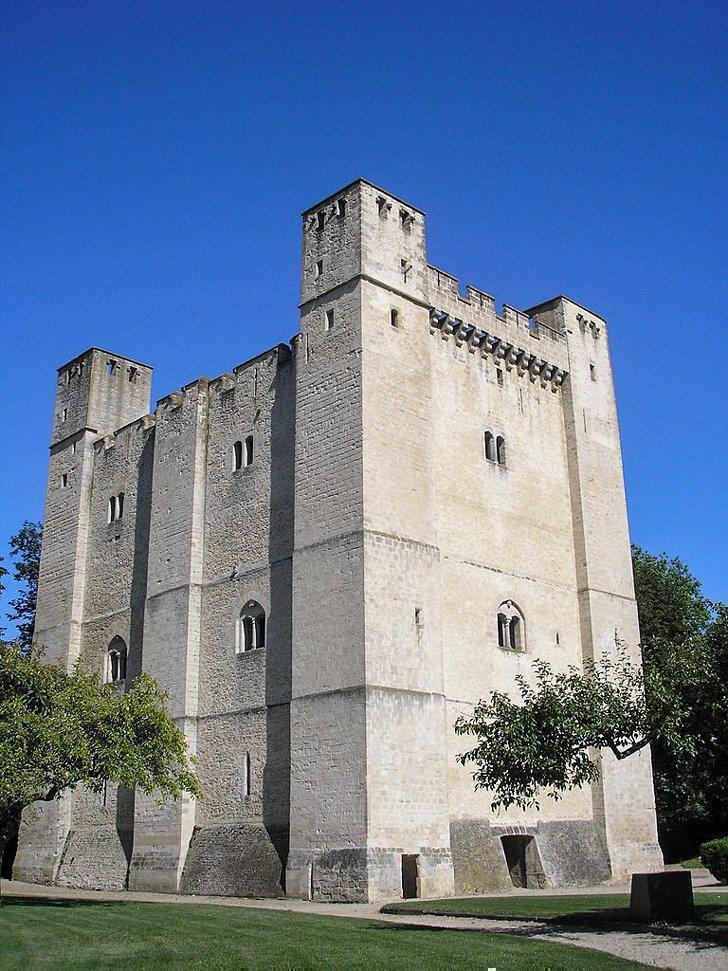
[Photo via Ikmo-ned [ CC BY-SA 3.0 ], via Wikimedia Commons ]

[Photo via © Raimond Spekking & Elke Wetzig, via Wikimedia Commons ]

[Photo via Urban~commonswiki]
The castle was transformed into a residence in the 18 th century but remains open to the public all year-round. Some areas, including the tower, have been restored over the years, most notably by architect P. Philippon in 1857.
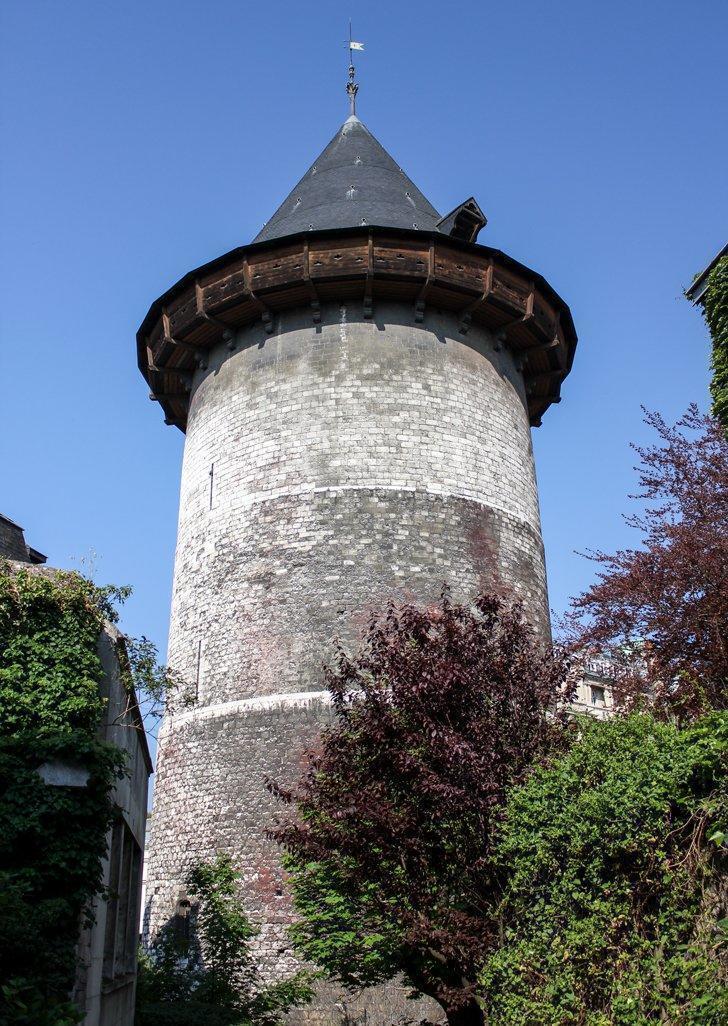
[Photo via Pierre-Yves Beaudouin [ CC BY-SA 3.0 ], via Wikimedia Commons ]
Castle Hotels in Normandy, France
If you want to do more than visit a castle in Normandy, you are in luck. Some properties allow guests to book rooms in buildings that date back several centuries.
Guests at the Hotel Chateau De Sully can take in the magnificent 17 th -century architecture while still being able to enjoy modern amenities. The location is incredibly stately, and those who stay on site have easy access to Bayeux city center and Omaha Beach .
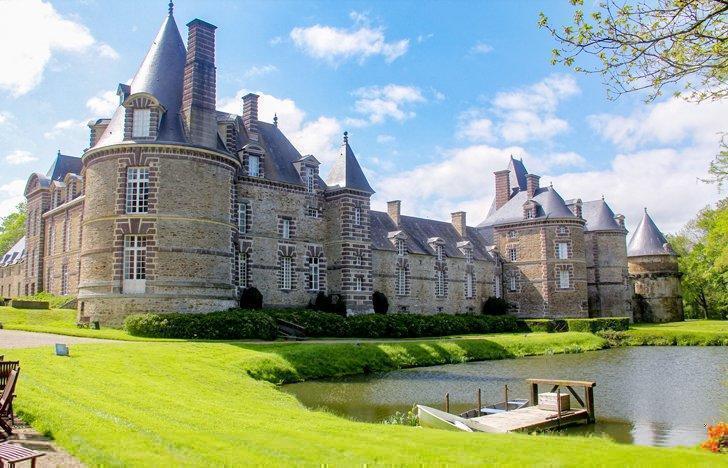
[Photo via By Elgaard – Own work , CC BY-SA 3.0 , Link ]
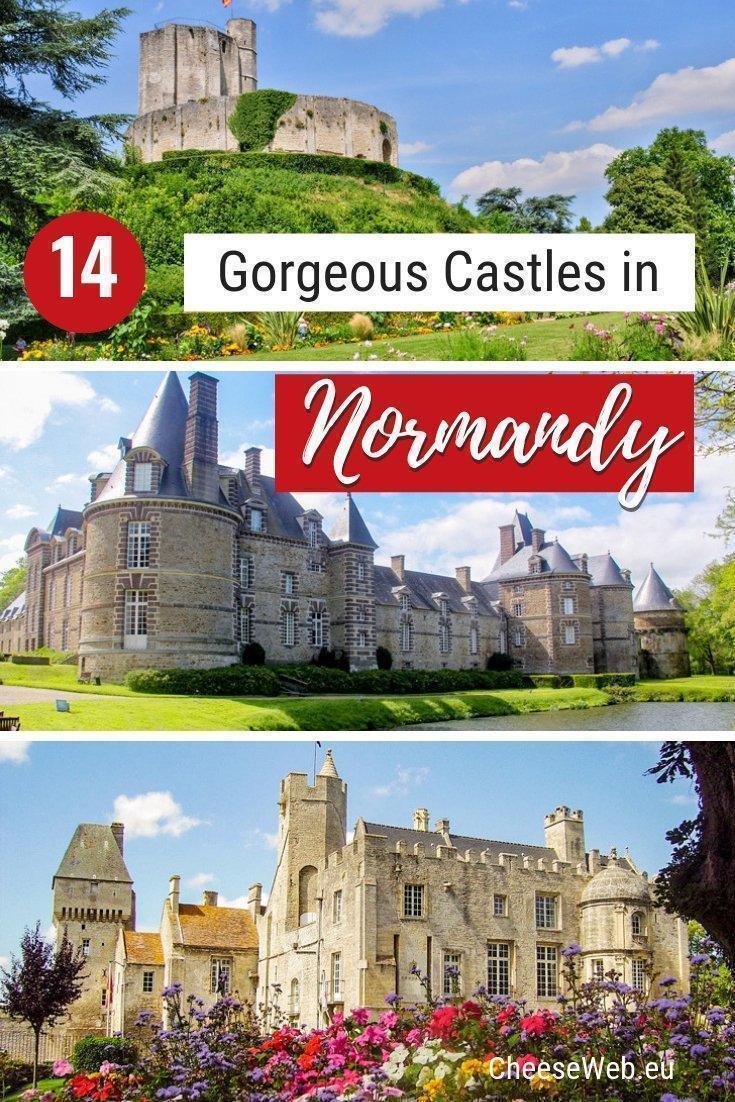
Like this article? Save it to Pinterest!
- Recent Posts
- The Ultimate Guide to Ramstein Germany - February 2, 2020
- The Best Things to Do in Siena Italy - January 10, 2020
- The Best Things to Do in Munster Germany - October 22, 2019
Best Castles in Normandy, France
Article written by Elisa This article may contain compensated links. Please read disclaimer for more info.
One of the best places to visit in Northern France , the region of Normandy is known for its coastline, culinary delights, and historical sites, dating back to the Middle Ages and beyond. One sign of all this history is the many impressive Normandy castles, many of which experienced the Hundred Years’ War .
The castles in Normandy are some of the most beautiful and well-preserved castles in France and are must-sees on any trip to the region. If you’re ready to experience the history and majesty of this part of the world, then here’s a list of the best castles in Normandy.
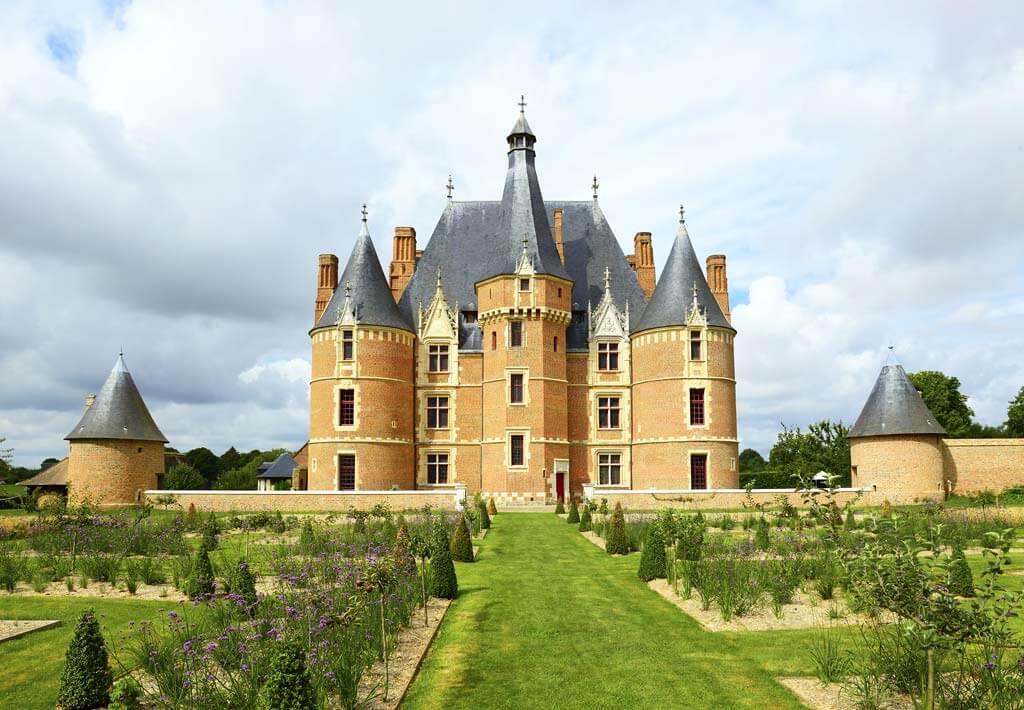
TIP: What is a château? Learn the difference between a château and a palace in France.
Best Normandy Castles
Here’s the list of the most beautiful Castles of Normandy. Mont-Saint Michel is not on the list because it is not a castle but a fortified abbey. You can find more information in our Mont-Saint Michel guide .
1. Château de Saint-Germain-de-Livet (Aude)

Château de Saint-Germain-de-Livet is located just 7km from Lisieux in the foothills of one of Normandy’s valleys. It’s nicknamed ‘The Wonder of the Pays d’Auge’, and was built during the 15th and 16th centuries on the grounds of a previous medieval fortress.
This Normandy castle is partially listed as a Historical Monument and was built by the Tournebu family, more precisely for the homesick Italian wife of one of the family. This architectural gem is surrounded by a moat complete with majestic swans and comprises a 15th-century half-timbered manor house in glazed brick and stone arranged in a checkerboard design. The interior is fully furnished.
Château de Saint-Germain-de-Livet is a slightly whimsical, romantic château surrounded by formal gardens and stunning countryside. You can see the Italian influence in the lovely courtyard arches. The 360 views of the castle from the garden are simply spectacular.
VISITS: Tuesday to Sunday from 11 am to 1 pm and 2 pm to 6 pm (Open from April to the 1st weekend of November).
2. Château Gaillard (Eure)
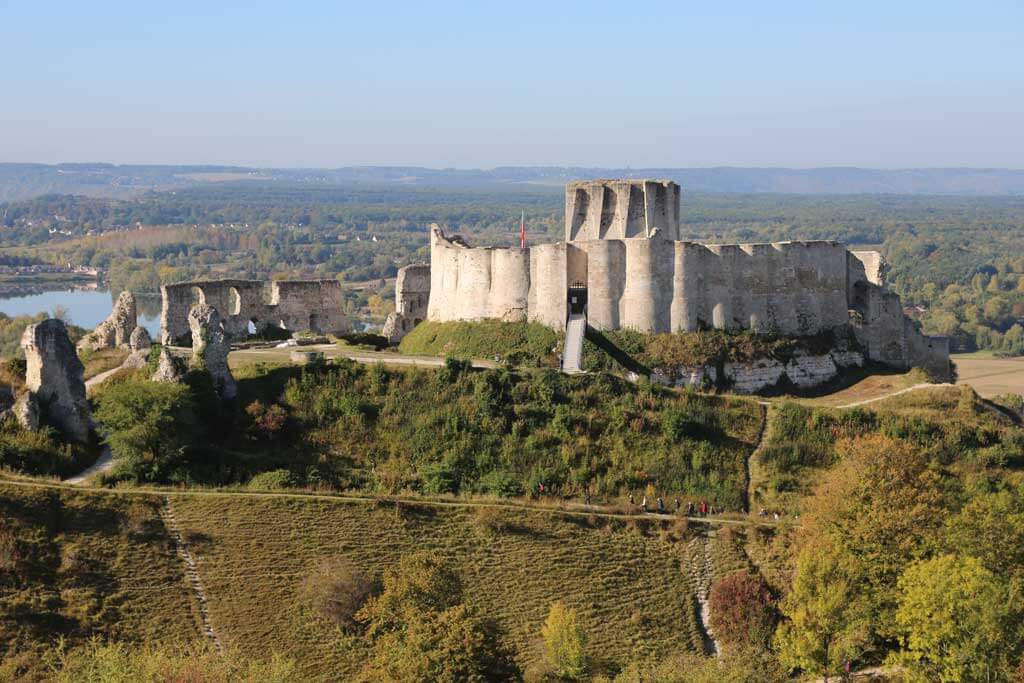
TIP: This castle is covered on our Normandy road trip from Paris .
Don’t miss the splendid ruins of Château Gaillard , a medieval fortress built in the 12th century under the orders of King Richard Lionheart – who was also Duke of Normandy – to protect his lands against the French King Philippe Auguste.
This Normandy castle has a strategic position, located on a hill and overlooking one of the meanders of the Seine River and the lovely towns of Les Andelys . The view from the castle is terrific.
Considered a cutting-edge example of military architecture in its day, the castle was built in only two years. Château Gaillard consists of three baileys separated by rock-cut ditches —an inner and a middle, and an outer with the main entrance to the castle—and a keep, also called a donjon, in the inner bailey. The outer and the middle baileys are studded with towers.
In 1314, two of the three daughters-in-law of Philippe IV le Bel were locked up in Château-Gaillard after the affair of the Tour de Nesle: Marguerite de Bourgogne, adulteress of the heir to the throne Louis of France (future Louis X le Hutin) and Blanche de Bourgogne, wife of Charles de France (future Charles IV le Bel). The first died there the following year, perhaps strangled on her husband’s orders.
VISITS: Wednesday to Sunday, from 10 am to 12.30 pm and from 2 pm to 6 pm.
3. Château de Dieppe (Seine Maritime)

Château de Dieppe was originally built in 1188 by King Henry II to ensure the defense of the city. It is located on the edge of the cliff of Claude-Côte, about 30 meters above sea level, and overlooking the English Channel. The château was destroyed in 1195 by King Philip II of France. It was then reconstructed in 1433 by Charles des Marets.
This castle in Normandy was built in flint and sandstone, and several architectural styles are represented. The castle’s layout is composed of a quadrangular enclosure with round flanking towers with conical tops and a lower court adjacent. The large west tower dates perhaps from the 14th century and served as the keep, while the brick bastion was added later to the original enclosure.
One of the best things about this castle of Normandy is the view. From its position on a hill, it overlooks the surrounding landscape, driving the painter Turner to create one of his famous watercolors depicting the scene.
VISITS: from Wednesday to Sunday, from 10 am to 12 pm and from 2 pm to 5 pm.
4. Château Fontaine-Henry (Calvados)

Château Fontaine-Henry is located between Caen and the D-Day Landing beaches and is one of the rare castles in Normandy that has been in the same family for the past 800 years. It’s in the Calvados department and was built in the 15th and 16th centuries.
The castle was built on the foundations of an earlier fortress by Guillaume de Tilly, Sieur de Fontaine-Henry, an ancestor of the current owners. The eldest branch of the Tilly family transmitted its land to the Harcourt family by marriage when Jeanne de Tilly married Philippe d’Harcourt in 1374. In the 15th and 16th centuries, the Harcourts undertook the reconstruction of the castle after the Hundred Years’ War, giving it its current appearance.
Château Fontaine-Henry is a beautiful example of a Renaissance building and is surrounded by lush countryside. Aesthetically speaking, it looks like one of the Loire Valley Castles , but in Normandy!
Featuring the highest castle roofs in France (up to 15 m), Château Fontaine-Henry is listed as a Historical Monument since 1924 and it is decorated with luxurious furnishings and beautiful furniture and paintings.
VISITS: Saturday and Sunday from 1.30 pm to 6.30 pm.
5. Château de Nacqueville (Manche)

Château de Nacqueville (also known as Château de Fourneville) is in a coastal valley that’s just 20 minutes from the Channel port of Cherbourg . It’s at the tip of the Cotentin Peninsula in Normandy, and construction began in 1510.
This château was originally a fortified manor built by the Grimouville family and had a six-meter-tall protective wall. Unfortunately, the wall was knocked down in 1700, and the building itself had to be rebuilt during the 18th and 19th centuries. In 1830, an English landscape gardener was commissioned to create the château’s romantic park, which contains waterfalls, ponds, ornamental trees, exotic plants, and woodland.
During WW2, Château de Nacqueville was occupied by the Germans and later the Americans, leaving the castle in a deplorable state.
After 10 years of restoration, its owner could open the castle and surrounding park to the public. Today, people can visit the park and the oldest parts of the castle.
VISITS: from Thursday to Sunday and holidays, from 12 pm to 6 pm (Open from May to September).
6. Château de Gratot (Manche)

Located in the commune of Gratot , just a few kilometers from the English Channel, this ruined medieval château is considered to be one of the most picturesque Normandy castles.
Château de Gratot was built by the family of Argouges in the 14th century but underwent many renovations over the following centuries. It is most famous for its Fairy Tower, which was constructed in the 15th century and is surrounded by fanciful fairy legends.
The rest of the castle showcases a number of styles, including the pavilion built in the 18th century. The castle was abandoned in the 19th century, and volunteers have been reconstructing it since 1968.
VISITS: Every day from 10 am to 7 pm.
7. Château de Saint-Sauveur-le-Vicomte (Manche)

Château de Saint-Sauveur-le-Vicomte is a medieval castle located in the Manche département and is just over an hour’s drive out of Caen . It was built in the 11th and 12th centuries and has been listed as a Historical Monument since 1840.
The original castle was built by Godefroy d’Harcourt, the Baron of St. Sauveur, on the grounds of a Viking fortress. The castle was besieged twice during the Hundred Year’s War as it was one of the most important access points to the Cotentin peninsula. The castle also played a major role during the Religion Wars and later suffered bombardments during WW2.
Today, the castle is mostly in ruins but is still one of the best castles in Normandy for history buffs. The oldest part of the present castle is called the Old Keep and it still has its original towers dating back to the 12th century.
VISITS: free access all year round. Guided visits available on site.
8. Château Pirou (Manche)

Château Pirou is one of the oldest fortified castles of Normandy. It’s located in the commune of Pirou (Manche), just over an hour away from Caen .
This castle was built in the 12th century to protect the town of Coutances and watch over Cotentin’s west coast, though the site has been occupied since the 9th century. It originally belonged to the lords of Pirou and was given to the family when one of the Pirou’s found favor with William the Conqueror.
This fortified castle is a marvel of medieval architecture. It is built on an artificial islet surrounded by three moats, high ramparts, and five fortified gates. Visitors can explore the bakery, the press, the chapel, the room of Plaids, the old house, and the walkway with its beautiful schist roofs. The views from the castle walls are amazing.
VISITS: from Thursday to Sunday from 10 am to 12 pm and from 2 pm to 6 pm.

9. Château de Martainville (Seine-Maritime)

Located in the village of Martainville-Épreville , in the Seine-Maritime department, this historic building was built between 1495 and 1505 by Jacques Le Pelletier, son of one of the richest families in Rouen. Unlike many of the Normandy castles in this article, it was used as a manor house rather than a defensive structure.
The castle is a quadrilateral flanked by four large corner towers and equipped on the rear facade with a staircase turret. Towards the end of the 16th century, the castle owners added a rectangular enclosure punctuated by four turrets, and a new moat was dug outside. Pleasure gardens were created in this enclosed space in the 17th and 18th centuries and there are still vestiges of them.
Today, the castle houses the Museum of Norman Arts and Traditions and is a beautiful example of the Renaissance architectural style.
VISITS: open from Wednesday to Monday.
10. Château de Gisors (Eure)

This castle in Normandy is located in Gisors , in the department of Eure, and is just over an hour’s drive from Rouen . The castle was an important fortress for the English Kings – Dukes of Normandy and was built in the 11th century to help protect the region from the King of France.
Château de Gisors was originally a wooden keep. In 1193, the castle was taken by the King of France Philippe Auguste who carried out several developments and undertook the construction of the Tower of the Prisoner. Other reinforcements were carried out during the Hundred Years’ War.
Transformed into a prison, the castle accommodated several brothers of the Temple after their arrest. It was also supposed to be a hiding place for the treasures of the Knights Templar, at least according to local legend.
VISITS: free access all year round from 9 am to 5.30 pm (winter) and from 9 am to 7.30 pm (summer).
Back to Homepage
Disclaimer: This article may contain compensated links, meaning we get a small commission if you make a purchase through our links. It costs you nothing more (in fact, if anything, you’ll get a nice discount) but helps us to go on creating incredible French content for you. We trust all products and brands promoted here and would never recommend anything that isn’t of value. Please read disclaimer for more info.
(C) Copyright 2019 - 2024 France Bucket List. All Rights Reserved. Designed & Developed by France Bucket List || Disclaimer || Privacy Policy || Contact |

Luxury accommodation, private guided tours, transport and catering services...
We love NORMANDY

Patrick Hilyer's
Top 10 castles in lower normandy.
Medieval stone fortresses and elegant Renaissance manor houses, Lower Normandy is blessed with hundreds of ancient monuments. We have selected our favourites: ten châteaux to visit, dine in or stay the night in baronial style.
#10 - Château des Ravalet

Photo: Wikimedia Commons
Once the property of the French King, François I , Château des Ravalet has a fascinating and chequered history. Jean de Ravalet purchased the royal castle in the 16th century and constructed a Renaissance château on its medieval foundations. The château’s secrets include an incestuous marriage, beheadings, bankruptcy and murder. By the 18th century, Ravalet had been acquired by the family of Alexis de Tocqueville who were responsible for the restoration of the house, the greenhouses, the lakes and the landscaped park. Today the grounds are in the care of Gilles Clément , the celebrated botanist, whose Mandala Garden and Island Meadow have won prestigious awards. Now owned by the town of Cherbourg, the house is only occasionally open to visitors, but the park and gardens are open all year round.
Château des Ravalet, 50110 Cherbourg-en-Cotentin
www.cherbourgtourism.com
#9 - Château de Canon

With medieval origins, this 18th-century manor house was remodelled by the great Parisian lawyer and friend of Voltaire , Jean-Baptiste Elie de Beaumont . After the restauration of Canon, Elie de Beaumont and his wife, Anne-Louise , instituted the annual Fête des Bonnes Gens – the Good Folk Fayre – a two-day celebration of virtue. The festivities took place in the stables, workshops and the recently restored Salle des Rosières which form the Chateau’s impressive quadrangles. 15 hectares of ornamental gardens surround the château. The French-style garden’s geometrical flower beds, elegant statuary and ‘mirror of water’ lake reflect the perfect symmetry of the house. The remainder of the park, bisected by the River Laizon, was created in the English style at the turn of the 19th century. A guided tour of the house is available in July and August; the park is open from April to September.
Château de Canon, 14270 Mézidon-Canon
www.chateaudecanon.com
#8 - Château de Pirou

Photo: Patrick Hilyer
One of the oldest medieval fortresses in the Normandy region, Château de Pirou bears testament to the feudal warfare that once ravaged this now tranquil landscape. The castle was built in the 12th century to protect the town of Coutances from seafaring invaders. But the gradual silting up of its shallow water harbour made Pirou’s defensive role redundant, and so its grey stone walls have survived the invasions and unrest of successive centuries. In the barn is an embroidered cloth, created in the 1970s in the style of the Bayeux tapestry , depicting the history of the Normans from Viking colonisation to the conquest of Sicily . As with many ancient castles, Pirou has its legend: during a long siege, the Lord and his family escaped by transforming themselves into Geese. Unfortunately, the book of spells which allowed this transmogrification was burned by the besiegers, and the family and their descendents were cursed to remain as Geese, returning to their home each year along with the other migratory birds of the Cotentin. Open every day except Tuesdays from April to September.
Château de Pirou, 50770 Pirou
www.chateau-pirou.org
#7 - Château de Brécy

A judge from the nearby city of Caen built this stately home in the 17th century. It’s a fine three-story manor built in pale Caen limestone, but it’s the exquisite gardens, designed by the architect François Mansart , and ornamental gates that make Brécy so special. The fabulous wrought-iron gates bring you to a series of terraces, a statue-adorned Renaissance knot garden with sculpted flowers, dogs and fountains, and a medieval walled garden. The terraces rise to a small hill from where the perspective, as the French author Jean de la Varende wrote, “opens to the sky”. Didier and Barbara Wirth have worked tirelessly since 1992 to restore and maintain the magnificent gardens. They open the gates to visitors from Easter until the end of May, then form July 1st to October 31st.
Château de Brécy, 14480 Saint-Gabriel-Brécy
www.normandie-tourisme.fr
#6 - Château de Canisy

Towers and turrets, lakes and landscapes – Canisy has all the hallmarks of a historic French château. But what makes this place extraordinary is its human story. Canisy’s began in the 11th century when one of William the Conqueror ’s knights, Hugues de Carbonnel, constructed a Norman fortress near Saint-Lo. A dynasty was born that would last a thousand years: the present chatelain, Count Denis de Kergorlay, is De Carbonnel’s direct descendent. During WW2 Canisy was sequestered by the Wehrmacht and used as an army hospital; after the liberation General Omar Bradley established his HQ at the château. Canisy and its custodians have survived wars and revolutions, and today the early 17th century buildings and interiors are immaculately conserved. The castle sits in hundreds of hectares of forest, pasture and landscaped parkland. The grounds are open all year round to visitors, the house by appointment. Eighteen guest bedrooms .
Château de Canisy, 50750 Canisy
www.canisy.com
#5 - Château de Balleroy

Photo: Wikimedia Commons
Designed and built by the architect François Mansart between 1626 and 1636, this fine château was the family seat of the Marquises of Balleroy for three centuries. In 1970, the property was purchased by Malcolm Forbes , and remains in the ownership of the Forbes family. A tree-lined avenue nearly two miles in length offers the first breath-taking view of the property. Arriving at the elegant gates, the imposing facade presents itself: a four-storeyed, cupola-topped edifice in grey granite and red pudding stone, flanked by two wings and a pair of pavillon lodges. Surrounding the house are 135 hectares of landscaped parkland in the romantic style, and French knot gardens. Inside the house the portraiture, animal and hunting scenes, decorative panelling and the Escheresque staircase are something to behold. Created by Malcolm Forbes, the Hot Air Ballon museum is well worth a visit, as is the parish church, also attributed to Mansart. Balleroy is open to visits from April to September.
Château de Balleroy, 14490 Balleroy
www.chateau-balleroy.fr
#4 - Château de Carrouges

An elegant twin-turreted gatehouse and decorative wrought-iron gates welcome visitors to Château de Carrouges, a sombre moated castle. The rectangular courtyard is delimited by two symmetrical wings, designed by the architect Francois Gabriel at the end of the 16th century, and other buildings from the 14th and 15th centuries. The earlier parts of the castle are attributed to Jean Blosset, the Grand Seneschal of Normandy. From the 16th century until its sale to the French state in 1936, the chateau belonged to the family Le Veneur de Tillières . Inside you will find an interesting collection of furniture from the Renaissance to the Restoration, the kitchens with their copper pots, the bedchamber of Louis XI , fine fireplaces, ancient panelling and portraits and a fabulous brick staircase. The castle and the ten-hectare park and gardens are open to visitors from April to September.
Château de Carrouges, 61320 Carrouges
www.chateau-carrouges.fr
#3 - Château de Falaise

Named after the bluff or cliff that rises above the little town, Falaise was an important military site well before William, Duke of Normandy was born here in 1027. William spent his childhood at Falaise before acceding to the dukedom in 1035, and went on to earn his moniker – William the Conqueror – following the battle of Hastings and the conquest of England in 1066. Although the remains of the current castle (much restored between 1986 and 1996) date from a little after William’s time, the chateau’s military importance and historic significance are unsurpassed in the region. Whereas Mont Saint Michel is without doubt an architectural ‘marvel’, Falaise is the birthplace of the first Norman King of England. Below the castle, in a town devastated during the Battle of Normandy in 1944, you will find historic churches and a couple of museums. The castle is closed in January, but otherwise open every day.
Château de Falaise, 14700 Falaise
www.chateau-guillaume-leconquerant.fr
#2 - Château de Fontaine-Henry

This dynastic castle, built on medieval foundations, was reconstructed in the 15th and 16th centuries in the decorative style. The facade, in pale Caen limestone, is topped by steep, tiled roofs. Described by the French novelist Jacques de Lacretelle as “a Loire château in Normandy”, Fontaine-Henry is one of the finest examples of Norman Renaissance architecture . The village takes its name from Henry de Tilly who acquired the chateau in 1172. His descendents retained the castle for eight centuries, and today the Marquis Pierre-Apollinaire d'Oilliamson welcomes visitors to his family seat. In the landscaped parc à l’anglaise is the 12th-century chapel, numerous outdoor games and, in summer, a sculpture exhibition. Open daily (except Tuesdays) from mid June to mid September, and on weekends and holidays in the shoulder periods.
Château de Fontaine-Henry, 14610 Fontaine-Henry
www.chateaudefontainehenry.com
#1 - Mont Saint Michel

Although not strictly a castle, this iconic marvel of medieval architecture has defended itself against invaders and tides since its foundation in the year 708. In fact, the ramparts were constructed to fend off the English during the Hundred Years' War . A UNESCO World Heritage Site , Mont Saint Michel attracts over 2 million visitors and pilgrims every year. Since the construction of a new bridge which replaced the causeway linking the citadel to the mainland, Mont Saint Michel is once again a magical island. Surrounded at high tides by the shimmering waters of the bay , when the tide is out this is a place of pilgrimage for visitors arriving on foot across miles of sand. The climb to the mystical Benedictine abbey at the top of the edifice is well worth the walk, and the view from the bridge of one of the world’s most unforgettable sights is breathtaking. Mont Saint Michel is a must-see destination and deserves to be nominated the best castle in Normandy. Open every day throughout the year, and in the evenings from 7pm until midnight during July and August.
Mont Saint-Michel, 50170
www.ot-montsaintmichel.com
Planning a trip to Normandy? Looking for chateau or hotel accommodation? Visit www.welovenormandy.com
#montsaintmichel #chateaux #castles #historicmonument #UNESCO #gardens #Renaissance #AlexisdeTocqueville #GillesClement #Cherbourg #Voltaire #Coutances #bayeuxtapestry #Vikings #Cotentin #knotgarden #FrancoisMansart #WilliamtheConqueror #WW2 #OmarBradley #MalcolmForbes #Forbes #Mansart #Hotairballoon #Seneschal #LouisXI #DukeofNormandy #normanconquest #Lacretelle
- Recently Viewed
- Log in / Sign up
- France (1291)
Chateau Les Douves
Like it add to favourites to compare and share, like it don't miss out, need to check with your party.
Reserve today and if for any reason you change your mind within 48 hours you'll get a 100% refund .
Full refund if you change your mind within 48hrs.

What Oliver loves…
- The approach to the chateau via the tree-lined driveway will quite literally take your breath away as you're transported back to the C17th.
- The heated private pool is set within a beautifully kept garden beneath the chateau. It's huge and perfect for relaxing beside whilst the kids play.
- The sheer scale of the place - all the rooms in the chateau are enormous with high ceilings so even large groups will struggle to get on top of each other.
- The table tennis room has been decked out with tennis memorabilia and even has tennis lockers. A nice hang out spot for teenagers.
- Sandy beaches are only 10 minutes drive away and they are perfect for the little ones as you can walk our about 100m and still only be up to your knees!
- Mont St Michel, Bayeux Tapestry and the Normandy landing beaches are all easily accessible for day trips.

With style reminiscent of a miniature Versailles, this striking chateau in Normandy conjures the grandeur of the 17th and 18th centuries from the moment you app...
With style reminiscent of a miniature Versailles, this striking chateau in Normandy conjures the grandeur of the 17th and 18th centuries from the moment you approach it through the tree-lined driveway. The chateau effortlessly combines classic touches (from the stonework in the garden to the Aubusson carpets and even an original c17th backgammon set), with the modern amenities you expect, such as jetted tubs, Nespresso machine, widescreen TV (with Netflix and DVD) and the heated pool, to name just a few.
This is no dark and dreary castle - large windows on both sides of the chateau let light stream in throughout the day. Sportsmen and women can compete on the private tennis court, do some laps in the pool, fish in the moat, and bicycles are also available for anyone wanting to leave the extensive grounds. The beach at Fontenay-Sur-Mer for example is within easy biking distance. Through the gardens, 100m away from the main chateau, is a separate cottage that’s perfect for a small family who prefers more privacy.
Here, your family chateau holiday includes the best of both worlds: peaceful French countryside, with access to historic sites. Only 15 minutes away WWII history comes to life in the town of Sainte-Mère-Église and Utah Beach, the site of the D-Day landing. Cherbourg & Caen are the nearest port and airport, but it is also convenient to drive from Paris, just 3 hours away.
Please note this property is available for groups of up to 14 guests when renting the chateau and the cottage. For smaller parties of up to 10 guests, the chateau on its own can be rented at a reduced price.

What you should know…
- The cottage is charming and comfortable but is not furnished to the same standard as the chateau (see photos)
- You will share the vast estate with two ponies, two swans, a cat and a dog!
- The guardian lives on site but away from the chateau
- There's a moat about 20m from the house which can be used for carp fishing plus a smaller one near the pool
- When the 10-person rate is booked the cottage is not available for guests to access. The cottage is only available to guests when the 14-person rate is selected
- Please note that the maximum capacity permitted includes infants
Property Features
14-person rate: Chateau and Cottage, 8 bedrooms, 6 bathrooms 10-person rate: Chateau only, 6 bedrooms, 5 bathrooms
Please note that the maximum capacity permitted includes infants.
Ground Floor - A large kitchen (50 m²) equipped with two electrical ovens, 3 electric halogens hot plates, an electric plancha, full height refrigerator with freezer compartment, dishwasher and lots of cooking equipment. Sufficient crockery, silverware and glassware for the rental capacity; kitchen table for up to 10 and a bar counter for up to 5. - A pantry with sink, kitchen table, Nespresso machine & washing machine - A Boiler room - A Mud Room with hangers and bench - A large TV/Playroom (65 m²) with satellite TV, DVD-player, Hi-Fi, bookshelves, Wi-Fi, two Chesterfield sofas, armchairs, games table (some DVDs & English books are available).
First Floor - A large Louis XIII dining room (50m²) with a maximum capacity of 14/18. Kitchenware is furnished for to cater for the maximum capacity. - A small dining/breakfast room for up to 8 is equipped with dishwasher, 2 hot plates, sink, microwave, refrigerator,toaster, coffee and Nespresso machine and crockery. - A large Regency bedroom (30 m²) with a double bed (140x190), shower, toilet and a small hand basin. - A cloakroom with phone, Wi-Fi printer, umbrellas and cupboard with numerous regional guides. - A large guest WC with double sinks, cupboard with numerous vases. - A large blue Louis XV Drawing Room (50 m²) with meridienne, armchairs, game table and Piano forte (not tuned!). A great spot for a gin and tonic pre-dinner! - A Louis XIII library/drawing room (45 m²) with sofa, armchairs, desk, tapestry, bar, Hi-FI.
Second Floor - A large double en-suite bedroom (30 m²) with a double bed (140x200) with bathroom with double sinks, separate shower, Jacuzzi bathtub and WC. - A single bedroom with a 100 x 190cm bed, bidet and hand basin. - A double bedroom with a shower and hand basin. - A laundry room with washing machine, dryer, ironing table. - A large double en-suite bedroom (35m²) with a 140x200 electrical bed and bathroom with bathtub, separate shower, WC, and en-suite dressing room, mini TV (only local channels). - A twin bedroom (25 m²), with two single beds 90x200 which may be joined on request. - A child bedroom/den with a small bed 80x150 (not accounted for in the sleeping capacity). This connects with the twin bedrooms so works well for small children. - A hall bathroom which connects to the twin room but can also be accessed from the corridor, with sink & bathtub. - A separate WC.
Cottage (100m from chateau)
Ground Floor - Kitchen/dining room fully equipped with an oven, fridge, dishwasher, microwave, hot plates - Living room
First Floor - Bedroom with double bed (140cm x 200cm, can be split into 2 single beds) - Bedroom with twin beds (90cm x 190cm) - Bathroom with bathtub and WC
Outside Grounds
- Heated swimming pool (27-29 degrees) with key operated cover - Outside shower - Private tennis court - Moat for carp fishing (2m deep) and one near pool - Mountain bikes (basic style) - Vegetable garden with swings - Table tennis games room - Croquet - Gas barbecue (on request) - Tennis racquets - Basic fishing rod (carp are available in the lake) - Various animals live on the premises - two ponies, a dog, cat and two swans
Chateau Les Douves lies in the heart of the wild and beautiful Cotentin Peninsula area in Normandy, ...
Chateau Les Douves lies in the heart of the wild and beautiful Cotentin Peninsula area in Normandy, in Fontenay-sur-Mer, 300km west of Paris. The closest train station is Valognes (12 km). You can discover and enjoy the local area by walking or biking through the beautiful and peaceful countryside. There are many bikes available at the chateau (free of charge) so we recommend exploring the local area this way as the roads are so quiet. During your stay you should visit the historic town of Valognes, particularly the Hotel de Beaumont and the famous Cider Museum. Here you will find everything you need during your stay (supermarket, shops, restaurants etc) and it is only ten minutes drive away from the chateau. The chateau is 3 miles from the beach and an 18 hole golf course created 30 years ago by the father of the current owner of the chateau! There are also several riding clubs around where lessons or private hire can be organised. Distances - 5 mins to sandy beaches - 15 mins to the D-DAY BEACHES (Utah Beach) - 15 min to world renowned village Sainte-Mere-Eglise - 1.5 hours to the Mont St Michel - 45 mins to The Bayeux Tapestry. - 2 hours to Honfleur. - 2 hours to Gardens at Giverny (Monet). - 2 hours to Rouen. - 3 hours to Paris by car or train.
Read more about Normandy
History and gastronomy go hand-in-hand in Normandy, making it a great choice if culture and fine dining are what you’re looking for in a holiday! There’s still plenty on offer besides the food and tales of yesteryear, however – you can take a tour around some of the beautiful inland towns and villages or head to the coast, where you’ll find a mixture of wide sandy beaches and rugged, romantic cliffs. If you’re not already convinced to head to one of our villas in Normandy (or maybe if you’ve already booked) you’ll find a wealth of great things to do, see and eat in our ultimate Normandy travel guide!
Download our Normandy Travel Guide >>
Baby and Toddler Equipment
- High Chair(s)
Kids Activities Close-by
- Beach Nearby
- <1hr to Airport
- Horse Riding
- Outdoor Pursuit & Activities
- Tourist Towns & Villages
- Historical Sites
Onsite Facilities
- Board games
- Boules/Petanque
- Child-Safe Pool
- Heated Pool
- Tennis Court
- Bicycles Provided
- Indoor Games
- Outdoor Games
- Table Tennis
- Table Football
Services Available
- Chef/Cook Available
- Maid Service Included
Oliver's Extras
At Oliver’s Travels we pride ourselves on going that little bit further for our guests. From pr...
At Oliver’s Travels we pride ourselves on going that little bit further for our guests. From private chefs to babysitters we can help you arrange those little extras that make it a truly memorable holiday. Simply fill in the concierge request form or contact the Oliver’s Concierge Team who will be happy to help. We can typically help you arrange any of the following: - Maid service/extra cleaning - Private chef/cook/catering - Welcome hamper/pre-stocked fridge - Local day-trips or tours - Airport pick-up/drop-off - Babysitting/childcare services Extras available at this property : - A daily 3 hour cleaning service of common areas (Monday-Friday) is included in the chateau rental (this does not extend to washing up). Washing up and cleaning of bedrooms and bathrooms can be included on request at additional cost. - Bed/bath linen change included once a week - A fantastic local chef is available to cater for breakfast and evening meals Please enquire for more details. - Additional cleaning, babysitting and shopping service are also available. Please book these services at least a couple of weeks prior to your stay. Please note that all extras are subject to availability and must be requested in advance of the holiday (prices on request). Due to some rural/remote locations, not all services will be available at all properties. However, we will always do our best to fulfil your requests.
Oliver's Travels Chef Service: A Gourmet Dining Experience Make hosting a memorable dinner party at your villa an absolute breeze with our superb Chef Service. Our chefs will take care of everything for you from start to finish so you can just sit back and enjoy the gastronomic experience. They will bring all the necessary ingredients, cook and serve the food and even clean up afterwards. To find out more visit www.oliverstravels.com/chefs
Event information
Terms & conditions.
These terms and conditions may be amended from time to time.
Rental Rates
Prices based on an occupancy of 10 people :
Prices based on an occupancy of 14 people :
Please note that these prices/rates are a guide only and may not be correct at the current date. For an accurate quote, please enquire.

Property Owner Jean
How long have you owned the property? More than 20 years.
What was it about the property that you first fell in love with? The Chateau has ...
Owner Profile
What was it about the property that you first fell in love with? The Chateau has always been in the family. It is very bright and have beautiful gardens. Between tennis, pool, golf, sailing and water ski the property was like a private club med during my summer holidays while I was growing up.
Are there any interesting stories in its history? As it is 8 miles from Utah Beach, the house was fortunate not to have been bombed on D'Day during the WWII. It changed hands 9 times in 3 days so neither the Americans or the Germans knew who was inside at any given times.
Have you ever had any famous guests staying? King James II of England in 1692.
For anyone coming to stay is there anything in the surrounding area they should... Really do? Watch the sunrise on the sea.
Really eat? Oysters, Mussels, Local Lamb and Cream & Apples.
Really see? Mt St Michel, La Hague, D-day beaches.
Lastly, what insider tip would you pass on about the property or the area? It can be windy at times.
ENQUIRE NOW
Loved this historical home
Such a lovely, historical home! This is truly an authentic French stay. A stroll through the gardens is the perfect way to spend a sunny afternoon. Loved this historical home.
Really extraordinary to stay in a 17th century chateau -- even though many of its quirks were not easy to adjust to. The property is beautiful.
Magnificent property
Would like to commend Oliver's Travels for my recent vacation in Normandy at Chateau Les Douves in Fontenay-sur-mer. The property was magnificent. The owner was there for arrival and departure and was most informative and helpful. The staff provided assistance as needed. Did I say the property was MAGNIFICENT, and its location was perfect? Well, it certainly was. I'd recommend this property to anyone interested.
I would highly recommend it!
Château de Cource was lovely, beyond what we expected and we enjoyed a wonderful week there. The property is beautiful, full of antiquities with amazing gardens and a super swimming pool. Jean, the owner, was most helpful.
Spectacular family holiday!
I really enjoyed this holiday with my children and grandchildren. The chateau was delightful and the availability of Chef to provide a excellent pre leaving meal was an advantage. She gets 5 stars for service and providing a delightful meal for us. Why 4 stars and not 5 overall?? For an older person the many stairs were a bit hard work plus the small bathroom en suite on the 1st floor a bit constricting. But the pool was delightful plus we found the tennis courts also much used by the children Although not a cyclist (at 85yrs old) my children found the cycles available not up to the standard young people demand from their bikes today so were unused. But overall a fabulous holiday- one we must repeat again
Best Holiday ever!
What a wonderful home to stay in! Family owned, and family loved. We enjoyed our holiday in this beautiful castle very much. You can feel and see history everywhere. For the sports loving people there is a tennis court, a swimming pool, bikes etc. So, you have enough possibilities to change the calories you ate in the superb restaurants nearby into energy! Moreover, many interesting places (landing beaches, museums, charming villages etc. etc.) are just minutes away from the castle. The owner was very helpful and gave us a warm welcome. He even organized a cooked dinner for the first night and put some food in the fridge. We can definitely recommend this castle with its gorgeous garden, where you can even pick flowers for your table, for any history loving people. To cut a long story short: It is not the cheapest way to enjoy holidays but simply one of the best.
Absolutely Wonderful
We had the pleasure of staying at the Chateau de Cource last year for a family re-union. There were 8 adults and 7 children, of which 6 were under 10 years old. Our stay was absolutely wonderful. The house is beautiful, standing amid expansive and very well maintained gardens, with plenty of spaces for the kids to play as well as a clean and accessible swimming pool. We had full use of the house and grounds and enjoyed learning about the history of the owner's family, the house and all its beautiful furniture from the owner, who met us and ensured that everything was perfect for our stay. There is a caretaker/gardener and family living adjacent to the house, which was very helpful on the few occasions when we lost our keys or needed access to some of the amenities. The kids thoroughly enjoyed roaming the grounds, playing tennis and spent much time in the pool. The owner, also arranged for us to have the support of a wonderful cook to prepare family friendly and adult pleasing delicious meals every evening, including after dinner clean up and morning cleaning every day. We spent our days enjoying the property and nearby villages as well as exploring the history and sites of the D-Day landings. The owner was extremely helpful and attentive in ensuring everything was perfect.
All-time favourite holiday
We enjoyed one of our all-time favourite holidays at Chateau de Cource during the summer of 2016. It was pretty much like spending 14 blissful nights in an extraordinarily comfortable, divinely elegant, charming, characterful and fascinating museum. The property's long history is palpable, as if you can touch and breathe in the centuries. It’s absolutely somewhere you immediately settle in and don’t want to leave, made even more instantly relaxing by owner Jean, as gracious as he is entertaining. It’s also beautifully well-equipped: we spent countless hours in and by the pool, playing tennis at sunset, rowing in the moat, feeding the swans, walking the grounds, engaged in the kitchen preparing delicious local produce, and as much time again unwinding in the enchanting brick-vaulted lounge with a log fire for atmosphere. Locally, it’s fascinating: the Normandy beaches and dunes, alluring farmers’ markets and agricultural shows, museums a plenty, historic towns and quiet countryside that is at all times tranquil, even in the height of the season. Everything is half the price of the Cote D’Azur, yet twice as pleasant, so altogether four times better value. Of course we shall return.
Understated, relaxed elegance in the Normandy countryside
A handful of close friends and I spent the most enjoyable and relaxing week at Chateau de Cource, a thoroughly charming and idyllic 17th century chateau located in the gorgeous Normandy countryside. Prepare to be transported to another time entirely; it did not take us long to appreciate the chateau's unique qualities and also its idiosyncrasies. If you are looking for a property with 5* amenities across the board, specifically perfectly updated bathrooms and kitchens, this may not meet your expectations. However, the opportunity to experience an historic, centuries owned, "grand family home" is special indeed. All of the rooms are elegant and ooze character and the pool, gardens, tennis court and moat (complete with 2 swans!) are like icing on the cake. The owner, Jean, could not have been more gracious, accessible and warm. He drove from Paris to meet us on arrival, gave us a thorough tour of the home and property and made sure we felt welcomed and comfortable. Jean checked in with us regularly (his english is excellent!) and was very pleased to answer any questions and make recommendations for local restaurants, markets and sightseeing excursions, all of which made the trip feel authentically french. A lovely housekeeper/cook is available to provide as much support as you desire --- she is an excellent cook and extremely pleasant. After long days of walking the coastline, exploring nearby towns, making the trip to Mount St. Michel and the D-Day Beaches, it was wonderful to return to delicious home cooked meals. We were sad when our week came to its end and we all have such fond memories of our time at Chateau de Cource!
Most incredible time- living in a fairy tail for one week
This chateau is just a dream come true. The photos look nice but it is even more impressive in reality. We were lucky to find an available week and the booking process was very easy. Jean is just wonderful. He came from Paris to greet us on our arrival and explained everything and even introduced us to the local fishmonger. The property is very well kept- the house and the gardens are always perfect. There are some gardener looking after the wonderful gardens and the Madame, who is looking after the Chateau is also a great cook. We, a group of friends with children, spent lovely hours at the pool and in the gardens and we all felt like little prince and princess. In the evening we enjoyed the delicious dinners, which were prepared for us and the evening ended with a digestive in one of the living rooms. All rooms are furnished with precious antiques and all bathrooms are equipped with high class facilities. Also the kitchen was a dream: Very atmospheric but with first class equipment. The beach is near by and there are a lot of things to explore in the area. We will definitely come back! We all felt so lucky to be able to stay in such a wonderful place and also felt very welcome and taken care of. I must admit, that absolutely all expectations were exceeded a lot. Chateau de Cource is definitely the greatest place I have stayed at.
A beautiful chateau and gardens
We have stayed two years in a row at this idyllic house. It takes 300 years to get a well balanced house and garden. The in house chef made wonderful suppers of Normandy fare. The poll and tennis court allowed good exercise. We'll placed to visit numerous historical sites and attractions. Would go every year.
Truly amazing
We thoroughly enjoyed this house. It is beautifully furnished and in great condition. The grounds are spectacular. We have stayed in a number of other large houses in France, and this is by far the nicest. The owner's attention to detail throughout the house and grounds is impressive. Our kids really enjoyed the pool, the nearby beach and Normandie in general. There is great shopping in a nearby village. And great wi-fi in the house. This is a very relaxing and refreshing place to stay.
A wonderful experience
This house and its garden are really a piece of art. It is a beautifully preserved stately country home with well laid out and developed gardens. The furnishings are of equal quality . We benefited from Laurence who did a wonderful job preparing our suppers and assisting us in any needs we had.. The owner was also very helpful with any questions we had, even organizing typical Normandy cuisine. We used the tennis courst and pool in the morning and saw the sites in the afternoon. When renting a home there i some trepidation but this worked out far bettter than my best expectations.
Authentic and lovely to visit
On reflection, bar the heating or lack of.. It is a chateau in Normandy it was clean, authentic and lovely to visit. Jean made us very welcome and it was the first time he had leased the property And a new experience for all We all get so used to our mod cons,and it was lovely to step back in time. Kind regards Jill
Don't miss out! Reserve now and get a full refund if you change your mind within 48hrs.
Best Price Guaranteed
- All taxes and fees
- Concierge service
We work directly with owners so guarantee you won't find this property cheaper anywhere else.
Book this property today for just
The balance of will be due 12 weeks before you travel.
Reserve today and if for any reason you change your mind in the next 48 hours you'll get a 100% refund , no questions asked!
Checking...
Please select your arrival and departure dates on the calendar.
Our guaranteed lowest price includes:
Articles Featuring Chateau Les Douves
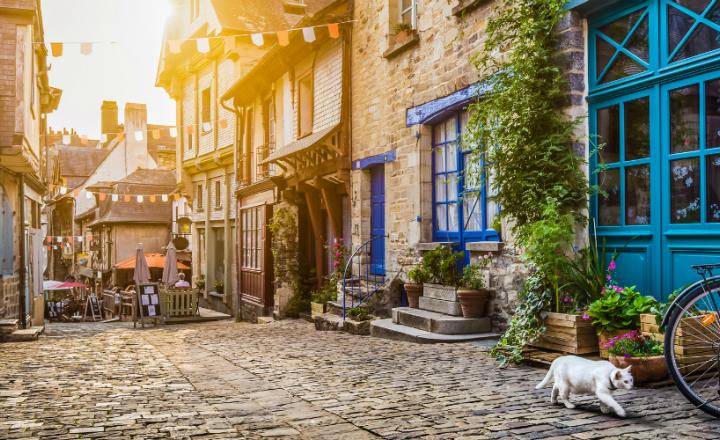
Top 10 Villas in Normandy
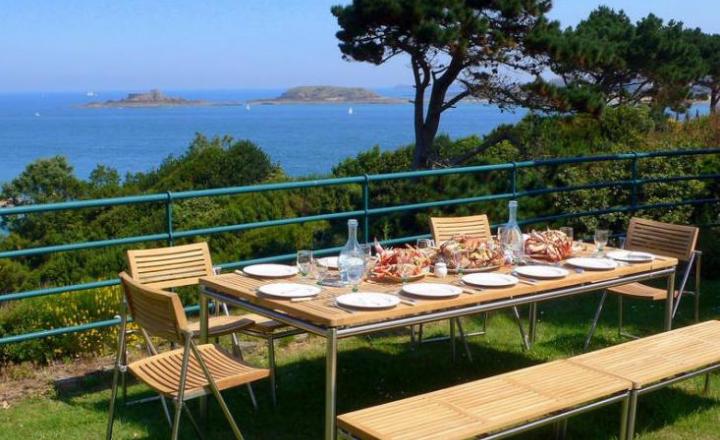
10 Self-Catering Villas in France and 10 Local Recipes to Cook While You're There
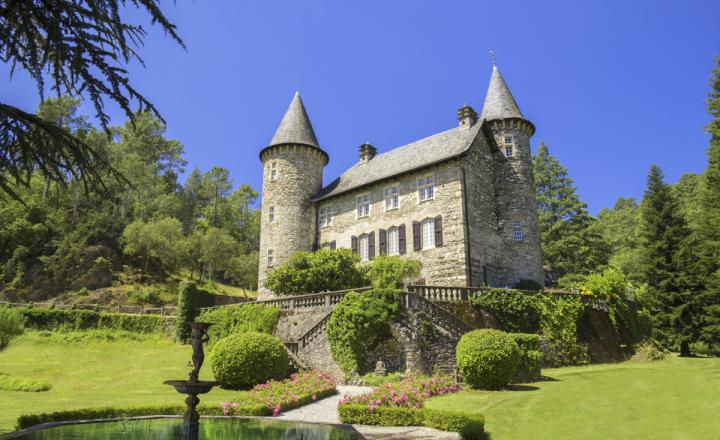
Top 24 Chateaux to Rent in 2024
Similar properties.
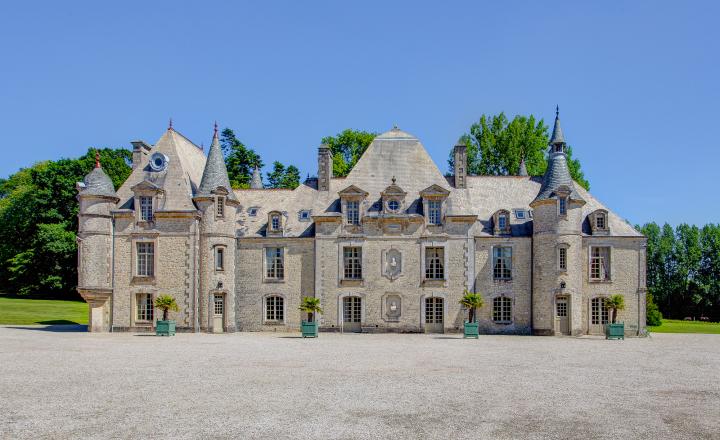
Chateau Des Reves
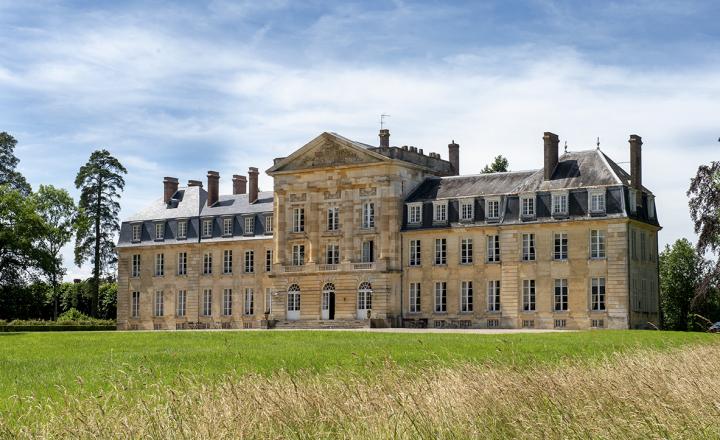
Chateau Des Roses
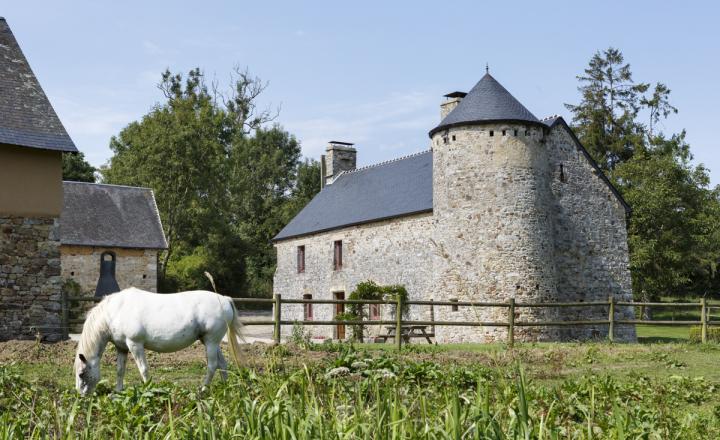
Manoir De La Gauguinier
Traveller login.
Forgotten your password? Click here .
Are you an owner? Login here .
From time to time we'd like to send you exclusive offers, holiday inspo and exciting new destination launches. You can easily unsubscribe at any time, and we will never share or sell your personal information. *
Our Privacy Policy
Add to favourites
- Keep track of the properties you like
- Share shortlists with your party
Step 2 of 2
To create your account we just need to know who we are talking to
Error. Please try again.
Thank you for your enquiry! Our team will get back to you shortly with a few options that we think will be perfect for you. In the meantime, if you have any questions or just feel like having a chat, please drop us a line on 0333 888 0205 or +44 (0)333 888 0205.
What does your perfect holiday look like?
Do you see four-poster beds and infinity pools or muddy boots and heart-warming grub? Whatever your vision, share it with us and we’ll make sure your holiday fits you like a glove (or a pair of Gucci slippers).
protected by reCAPTCHA

Your Personal Wedding Consultant
Our team of wedding consultants are here to help! Whether you are looking for a traditional Chateau in France, a rustic and romantic Farmhouse in Italy or a good old-fashioned Grand Manor Estate in the English countryside, our team will help you find the right one for you. Although personalised and bespoke, this service is also complimentary. Give our specialists a call today or fill in the form below and they will get back to you!
Please also consult the privacy policy .
Oliver's Charter
They have all lived in the country that they look after. And with an average of over 15 years' experience in their area, our Destination Experts have the ultimate insider secrets.
We ensure every house meets the 10 demands on the ' Oliver's Essential Checklist '. From WiFi and hot tubs to the less tangible 'unique characteristics', only 2% make the cut.
Quality and character nab the top spot when it comes to adding to our portfolio, but great value for money is a close second, with all our villas going through a thorough competitive analysis.
Ask a question about Chateau Les Douves
Thank you for your message. One of the team will be in touch shortly.
From time to time we'd like to send you exclusive offers, holiday inspo and exciting new destination launches. You can easily unsubscribe at any time, and we will never share or sell your personal information.: *

- The Best Of
- Destinations
- The Hotel Guru
The 16 Best Château Hotels in Normandy
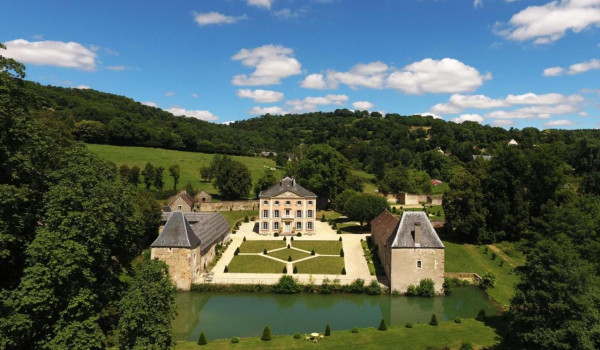
Normandy is a pretty coastal region with a rich historic past. It boasts some of France's most famed sights including the Bayeaux Tapestry, the D-Day landing beaches , and the iconic island monastery, Mont St-Michel. There are also dramatic coastlines, pleasant rolling hills and a distinct (and delicious) cuisine to be explored. For that classical French stay, it doesn't get much better than booking a room in one of the region's châteaux. Whether you want grand and traditional or something a little more chic and contemporary, there is plenty to choose from. Our hotel experts have compiled a collection of the best Château hotels in Normandy with something for everyone whether you are on a romantic escape or a family break. So why not browse through our collection to start planning your trip?
For a traditional château

- Château de Canisy is a grand building set on a 700-acre estate. It’s been beautifully preserved, both inside and out, and there are numerous reception rooms filled with elegant antiques, and featuring roaring fires. Rooms and suites are just as beautiful and historic; beds are hung with heavy drapes and the walls are adorned with traditional French patterned wallpaper and oil paintings. A fairytale stay.
- Built for the Marquis d’Ourville in 1765, the Château de Pont Rilly has that classic château grandeur. Steeped in history, this charming property has just four rooms, all with beautiful marble fireplaces and parquet flooring, topped off with period-appropriate antiques. There are also three self-catering cottages in the grounds, which sleep four, six and eight.
- The Château de Beneauville is a Renaissance château set in 50 acres of beautiful gardens and parkland. Interiors are brimming with elegant antiques, tapestries, oil paintings, traditional wallpapers, carved wood and stone fireplaces with open fires, and some notable French design and patterns. The location, between Caen and the coast, is perfect for both explorers and those seeking an active break. But it’s just as much a romantic hideaway.
- The Château de la Pommeraye is an elegant stately home in a beautiful rural location. It has just five rooms, all of them sumptuous and traditional, with beautiful antiques, huge beds and wonderful views. For many, this will match your idea of the "perfect château", from the Louis XVI furniture to the Italianate stairwells. You can also book the whole property for private use, and arrange meals as needed.
- Also benefitting from a tranquil spot, Château la Ferriere is a stunning 18th-century pile just outside Bayeux , with just five traditionally dressed rooms and suites. If you want parquet and toile du jouy, chandeliers and drapes, antiques and busts, then you should be extremely happy here; ditto if you’re looking for an intimate and luxurious base, which really feels like a château.
For a rural hideaway

- The Château de Chantore is a stunning red-brick château just back from the coast by Mont Saint Michel, hidden amongst rolling parkland so that it feels a million miles from anywhere. There are just five rooms, all of them resplendent with patterned or embroidered fabrics and period wallpapers. This is traditional maximalism at its best in an idyllic rural location.
- Elegant and romantic, it’s the Château Hotel de Belmesnil ’s position, in a tranquil, secluded spot outside Rouen , that is the real lure. From the outside, it looks every inch the perfect château while on the inside, it has been beautifully refurbished to the standards of modern luxury, in warm, natural colours. There are ten rooms, and public spaces where you can play table football, or table tennis, French boules or badminton.
- Very close to the Parc Natural Regional Normandie-Maine, the Château de Sarceaux is an idyllic countryside escape. Originally built as a hunting lodge, then converted into more of a doll’s house style château in the 18th-century, this is a historic property with four individually styled rooms, each with its own fireplace and rustic wood floors, and one suite, similarly, but more grandly decorated.
- The Château de Bouceel is another picture-perfect property. Built in the 18th-century, this five bedroom property has a wonderful collection of antiques, including Louis XVI-style panelling and lovely parquet floors. Some of the bedrooms are quite grand. The garden is large, and there’s a pool too.
- Chateau de Blavou is a picture-perfect castle set in the picturesque Normandy-Perche regional country park. Interiors are suitably grand and filled with antiques. Enormous rooms boast four-poster beds and equally large (and indulgent) bathrooms. With numerous activities on its doorstep, this is the perfect rural escape.
For a romantic escape

- Classically beautiful, with the kind of huge elegant windows and ornate iron and stonework that châteaux are known for, the Château d'Audrieu was built in a beautiful spot in the 18th-century. These days there’s a pool and tennis courts too. Inside, the 29 rooms vary in opulence but all have original features and antiques. The restaurant is gourmet, and you’re not far from the coast. A perfect escape for two.
- The Château la Cheneviere offers all the romance and luxury of a traditional French château but having undergone a full renovation interiors now feature modern luxuries with all the mod cons including a cocktail bar, heated pool and tennis courts. The restaurant serves classical French cuisine and is ideal for a romantic dinner.
For Families

- Romantic and family-friendly, the Château de saint Paterne is a 15th-century château with charming hosts in an idyllic spot outside Alencon . There are nine rooms and two suites — one of which is in a treehouse in the woods (which kids will love). With early supper time for children and endless activities including swimming, tennis, badminton, croquet or table tennis, plus fantastic table d’hote dinners, this is a real crowd pleaser.
- Chateau Saint Gilles is an 18th-century château located close to Bayeux. Inside, guestrooms and apartments are bright and contemporary, while tall windows and heritage fireplaces attest to the property's heritage. Spacious family suites are ideal for those travelling with young kids. A well priced option close to some of Normandy's most famed sights.
For a B&B

- The Château de Bonnemare is in a beautiful and remote spot. The property's sprawling grounds house a chapel, farm and cider press. Inside the decor is no less than regal in some of the rooms, others are simpler, though, and very good value. A charming hideaway.
For great value

- Elegant yet unfussy, the Château Les Cedres lies close to Caen and looks like a fine manor on the outside but feels more like a grand family home on the inside. If this is more to your taste then you might also appreciate that there are just three rooms here and they’re all simply and freshly styled with white walls that make the most of the elegant original doors, floors and fireplaces.
Still not sure which to book?
- Browse through our list of all the best places to stay in Normandy .
- Or refine your search to just the best places to stay in Bayeux , the best places to stay in Barneville-Carteret , in Honfleur or Giverny .
- Alternatively, you could consider our Guru’s recommendations for 20 of the Best B&Bs in Normandy .
Château de Sarceaux Alençon (61250 Alençon-Valframbert) 5 rooms from £117
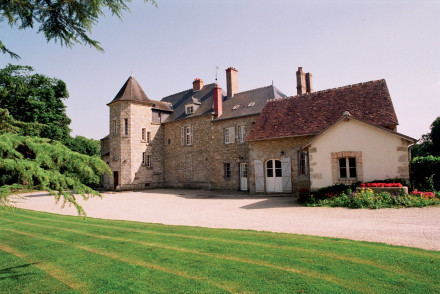
Once an ancient hunting lodge, this grand 18th-century château is filled with character. Offering comfortable and individually styled bedrooms with en suite bathrooms, each room has its own fireplace and rustic wooden floors. Enjoy beautiful views over the surrounding park. A tranquil hideaway. See More
Chateau Hotel de Belmesnil Rouen (St. Denis le Thiboult) 10 rooms from £135

A picture perfect chateau boasting a secluded spot in Normandy. Elegant rooms are traditionally dressed with sunny hues, antiques and indulgent bathrooms. Beautifully restored reception rooms are ideal for glamorous events. A charming French escape. See More
Chateau de Chantore Avranches 5 rooms from £204

A stunning chateau hidden amongst rolling parkland in rural Normandy. The rooms are resplendent with beautifully embroidered furniture, antique beds and period wall papers. For an amazing hotel, full of heritage, Chateau de Chantore is the place. See More
Chateau de Blavou Mortagne-au-Perche, Normandy 7 rooms from £152

A picture-perfect castle set in the picturesque Normandy-Perche regional country park. Interiors are suitably grand filled with antiques. Enormous rooms boast four-poster beds and equally large (and indulgent) bathrooms. With numerous activities on its doorstep, this is the perfect rural escape. See More
Chateau de la Pommeraye La Pommeraye, Normandy 5 rooms from £143

A half-moated chateau in a picturesque rural setting. Elegance interiors are classic in design with Louis XVI furniture, Italianate stairwells, sumptuous bedrooms, and fairytale views. A stately home (also available for exclusive use) perfect for couples, groups, or families. See More
Château Saint Gilles Bayeux (Guéron) 9 rooms from £181

This charming hotel is nestled in a converted 18th-century château close to Bayeux in Normandy. Inside, guestrooms and apartments are bright and contemporary, while tall windows and heritage fireplaces attest to the property's heritage - a chic and comfortable place to rest after local sightseeing. See More
Chateau de Canisy Saint Lo 17 rooms from £340

A fairy-tale like chateau set on a 700 acre estate. Beautifully kept throughout, the property offers numerous reception rooms filled with antiques and boasting roaring fires. Elegant rooms are individually styled with rich hues, patterned wallpaper and heavily draped bed heads. A luxurious stay. See More
Chateau de la Ferriere Bayeux 5 rooms from £278

A stunning 18th century chateau boasting a scenic and tranquil location just outside Bayeux. A handful of elegant rooms are traditional yet unfussy with a choice selection of antiques, floor to ceiling windows and indulgent bathrooms. A delightful base from which to explore the region. See More
Chateau de Pont Rilly Normandy 4 rooms from £156

A grand and beautifully restored 18th-century chateau, steeped in history and full of charm and character. Traditional rooms feature marble fireplaces, antique furniture and parquet floors. The chateau is surrounded by sweeping landscaped gardens and small canals. A quintessential French rural stay. See More
Chateau de Beneauville Cabourg 5 rooms from £165

A whimsical Renaissance château set within 50 acres of grounds. Interiors brim with character, expect: elegant antiques, tapestries, working fireplaces and classic french patterns. There's plenty to do within the property from fishing to cycling and it's also well positioned to explore the region. See More
Chateau La Cheneviere Bayeux (Normandy) 29 rooms from £237

A luxurious 18th-century chateau on the coastline. Traditional and elegant interiors include enormous rooms and suites, a classical French restaurant, and an inviting bar. With a pool and tennis courts within the picturesque grounds - this is the complete package for a french rural getaway. See More
Chateau de Bouceel Normandy 5 rooms from £152

A gorgeous 18th-century chateau steeped in history. Bedrooms provide character and comfort in equal measure with pretty furnishings, wall panelling and parquet flooring. The garden and swimming pool offer a spot for relaxation after a day of exploring. A grand country escape. See More
Chateau d'Audrieu Normandy 29 rooms from £227

A stunning 18th-century chateau set in beautiful grounds. Opulent rooms feature antique furniture and classic wallpapers. Boasting expansive gardens, an outdoor pool, & tennis court. Fantastic regional cuisine and luxurious interiors have fireplaces and beams. Romantic, gourmet, and very relaxing. See More
Chateau de Bonnemare Normandy 4 rooms from £117

A charming B&B chateau set within picturesque parkland. Unique rooms exude elegance with four poster beds, French moulding on the walls, and traditional bathrooms. With pretty gardens, a chapel, a farm and a cider press in the grounds - this is an authentic rural French getaway. See More
Chateau les Cedres Caen (rue de Bayeux) 5 rooms from £149

An imposing sand yellow chateau set within mature gardens in the pretty town of Bretteville l’Orgueilleuse. Simply styled rooms are traditional yet unfussy with polished wooden floors, white washed walls and exposed beams. A family friendly hotel offering easy access to Normandy's main attractions. See More

Written by Kat Parr Mackintosh
Search the best hotels in Normandy
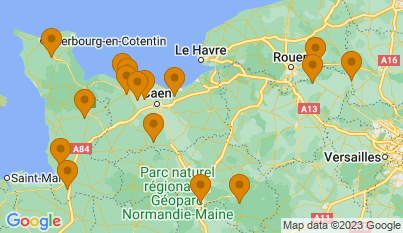
- Where To Stay
- Holiday Rentals
- Privacy Policy
- Terms of Use
- Ask the Guru

Normandy places to visit and attractions
Below you can explore some of the most popular highlights and places of interest in the Normandy region. See also our Normandy travel guide .

Alencon (Orne)

Argentan (Orne)

Arromanches (Calvados)

Bagnoles de l'Orne (Orne)

Barfleur (Manche)

Bayeux (Calvados)

Belleme (Orne)

Beuvron (Calvados)

Cabourg (Calvados)

Caen (Calvados)

Cambremer (Calvados)

Caudebec-en-Caux (Seine-Maritime)

Chateau de Beaumesnil (Eure)

Chateau de Boutemont (Calvados)

Chateau de Harcourt (Eure)

Chateau Gaillard (Eure)

Cherbourg (Manche)

Coutances (Manche)

Creully (Calvados)

Deauville (Calvados)

Dieppe (Seine-Maritime)

Dives-sur-Mer (Calvados)

Domfront (Orne)

Etretat (Seine-Maritime)

Eu (Seine-Maritime)

Evreux (Eure)

Falaise (Calvados)

Fecamp (Seine-Maritime)

Giverny Gardens (Eure)

Granville (Manche)

Haras du Pin (Orne)

Honfleur (Calvados)

Houlgate (Calvados)

Jumieges Abbey (Seine-Maritime)

La Bouille (Seine-Maritime)

Le Bec-Hellouin (Eure)

Le Havre (Seine-Maritime)

Le Perche (Orne)

Le Treport (Seine-Maritime)

Les Jardins du Pays d'Auge (Calvados)

Les-Petites-Dalles (Seine-Maritime)

Lessay abbey (Manche)

Lisieux (Calvados)

Lisieux Basilica (Calvados)

Lyons-la-Foret (Eure)

Mont-Saint-Michel (Manche)

Mortagne-au-Perche (Orne)

Normandy landing beaches (Calvados)

Pont-Audemer (Eure)

Rouen (Seine-Maritime)

Saint-Ceneri-le-Gerei (Orne)

Saint-Valery-en-Caux (Seine-Maritime)

Sees (Orne)

Trouville (Calvados)

Varengeville-sur-Mer (Seine-Maritime)

Vernon (Eure)

Veules-les-Roses (Seine-Maritime)

Veulettes-sur-Mer (Seine-Maritime)

Villers-sur-Mer (Calvados)

Villerville (Calvados)

Vire (Calvados)

Yport (Seine-Maritime)
For more information see the Normandy guide
Tourist attractions to visit in Normandy
The following sites have received official "tourist classifications"...
Estran Cité de la mer
Grand Sites of France
Baie du Mont Saint-Michel: See tourist guide
UNESCO world heritage sites
Le Havre: See tourist guide
Mont-Saint-Michel (monuments on French pilgrim routes): See tourist guide
Saint-Vaast-la-Hougue tours (Vauban fortifications)
Villages classified as "most beautiful villages"
Barfleur: See tourist guide
Beuvron: See tourist guide
Lyons-la-Foret: See tourist guide
Saint-Ceneri-le-Gerei: See tourist guide
National Monuments
Abbey of Bec-Hellouin: See tourist guide
Carrouges Chateau
Towns classified as Recommended Detours
Argentan: See tourist guide
Domfront: See tourist guide
Eu: See tourist guide
Forges-les-Eaux
Granville: See tourist guide
Honfleur: See tourist guide
Pont-Audemer: See tourist guide
Regional Natural Parcs
Marais du Cotentin et du Bessin
Normandie-Maine
Perche: See tourist guide
Secteur Sauvegardé (protected historical town centre)
Bayeux: See tourist guide
Rouen: See tourist guide
Towns of Art and History
Coutances: See tourist guide
Dieppe: See tourist guide
Fecamp: See tourist guide
Ville d'etape
Torigni-sur-Vire
Villedieu-les-Poeles
Villers-Bocage
4* Towns in Bloom
Cabourg: See tourist guide
Cherbourg: See tourist guide
Notre-Dame-de-Gravenchon
Saint-Fraimbault
Saint-Valery-en-Caux: See tourist guide
Zoo or wildlife park
Parc zoologique de Champrepus
Parc zoologique de Clères
Parc zoologique de Jurques
Parc zoologique de Lisieux
French Places
We can help you visit any town, village or region of France...
Popular & Useful
① Ideas & inspiration ② Maps of France ③ Explore by region ④ Route planner ⑤ Places (by dept.)
France This Way copyright 2006 - 2024
- Cookies & privacy
- Index of places

23 Top-Rated Attractions & Places to Visit in Normandy
Written by Lisa Alexander Updated Apr 25, 2022 We may earn a commission from affiliate links ( )
With its beautiful, varied scenery and rich history, Normandy has much to offer visitors. This distinctive region in northern France boasts a gorgeous countryside, coastline, and woodlands, as well as impressive castles, splendid churches, and picturesque ancient towns such as Rouen.
One of France's most emblematic tourist sights , Mont Saint-Michel, and the summertime seaside resorts of Honfleur and Deauville, are among the top attractions of the region.
Along the Channel coast, dramatic limestone cliffs drop off into the ocean, while Lower Normandy is characterized by verdant, peaceful valleys. An idyllic pastoral area known as the "Suisse Normande" ("Norman Switzerland") attracts nature lovers and outdoor sports enthusiasts.
For WWII history buffs, visiting Normandy is essential. During the Second World War, Normandy was heavily affected by the German Occupation and was the site of Allied landings in 1944. Tourists can visit the military cemeteries; memorial museums; and the D-Day landing beaches , including Omaha Beach and Arromanches Beach.
From beach resorts and fishing villages to medieval towns and Gothic castles, this region offers countless things to do and appeals to all types of travelers. Plan your vacation with our list of the best attractions and places to visit in Normandy.
Mont Saint-Michel
Caen memorial museum, bayeux and the bayeux tapestry, omaha d-day landing beach and museum, giverny: monet's house & gardens, suisse normande (norman switzerland), château de fontaine-henry, château de caen, memorial museum of the battle of normandy in bayeux, arromanches d-day museum, le bec-hellouin, côte fleurie, map of attractions & places to visit in normandy.
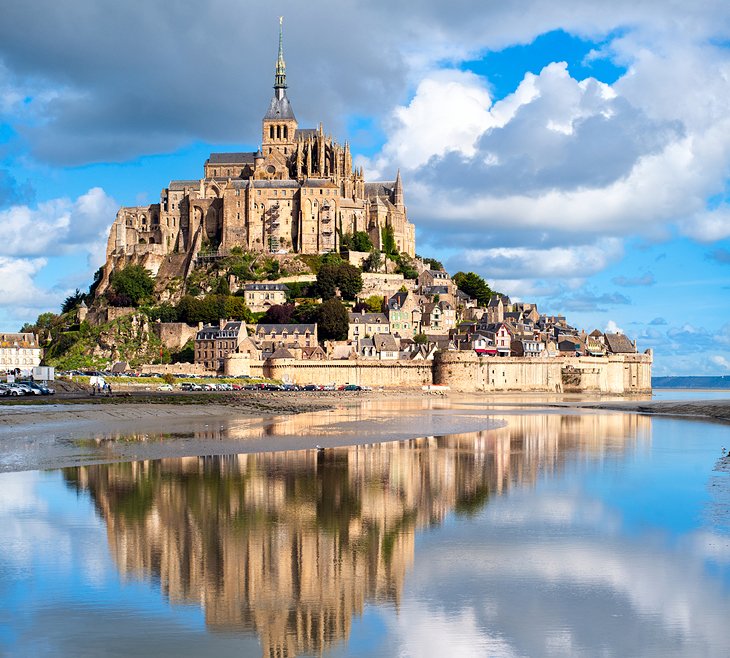
An important medieval pilgrimage destination, Mont Saint-Michel is a UNESCO World Heritage Site . Both the Abbey of Saint-Michel and the Bay of Saint-Michel are protected under this designation.
Soaring more than 100 meters above the sea, the Abbey of Saint-Michel has a mythical quality. The awe-inspiring Gothic spires seem to reach towards heaven as the site beckons pilgrims to cross the foreboding Bay of Saint-Michel.
During low tide, it's possible to complete a " traditional crossing " (a pilgrimage by foot) to reach Mont Saint-Michel. Accredited licensed guides are available to accompany pilgrims across the bay. During high tide, Mont Saint-Michel becomes an island only accessible by one road.
One of the highlights of a visit to Mont Saint-Michel is the Abbey Church , reached by climbing a 200-meter pedestrian path and then 350 steps to the highest point of Mont Saint-Michel. Built in the 13th century, the Abbey Church has a serene Romanesque sanctuary and a glorious Gothic choir.
The " Escalier de Dentelle " (staircase) leads from the Abbey Church up to a terrace, which affords breathtaking panoramic views of the sea.
Mont Saint-Michel is one of the most-visited tourist attractions in France and ranks among the top day trips from Paris . For travelers based in Paris, the easiest way to see Mont Saint-Michel is by taking an organized tour , but there are other options. Some of the best ways to get to Mont Saint-Michel include driving and taking the bus or the train.
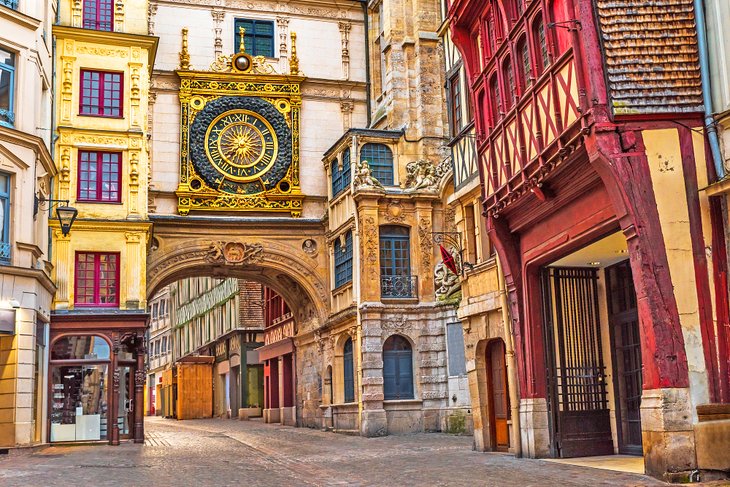
Wandering around the old town of Rouen, visitors will enjoy the historical ambience found in the winding cobblestone lanes, which are lined with maisons à colombages (half-timbered houses). Gothic churches are found at every turn, and many are gems of medieval architectural achievement.
The town's impressive Cathédrale Notre-Dame was depicted by Claude Monet in a series of paintings that show the intricate details of the cathedral's facade at different times of day. Another iconic monument in Rouen is the Gros-Horloge clock tower in the center of town.
Among the top attractions of Rouen is the Musée des Beaux-Arts , which ranks among France's most outstanding museums of fine arts. The collection includes masterpieces of European painting, with an especially noteworthy assortment of Impressionist works.
Rouen is also well known as the location where Joan of Arc was brought to trial. Tourists can see the tower where this courageous young woman stood before her judges and the spot where she was burned at the stake. She later became a saint, and now there is a contemporary church (the Eglise Jeanne d'Arc ) dedicated to her invincible spirit, on the site where she was martyred.
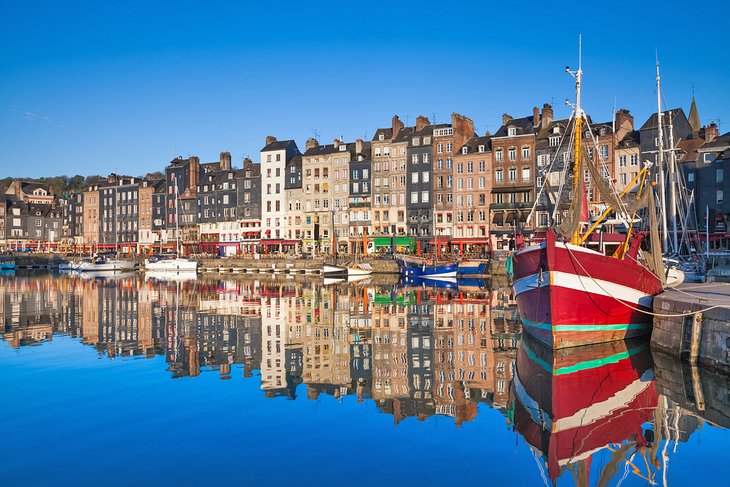
With its picturesque old harbor on the Seine estuary, Honfleur is one of the most charming towns in Europe . About 25 kilometers away from Le Havre, the town has atmospheric cobblestone streets, old stone buildings, and half-timbered houses.
This historic seafaring port was where travelers embarked on voyages to Canada in the 16th century. On the north side of the harbor is the 16th-century Lieutenancy Building , the old governor's house, built on the remains of the town's ancient walls.
One of Honfleur's most noteworthy attractions, the Musée de la Marine (Maritime Museum), is housed in the former Eglise Saint-Etienne, which dates back to the 14th century. The Maritime Museum tells the history of seafaring, fishing, and shipbuilding in Honfleur.
The Musée Eugène Boudin (Rue de l'Homme de Bois) is a must-see attraction for lovers of Impressionist art. Boudin's paintings and drawings represent nearly half of the collection; the rest includes pieces by other Impressionist artists such as Gustave Courbet, Eugène Isabey, and Paul Huet who painted scenes of the Normandy coastline.
The Musée Eugène Boudin also has an annex devoted to religious art, located in the freestanding belfry of the Eglise Sainte-Catherine . An interesting tourist attraction in itself, this Late Gothic church was built by local shipwrights after the Hundred Years' War.
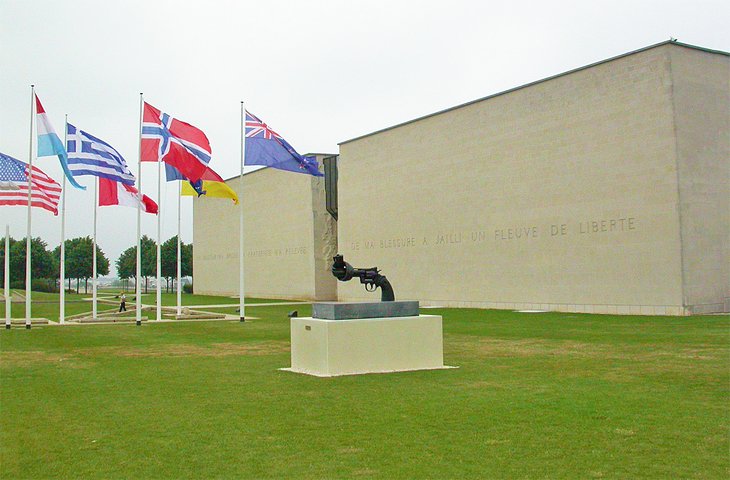
In Lower Normandy near the English Channel, Caen played a critical role during the Nazi Occupation of World War Two. Caen is an excellent starting point for a tour of the Normandy D-Day Beaches and Memorials .
Three-quarters of the town was destroyed during the Allied landings in June and July of 1944 (although its historic churches survived almost entirely unscathed).
Created as a tribute to Caen's suffering during the war, the Mémorial de Caen (Caen Memorial museum) tells the story of the Second World War, the D-Day Landings, and the Battle of Normandy.
Beneath the Caen Memorial museum is the site of General Richter's Headquarters , which was a command post during the German Occupation.
The Mémorial de Caen is also the Centre for History and Peace in Normandy , which aims to educate the public and promote the concept of reconciliation. The center hosts events such as temporary art exhibits and a Human Rights Competition.
Address: Esplanade Général Eisenhower, Caen
Official site: http://normandy.memorial-caen.com
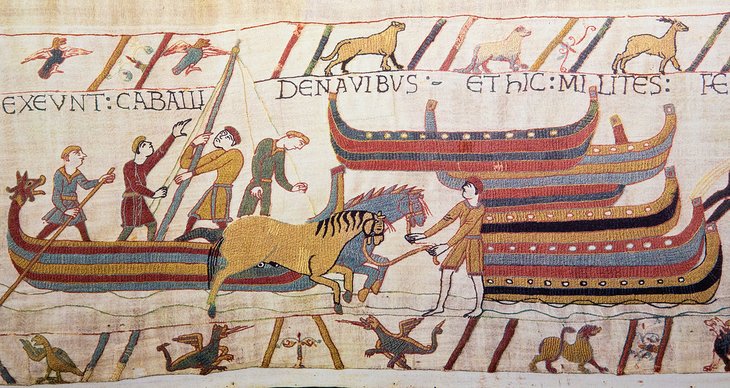
The town of Bayeux is best known for the Bayeux Tapestry, on display at the Bayeux Museum (13 bis Rue de Nesmond). An 11th-century masterpiece of medieval art, the Bayeux Tapestry is actually a work of embroidery, woven from wool yarn in 10 different shades.
The 70-meter-long Bayeux Tapestry depicts the story of the conquest of England in 1066 by the Duke of Normandy (known as "William the Conqueror"), through the Battle of Hastings . The Bayeux Tapestry is also called the Toile de la Conquête ( Cloth of Conquest ) and the Tapisserie de la Reine Mathilde ( Queen Matilda's Tapestry, in reference to William's wife).
Because of its cultural value as an artifact of historical documentation, the Bayeux Tapestry has been inscribed with a UNESCO "Mémoire du Monde" designation . Rendered in exquisite detail, the Bayeux Tapestry depicts 58 different scenes (in a format similar to a comic strip) in incredible detail, including 623 figures, 759 animals, and 37 buildings and ships, along with a running commentary in Latin.
Visitors should also take time to discover the old town of Bayeux, an enchanting medieval world of half-timbered houses, elegant mansions, and stately townhouses.
At the center of the old town is the well-preserved Cathédrale Notre-Dame , one of the finest examples of a Norman Gothic church. The cathedral was built over several centuries (from the 11th century to the 15th century), and as a result, blends Romanesque with Gothic architectural elements, including Early Gothic and Flamboyant Gothic styles.
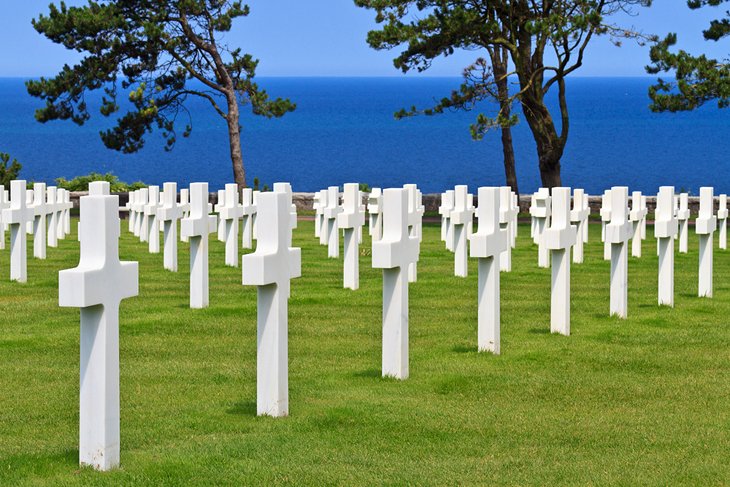
Omaha Beach extends for more than 10 kilometers between Port-en-Bessin past Vierville-sur-Mer and Colleville-sur-Mer to the mouth of the Vire River, a dramatic coastline along the English Channel made difficult to access by the sheer cliffs that rise 30 meters above the sea.
The largest and most famous of the five Normandy D-Day Landing Beaches , Omaha Beach is where the American 1st and 29th Infantry Divisions landed, along with other U.S., British, French, and Canadian troops on June 6th, 1944, which marked the beginning of Operation Overlord (also known as the "Battle of Normandy").
Visiting this site provides a chilling impression of the deadly battle, one of the bloodiest scenes of fighting during the D-Day Invasion, that took place here. Remnants of German bunkers and military piers can still be seen along the cliff-fringed coastline.
The American Cemetery in Colleville-sur-Mer overlooks Omaha Beach. The cemetery contains more than 9,000 perfectly aligned gravestones, which makes it the biggest American cemetery in Normandy.
Near Omaha Beach and the American Cemetery is the Overlord Museum , which chronicles the history of the Allied landings and the liberation of Paris. The museum's collection includes war vehicles, tanks, and guns, as well as soldiers' personal items.
Address: Overlord Museum, Rond-point d'accès du Cimetière Américain, Lotissement Omaha Center, Colleville-sur-Mer
Official site: www.overlordmuseum.com
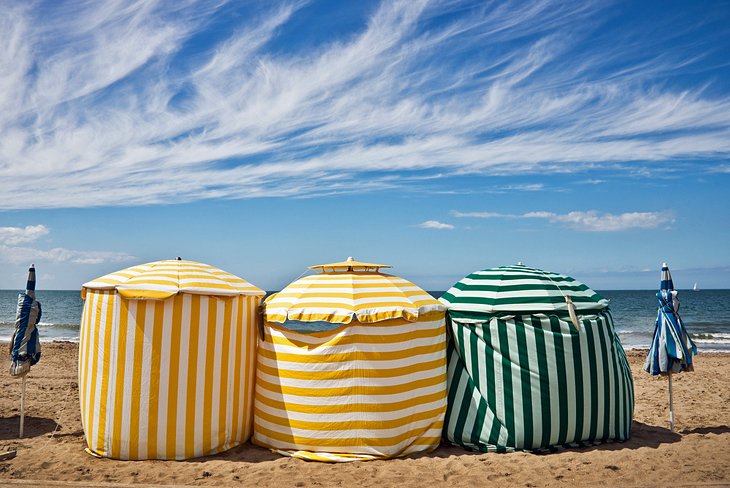
Since the 19th century, Deauville has been a premier seaside resort in Normandy. This glamorous vacation spot is still considered one of the top beach destinations in France .
The seafront features two kilometers of sandy shoreline and a promenade (boardwalk) for seaside strolls. Lifeguards are on duty daily during the high season (July and August).
Fitting of a glamorous beach destination, amenities abound, including places to rent parasols, lounge chairs, and old-fashioned striped cabanas.
Holiday-goers can take a break from sunbathing at the beach to browse the stylish boutiques, get a spa treatment, or dine at one of the many gourmet restaurants. Other things to do include sailing, golfing, and attending equestrian competitions.
Deauville lives up to its reputation as an internationally renowned resort with its array of prestigious events, including the International Polo Championship, held at Deauville's modern nine-hectare equestrian complex, and the Deauville American Film Festival .
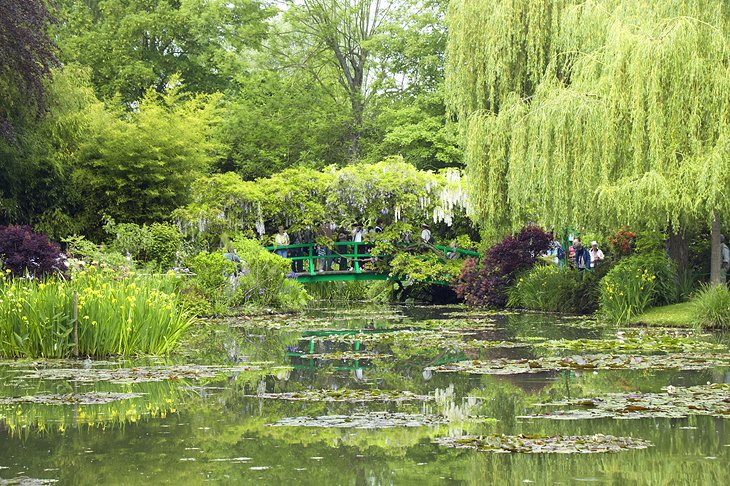
For lovers of Impressionist art, Monet's House & Gardens is an exciting place to visit, because the lush flowering property inspired so many of the artist's paintings. Claude Monet and his family settled at this charming location in Giverny (one hours' drive from Rouen) in 1883, and the artist spent the rest of his life here.
In front of the house is Le Clos Normand garden, which was created by Claude Monet. From springtime through autumn, this garden blooms with a profusion of colorful blossoms, including daffodils, pansies, tulips, irises, peonies, daisies, roses, poppies, hollyhocks, and dahlias, planted in a natural way so that they look like wildflowers.
On the other side of the property is Le J ardin d'Eau (Water Garden) featuring a Japanese bridge and waterlily pond fringed with weeping willow trees. The water garden was depicted in Monet's Water Lilies series of paintings. Monet devoted many years to painting different aspects of this garden, capturing its beauty in his delicate brushstrokes.
In the town of Giverny, the Musée des Impressionnismes Giverny (99 Rue Claude Monet) presents over 200 Impressionist paintings, as well as temporary exhibitions. The Impression Museum is surrounded by a meadow and also has a lovely garden with landscaping reminiscent of Monet's Garden.
Nearby in the town of Vernon (about a 10-minute drive), the Musée de Vernon showcases several masterpieces painted by Monet, along with works by other Impressionist artists (who belonged to the Giverny colony of painters).
Address: Monet's House & Gardens, Rue Claude Monet, Giverny
Official site: http://giverny.org/gardens/fcm/visitgb.htm
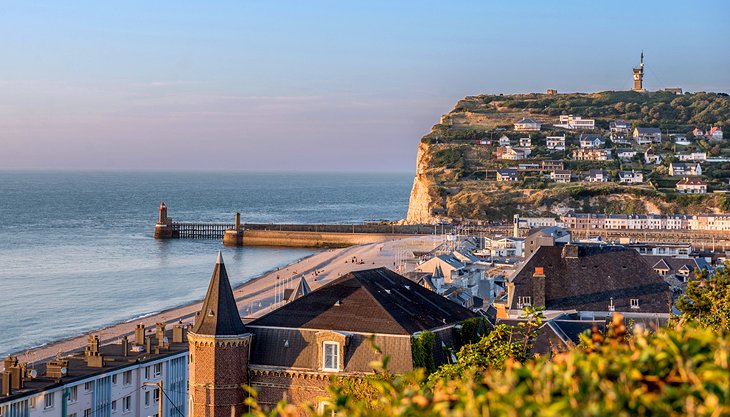
A favorite beach vacation destination on the Côte d'Albâtre, Fécamp is one of the best places to visit in Normandy for a relaxing holiday break. Established in 1832, Fécamp was one of France's first seaside resorts, known for attracting a high-society crowd. Today, sunbathers and socialites alike enjoy the refreshing ocean scenery .
Apart from the fishing harbor , the main tourist attraction here is the old abbey church of Sainte-Trinité , originally built in the 12th and 13th centuries. The interior is remarkably spacious with an exquisite choir and Renaissance altar.
The medieval pilgrimage chapel, Notre-Dame-du-Salut, stands on a steep chalk cliff to the north of town.
The writer Guy de Maupassant was born in Normandy and spent his early years in Fécamp, and some of his stories are set in the town.
About 11 kilometers away is the village of Valmont with an ancient castle and the ruins of a 12th-century abbey.
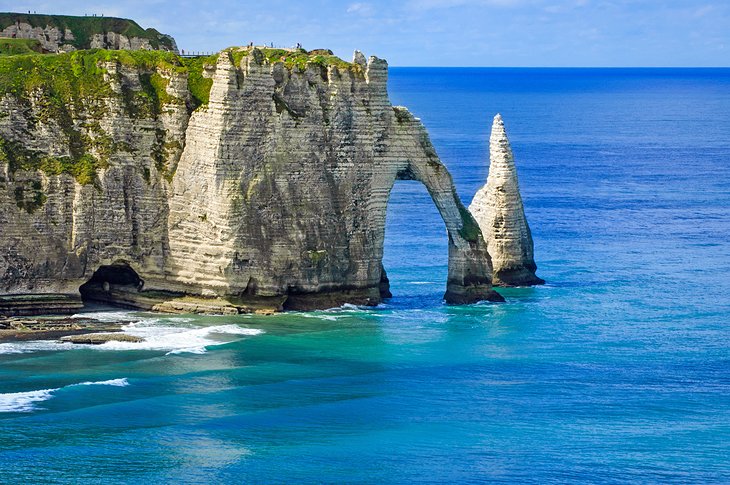
The seaside resort of Étretat is nestled at the foot of white limestone cliffs on Normandy's Côte d'Albâtre coastline. The cliffs reach 90 meters in height. From the viewpoint on top of the cliffs, the panoramic vistas are sensational.
The scenery of Étretat appealed to Claude Monet who spent a winter here in 1868. During his stay, Monet captured the dramatic landscapes and glistening waterfront in his paintings.
The beaches of Étretat delight sunbathers during the summer, and the ocean is a source of livelihood for fishermen who catch fresh seafood that is widely used in the local cuisine.
Étretat also has many attractive Belle Epoque villas , the most well-known is the Villa Orphée. The Villa La Guillette was built for the author Guy de Maupassant.
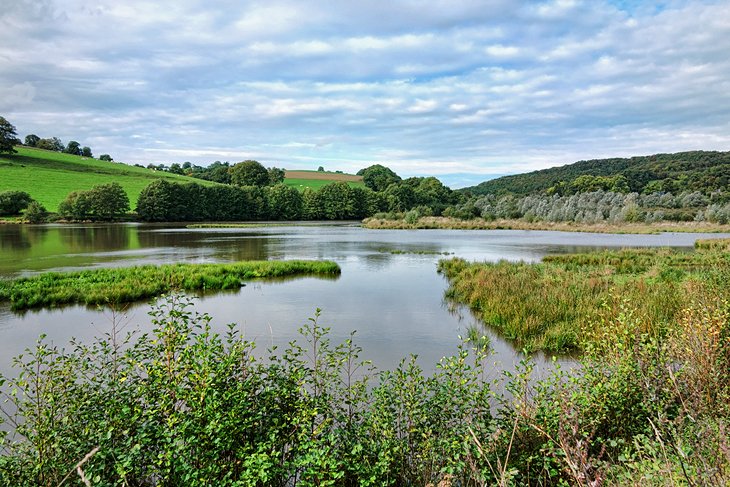
The name of Suisse Normande (Norman Switzerland) is given to the stretch of countryside in the Orne Valley of Lower Normandy, extending between Thury-Harcourt (south of Caen) in the north, Flers-de-l'Orne in the south, and Falaise in the east.
An idyllic piece of rural landscape, the Suisse Normande is characterized by its gently rolling hills, densely wooded forests, wide open space, steep gorges, and pristine lakes. The winding river, rocky bluffs along its banks, and the intricate patchwork of hedges give the scenery a particular charm.
The most striking features are the Rocher d'Oëtre , in the hilliest part of the area, and the superb view from above the gorges of the Rouvre River. Other scenic areas include the Vère and Noireau valleys and the stretch of the Orne Valley between Thury-Harcourt and Pont-d'Ouilly.
This area includes two regional parks: the Parc Naturel Régional Normandie-Maine and the Parc Naturel Régional du Perche ; both have well-maintained trails for nature walks and hikes. The Naturel Régional Normandie-Maine also offers opportunities to go canoeing or kayaking.
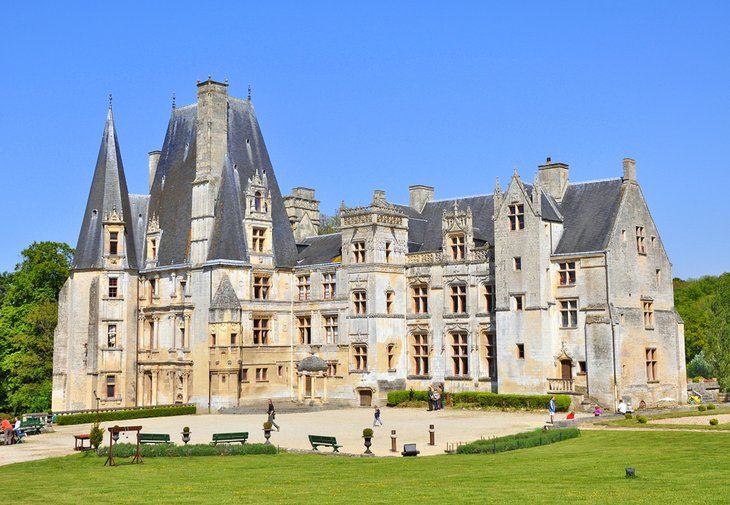
The most spectacular château in Normandy, the Château de Fontaine-Henry enjoys a peaceful setting in the lush Mue Valley of Lower Normandy (about 14 kilometers from Caen). The château was built in the beginning of the 13th century and is classified as a Historical Monument .
The Château de Fontaine-Henry has been privately owned for generations, by an aristocratic family that traces their ancestry to the year 1200. The current owner, the Marquis d'Oilliamson, on occasion leads guided tours of the château.
This remarkable château is a notable example of Gothic and Renaissance architecture with an imposing stone facade. The lavish interior is filled with gorgeous furniture and exceptional paintings , including works by Titian, Correggio, Rubens, Mignard, and Rigaud. There is also a separate 13th-century chapel, which was renovated in the 16th century.
Surrounded by forests, the château has an expansive parkland with walking paths and traditional games for visitors to enjoy. Within the park are three distinct gardens: the Jardin Notre-Dame, a medieval garden planted with vegetables and medicinal herbs; the Hortus Conclusus, an enclosed garden designed for religious meditation and spiritual reflection; and the Gerbe du Parnasse, a garden with a theme of Greek mythology.
Tourists may visit the Château de Fontaine-Henry on guided tours, available mid-April through mid-September. Tours are available in French and English, and printed content about the tour is available in English, Dutch, German, Spanish, and Russian.
Address: Place du Château, Fontaine-Henry
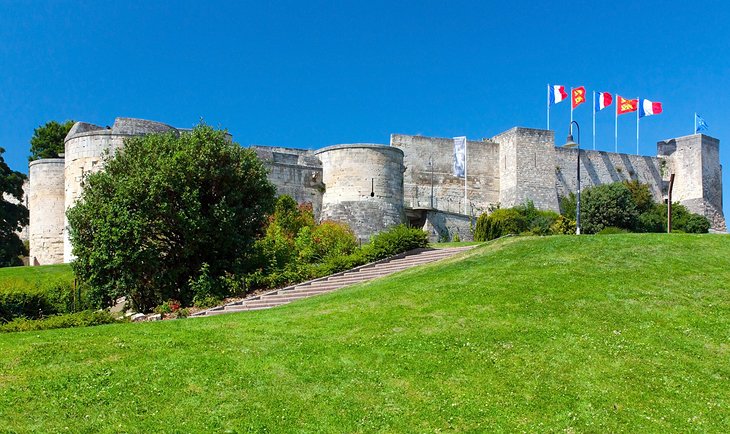
Guillaume le Conquérant (William the Conqueror) built this castle in 1060 when he was the King of England. The Château de Caen is one of the largest medieval monuments in Europe and a quintessential symbol of Caen's heritage.
During the Middle Ages, the château was a royal fortress, and it later served as an English stronghold during the Hundred Years' War and as army barracks for an infantry regiment during the Second World War.
The ramparts of the Château de Caen are among the largest castle fortifications in Europe. The northern rampart of the castle has been restored; from this viewpoint , visitors can admire panoramas of the Caen cityscape.
Rooms within the ramparts house the Musée de Normandie , a museum focused on the Normandy region's culture and history, including the history of the castle.
The château also displays the collection of the Musée des Beaux-Arts de Caen , which has an outstanding assortment of 16th- and 17th-century European paintings. The museum's treasures include masterpieces by Poussin, Rubens, Veronese, and Brueghel, as well as Impressionist paintings by Monet, Boudin, Corot, and Courbet.
The Château de Caen has a café, picnic area, and outdoor games on the grounds.
Address: Château de Caen, 14000 Caen
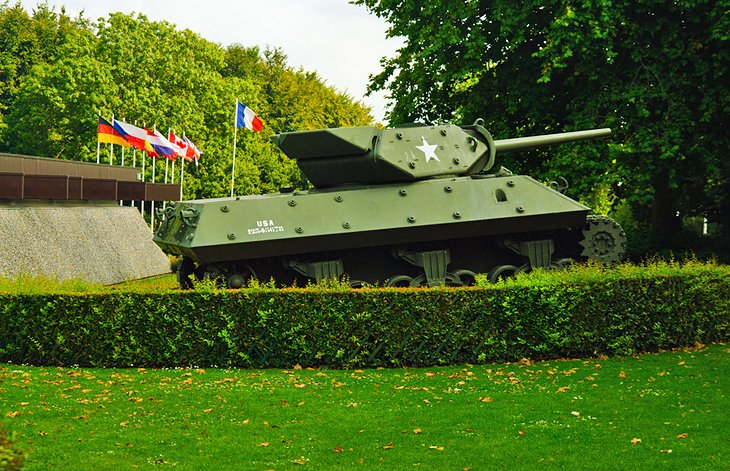
Bayeux has a British World War II cemetery as well as the Memorial Museum of the Battle of Normandy. This museum explains Normandy's involvement during the Second World War by outlining an overview of the wartime events.
With 2,300-square-meters of exhibition space, the museum does an outstanding job of recounting the Normandy Campaign , from the advancement of the Allied troops to D-Day on June 6th, 1944 and the liberation of Paris on August 25th, 1944.
The museum has an auditorium that shows the film Normandy '44, Decisive Victory in the West , based on archival documents. Created by a World War II historian, the film explains the major operations involved in the Battle of Normandy.
The museum also displays military equipment used during fighting on the Landing beaches, such as bulldozers, jeeps, and guns. The main aim of the museum is to share World War II history with the public and to serve as a place of remembrance , while honoring the memory of fallen civilians and soldiers.
Address: Boulevard Fabian Ware, Bayeux
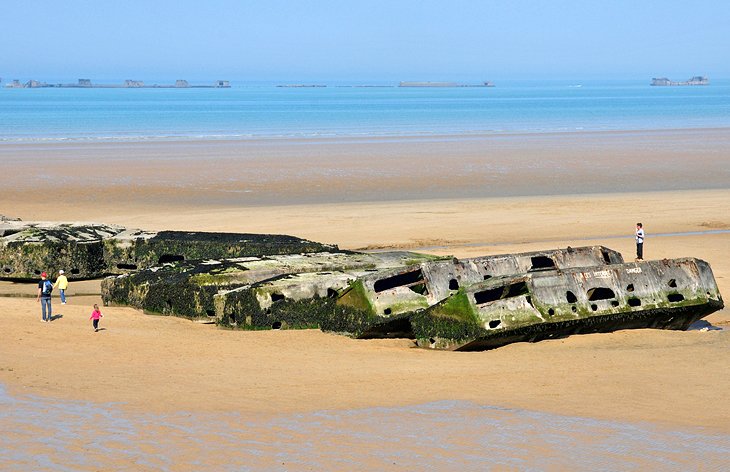
Near Omaha Beach, the D-Day landing beach (Gold Beach) of Arromanches was successfully captured by the British 50th Northumberland Division on June 6th, 1944 in a surprise offensive.
Because Arromanches does not have a natural harbor, the Allied forces had installed artificial harbors, known as the Mulberry Harbors . The Arromanches D-Day Museum overlooks the beach, close to the spot where one of the harbors was constructed. Remnants of the artificial harbor can still be seen on the sandy shore and in the waters near Arromanches.
The Musée du Débarquement (Arromanches D-Day Museum) illustrates the remarkable logistics and technical aspects of " Operation Mulberry ," which involved the building of the Mulberry Harbors. Exhibits describe the logistics required to create and use the Mulberry Harbors, while working models demonstrate how the artificial ports operated.
Visitors can also watch a documentary film featuring World War II archival footage. Near the museum are many cafés and shops on the bustling Place du 6 Juin square.
Address: Place du 6 Juin, Arromanches
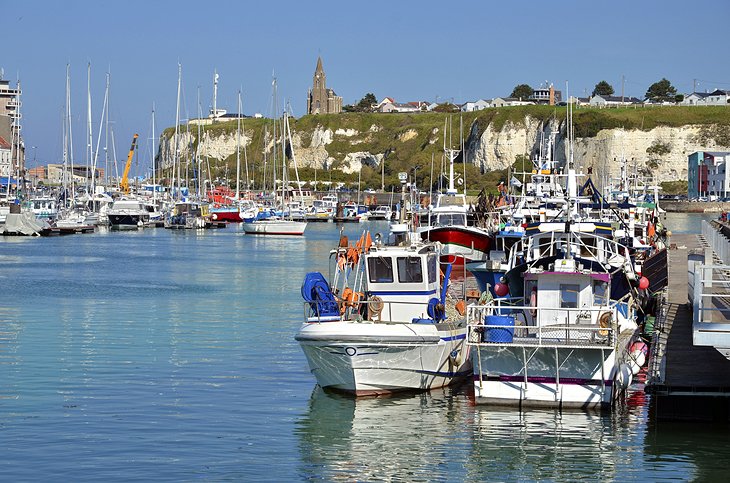
Historically a seafaring port, Dieppe became France's most stylish seaside resort in 1924 when the Duchesse de Berry came here to enjoy the ocean's fresh air and health benefits. The Duchess transformed the town (by having a ballroom and theater built) and made it a glamorous beach destination.
Today, visitors still come to enjoy Dieppe's beautiful broad seafront, an expansive space that includes a pebbly beach , promenade, children's playground , miniature golf course, and facilities for fishing and sailing. Unique to Dieppe, the seafront includes well-manicured lawns, where the International Kite Festival takes place every two years in September.
Above the beach, in a craggy cliff town, is the Château de Dieppe . This 14th-century castle contains the Musée de Dieppe , a multidisciplinary museum with an excellent assortment of European paintings from the 15th-century to the present day. Highlights include French Impressionist paintings, such as works by Pierre-Auguste Renoir, Camille Pissarro, and Eugène Boudin.
Northwest of the castle, the Boulevard de la Mer offers stunning sea views. In the center of the town is the pleasant Place du Puits-Salé and nearby are many cafés and pastry shops.
Dieppe has two important churches: the Baroque Eglise Saint-Rémy , built in the 16th and 17th centuries, and the Eglise Saint-Jacques , a striking Gothic church with ornately sculpted doorways and a richly decorated interior.
With today's recreational ambience, it's hard to imagine that Dieppe was the site of a tragic WWII event. On August 19th, 1942, the Allied forces (mainly Canadian) attempted a Raid on Dieppe , but the offensive was met by the German army with unexpectedly strong reinforcements. Over 900 Canadian soldiers were killed. Memorials in Dieppe honor the Canadian troops who perished during the Raid on Dieppe in 1942.
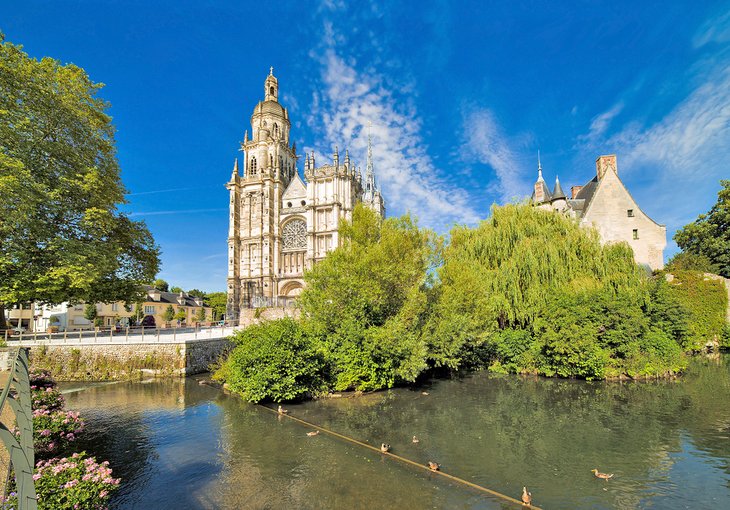
About a one-hour drive south of Rouen, the town of Evreux is worth a detour. The main tourist attraction is the Cathédrale Notre-Dame built in the 10th century. The cathedral's monumental nave still has Romanesque-era arches, although it was rebuilt in the 13th century in Gothic style. Illuminating the sanctuary are 70 splendid stained-glass windows, created between the 13th and 16th centuries and considered masterpieces.
Evreux also has a noteworthy 15th-century Palais Episcopal , which now houses the Musée d'Art, Histoire et Archéologie displaying a diverse collection of ancient artifacts; historical objects; and European paintings from the 17th, 18th, and 19th centuries.
Other noteworthy sites in Evreux include the Tour de l'Horloge (Clock Tower), which dates from 1490, and the former Abbaye de Saint-Taurin (abbey church), which contains the 13th-century reliquary of Saint Taurin, an exemplary piece of goldsmith's work.
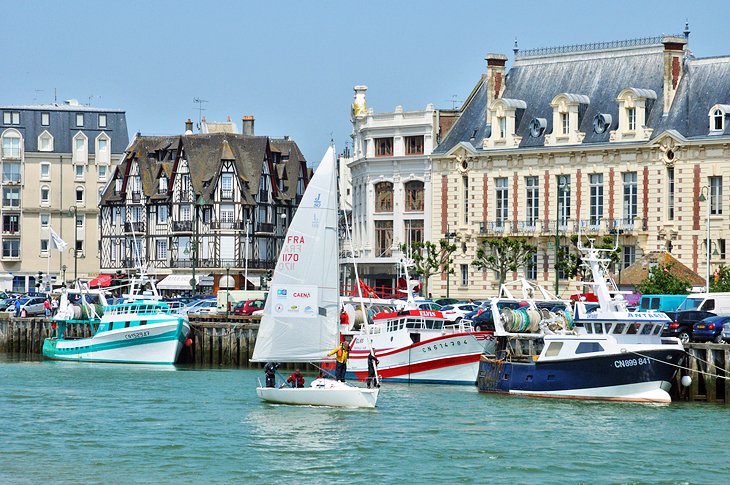
Although less upscale than the neighboring " Parisian Riviera " resort of Deauville (just two kilometers away), Trouville has a similar ambience. Like Deauville, Trouville was a fashionable seaside resort in the 19th century.
Trouville's broad sandy beach was once known as the " Queen of Beaches " and still attracts many visitors. Another tourist draw is the boating harbor for recreational sailing.
One highly recommended excursion from Trouville is a drive along the Corniche Normande , which skirts the coast high above the sea. This scenic drive offers extensive views all the way to Honfleur.
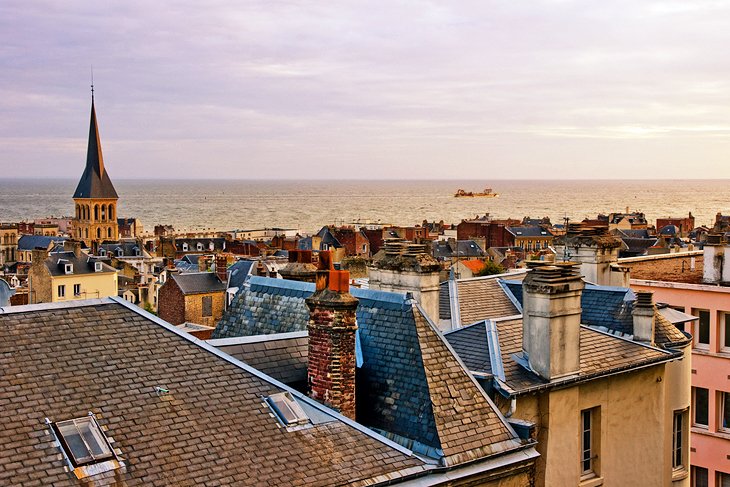
Built around the estuary of the Seine River, Le Havre is France's largest port after Marseilles. The town is surrounded by serene natural scenery: an expansive pebble beach and an attractive marina.
The setting appealed to Claude Monet. In 1872, he captured the landscape of Le Havre in his famous painting Impression, Soleil Levant ( Impression, Sunrise ) which is considered the first piece of Impressionist art.
Le Havre suffered much damage during the Second World War and was almost completely rebuilt with many buildings designed by the architect Auguste Perret. The modern city center offers interesting examples of 20th-century architecture, such as the Place de l'Hôtel-de-Ville with its functional tower blocks.
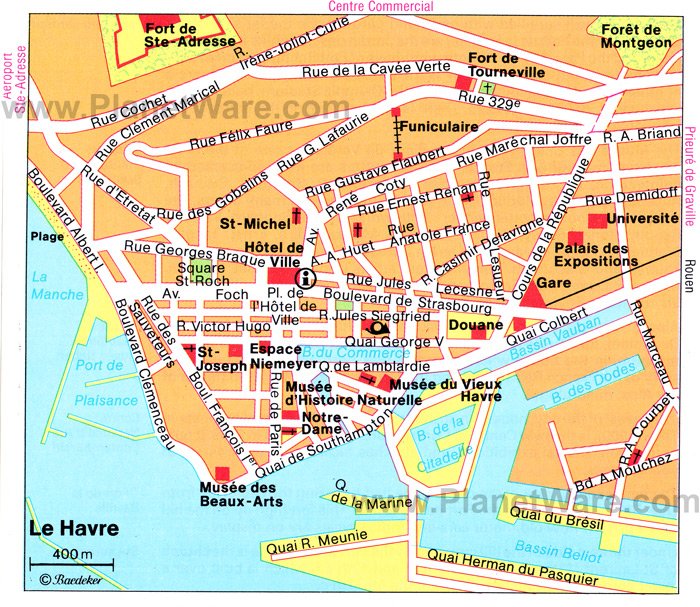
One of the prettiest of the villages that dot Normandy's rural landscape, Le Bec-Hellouin is listed as one of the Plus Beaux Villages de France (Most Beautiful Villages of France). This little country village is tucked away in a peaceful valley and has plenty of open green space with leafy trees.
Brimming with old-world charm, Le Bec-Hellouin has quaint flower-bedecked half-timbered houses clustered around an old church, the Eglise Saint-André . Tourists will also appreciate the village's selection of small inviting hotels and casual restaurants.
The village is renowned for its abbey, the Abbaye Notre-Dame du Bec founded in the 11th century and classified as a Historical Monument. Although the abbey was badly damaged in 1417 during the Hundred Years' War, the 15th-century Saint-Nicolas Tower remains intact. The main buildings exemplify Regency architecture, with unostentatious facades and harmonious classical proportions.
The Abbaye Notre-Dame du Bec is still a working monastery run by a community of Benedictine monks. Besides fulfilling their religious obligations, the monks produce handcrafted ceramics and provide guided sightseeing tours of the abbey.
Guided tours are available every day except Tuesdays. The grounds and the Eglise Abbatiale (Abbey Church) of the Abbaye Notre-Dame du Bec are open to the public, free of charge, every day except Tuesdays.
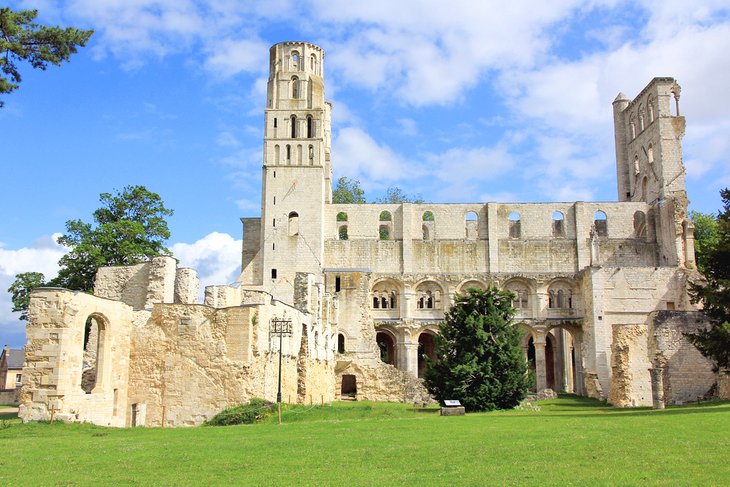
Another historic abbey is found 35 kilometers from Le Bec-Hellouin in Jumièges. Built in the 11th century, the Abbaye de Jumièges became an unsurpassed center of learning under the rule of William the Conqueror. In the 13th century, the church was enhanced in marvelous Gothic style, reflecting the grandeur of the abbey and its immense wealth.
Unfortunately, the abbey was mostly destroyed during the Hundred Years' War. However, the ruins reveal the prestigious past of a building that was once the most magnificent religious monument in Normandy.
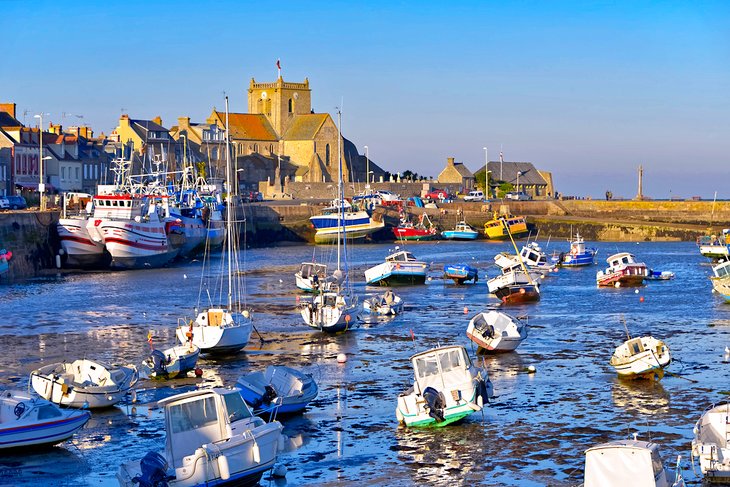
Barfleur is a characteristic Norman fishing village with handsome granite-stone houses lined up along the harbor. The town's picture-perfect quality has earned it a place among the Plus Beaux Villages de France .
During the time of William the Conqueror, Barfleur was a principal seafaring port for the Anglo-Norman kingdom because of its advantageous position on the English Channel. Today, Barfleur still has a busy fishing harbor, with small boats unloading fresh catches daily at the quays. The town's traditional seafood restaurants offer a chance to sample the tempting local cuisine.
With nearby beaches and coastal paths for taking nature walks, Barfleur is a popular destination for seaside getaways.
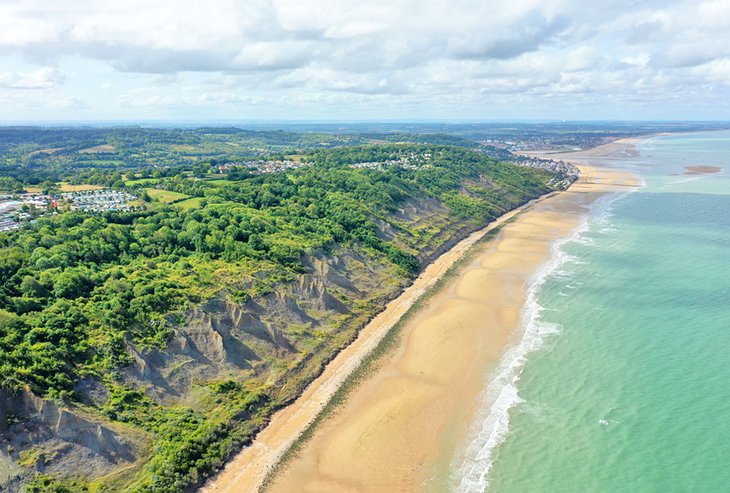
Normandy is prized for its gorgeous coastline, particularly the stretch known as the Côte Fleurie , which extends from Honfleur for about 45 kilometers to Merville-Franceville.
The name "Coast of Flowers" hints at its natural splendor. This bucolic landscape features meadows and apple orchards, alongside the coastline of dramatic cliffs and fine-sand beaches.
One especially scenic driving route is the portion from the Deauville to Cabourg (20 kilometers).

More on France


Home » Travel Guides » France » 15 Best Things to Do in Normandy (France)
15 Best Things to Do in Normandy (France)
Visiting Normandy’s sights means seeing monuments and scenery that we’ve known since childhood, first-hand.
This goes for Mont-Saint-Michel and the Bayeaux Tapestry, or all the scenes depicted in Claude Monet’s paintings, like the cliffs at Étretat, the harbour at Honfleur and the artist’s own gardens.
The impressionist movement was born in Normandy, inspired by Monet’s “Impression” of the sunrise at Le Havre.
Normandy was also famously the site of one of the most pivotal battles in the Second World War, and the coast is peppered with memorials, museums, bunkers and beaches .
Let’s have a look at the best things to do in Normandy :
1. Étretat Cliffs

Étretat, in the Seine-Maritime department, is a small coastal commune in the middle of a pretty big seascape.
On both sides of the town and its pebble beach are gigantic white limestone cliffs with three natural arches and a 55-metre needle.
On the beach you can look east to La Porte d’Amont, the smallest of the arches, or west to the colossal L’Arche et l’Aiguille, an image immortalised by Monet and Gustave Courbet.
Past these landmarks is Étretat’s widest arch, La Manneporte, which you can get to with a brief but very scenic stroll along the top of the cliffs on the GR21 trail.
2. Mont-Saint-Michel

One of the world’s iconic man-made sights, UNESCO-listed Mont-Saint-Michel is a tidal island at the mouth of the Couesnon River where Normandy and Brittany meet.
The island’s steep slopes have been crowned by a monastery since the 700s, but the whole ensemble really took shape in Norman times, when ducal patronage funded the sublime abbey at the top, as well as the tough fortifications below.
Mont-Saint-Michel had great strategic value and was almost impregnable, never succumbing to British attacks in the Hundred Years’ War.
The zigzagging path up to the majestic abbey at the crest will feel like something out of a fantasy adventure, provided there aren’t too many tourists around!
3. Honfleur

Another of the scenes in Normandy that inspired the impressionists is this endearing old port in the Calvados department, just across the Seine from Le Havre.
The view of the harbour from the Quai Saint-Etienne is heart-achingly pretty, looking across to the tall, narrow slate-clad houses behind the masts of moored sailboats.
This is just the starting point, as you have to see Saint-Catherine’s Church, a timber construction built by shipbuilders in the 15th century and resembling the hull of a boat.
The bell-tower, also made of wood, was built some way from the church in case of fire.
4. Tapisserie de Bayeaux

This world-renowned Anglo-Saxon embroidery is 70 metres long and half a metre high, depicting the events leading up to the Norman Conquest of England.
The tapestry is on display in its entirety in a glass case at this museum in Bayeaux.
A multilingual audio-guide clarifies every section as you go, from the visit of Harold Godwinson to Normandy to his demise at the hands of William the Conqueror’s forces on the battlefield in Hastings in 1066. Upstairs there’s also a short film to fill you in on the details and context, as well as an exhibition of contemporary artefacts.
5. Claude Monet’s House and Gardens

Monet lived at this elegant house in Giverny from 1883 to 1926. It’s now a museum, maintaining the artist’s home and studio as if he were alive.
It’s equally eerie and stirring to peruse the kitchen, bedroom, dining room, sitting room of one of the great artists, all very tasteful and colourful and not conforming to the dark tones in fashion in the late-19th century.
Lovers of Monet’s art will cherish the grounds, where the sunflowers, wisteria, Japanese footbridge and water lily pond appear can be clearly recognised from some his most famous works.
6. Tatihou Island

Like Mont-Saint-Michel Tatihou is a tidal island, opposite Saint-Vaast-la-Hougue.
At low tide you can walk across the oyster beds to get there, and when the sea’s up you can catch an amphibious craft.
It’s a site with lots of stories to tell, having witnessed a climactic naval battle between the Anglo-Dutch fleet and French in 1692 (12 French ships were sunk), and events during the Napoleonic war, when a British gun frigate grounded on the island.
It’s a peaceful place now, with a little maritime museum showcasing the finds recovered from the naval battles, a botanical garden and the bastion of the old sea fortress.
7. Notre-Dame de Rouen

This solemn cathedral is unique in France because its original 13th-century Episcopal palace is still part of the complex.
The cathedral itself is from the 11th century, a marvellous Norman gothic construction that was also the subject of a series of paintings by Claude Monet.
After renovations were made to the main spire in the 19th century, the cathedral, at 151 metres, was the tallest building in the world until 1880. Among the wealth of historical curiosities inside is the tomb of Rollo, a Viking noble who became the first ruler of Normandy in the early 10th century, and a tomb containing the heart of Richard the Lionheart.
8. Old Rouen

The historic centre of Rouen is one of the most delightful in France, with some 2,000 half-timbered houses, many of which are charmingly askew.
Nearly all of them date to before the 1500s, when this kind of building was deemed a fire hazard.
You can view these old buildings along pedestrianised cobblestone streets that also lead you past a host of gothic churches and sights like the Gros Horloge.
This is a marvellous astronomical clock, one of the oldest in the country, dating to the 1300s and installed above a renaissance archway from 1529. The Church of Saint-Ouen is also essential, a majestic piece of 14th-century Flamboyant Gothic architecture with an organ by Aristide Cavaillé-Coll, considered one of the finest in the world.
9. Le Havre

While some bomb-damaged cities elected to restore their old architecture after the war, Le Havre took a bold approach, embracing the possibilities of concrete.
This radical redesign, spearheaded by Auguste Perret, has earned the centre of the city UNESCO status and will definitely catch your eye if you appreciate modern architecture.
This is typified by the Église Saint-Joseph, completed in 1956, which has a slightly classical appearance, but takes advantage of the great self-supporting strength of its building material by containing not a single column in its central section.
The André Malraux Museum of Modern Art should not be missed, as it contains the second-largest collection of French Impressionist painting in the country: Degas, Renoir, Manet, Gauguin and Monet are all here.
10. Gastronomic Experiences

Plenty of French delicacies are native to Normandy, two of the tastiest of which are the cheeses, Livarot and Camembert.
At the town of Livarot, in the Calvados countryside, you can take a free tour around the Fromagerie Graindorge to see how four Normandy AOP cheeses are made: Neufchâtel, Livarot, Pont l’Evêque and Camembert, heaven for anyone with a taste for great cheese.
This part of Normandy is also lush with apple orchards, producing cider (there are four museum devoted to this drink), and calvados, an apple brandy.
Hit the Route du Cidre for an itinerary of presses and distilleries.
11. Airborne Museum

In the commune of Sainte-Mère-Église is a museum for the paratroopers who landed in the Normandy countryside beyond the beaches on the 5th and 6th of June 1944. This location was chosen because it was the first village to be liberated by American troops, and because of one John Steele, whose parachute got caught on the belfry of the church leaving him stuck for two hours.
It’s on the site of a house that was burnt down in the fighting and displays a large amount of documentary footage and photographs, as well as weapons, tanks, planes and a WACO glider.
One part puts you in the very boots of a paratrooper, as you get to enter a C-47 that was used in the Battle of Normandy.
12. Omaha Beach

You don’t need to be a military historian to appreciate the poignancy of this historic battlefield between Sainte-Honorine-des-Pertes and Vierville-sur-Mer.
It’s the site one of the defining events of the Second World War, and saw the bloodiest fighting of any of the D-Day beachheads on June 6 1944. There’s a monument by the road, and you can drop by at the Memorial Museum, which has first-hand accounts of life during the occupation and then testimonies by veterans about the attack in 1944. There are also exhibits of personal items belonging to soldiers from both sides.
13. Musée des Beaux-Arts de Rouen

This art museum in Rouen is also vital if you love impressionism.
This has a lot to do with François Depeaux, a turn of the century industrialist and art patron, who donated his massive collection to the museum in 1909. Renoir, Degas and Monet all feature, but the museum also has galleries with works dating back to the 1400s.
In fact, every major movement is covered, and renaissance and baroque masters like Veronese, van Dyck, Rubens, Caravaggio and Velázquez are all represented.
There’s also a set of rare Russian icons spanning the 1400s and 1800s.
14. Abbaye aux Hommes

The finest romanesque building in Normandy, made from Caen’s characteristic butter-yellow limestone, is home to the tomb of William the Conqueror.
When you see his final resting place you may be surprised by the modern-looking tomb: This is because it has been opened, moved and even destroyed over the last millennium.
So now there’s a relatively understated 19th-century marker made of white marble.
The abbey’s tranquil cloister was rebuilt in the mid-18th century in the Tuscan style, and outside you can find small remnants from when it was fortified for the Hundred Years’ War: There are two towers on Rue du Carel and Rue Lebailly.
15. Château Gaillard

This forbidding fortress is on a spur next to a kink in the River Seine and dominates the commune of Les Andelys.
It was built by Richard the Lionheart in just two years at the end of the 12th century, and fell to Philip II in 1204. In the centuries that followed it was contested by the English and French, but has been in French hands permanently since 1449. It was then demolished in the 16th century, but despite this there’s a lot to see, including most of the keep and inner bailey and large parts of the outer walls.
The panoramas of the river and the green countryside around Les Andelys are also hauntingly picturesque.
15 Best Things to Do in Normandy (France):
- Étretat Cliffs
- Mont-Saint-Michel
- Tapisserie de Bayeaux
- Claude Monet's House and Gardens
- Tatihou Island
- Notre-Dame de Rouen
- Gastronomic Experiences
- Airborne Museum
- Omaha Beach
- Musée des Beaux-Arts de Rouen
- Abbaye aux Hommes
- Château Gaillard
- 0 Favorites
Normandy Tourism, France
- Active & outdoor
- Lifestyle & Wellness
- Discover Normandy
- Plan your trip
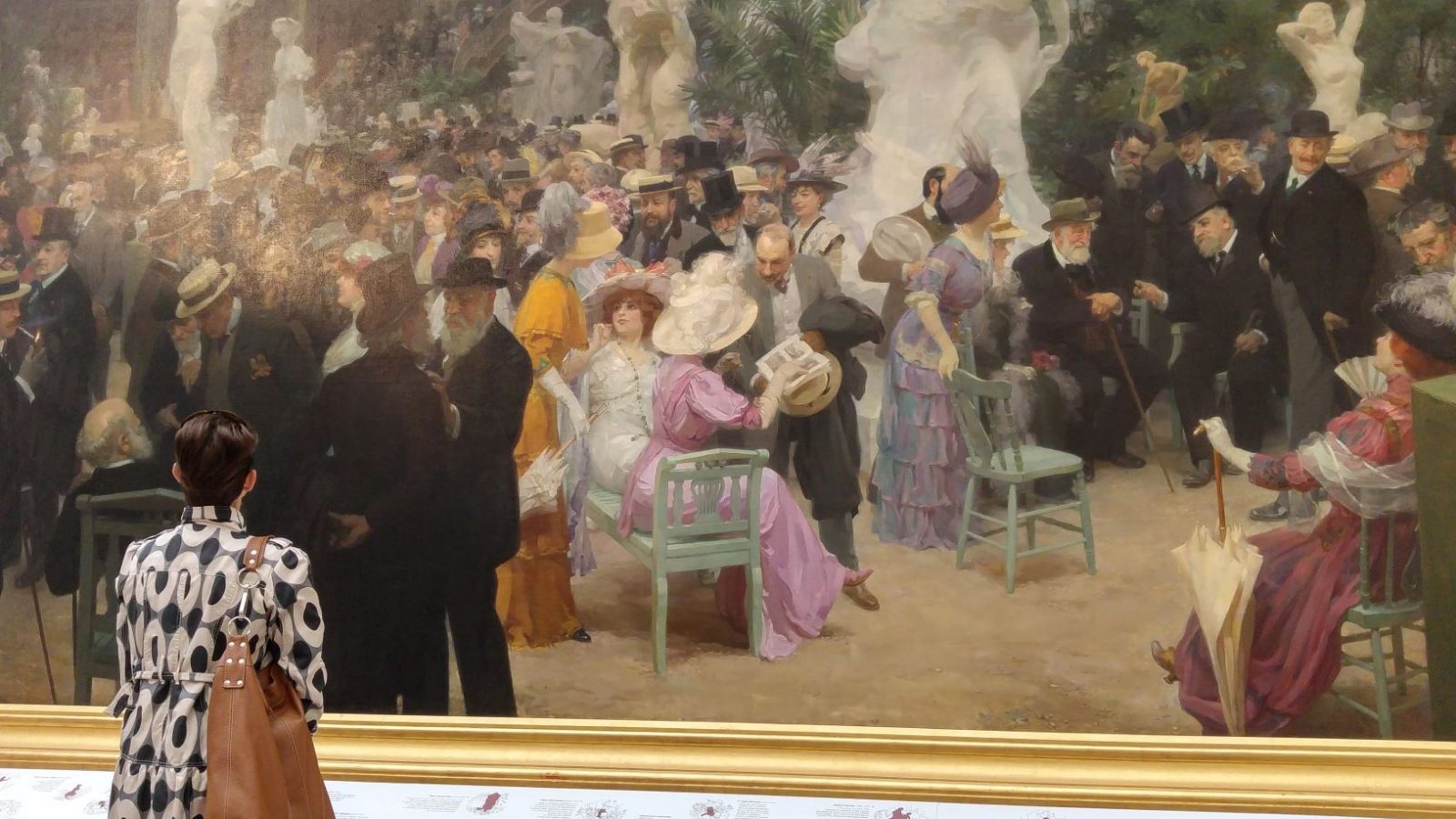
Impressionism celebrates its 150th anniversary in 2024
Fine art museum in Rouen © V. Joannon
Find out more
Normandy Experiences

Kayak Adventure and Riverside Aperitif Along the Seine

Off-Road Scooter Adventure & Aperitif in Quiberville-sur-Mer
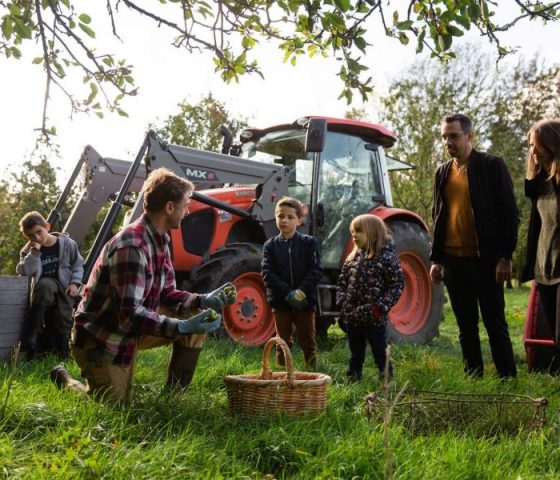
Making our own organic apple juice in Pays d’Auge
Immerse yourself in Normandy Experiences
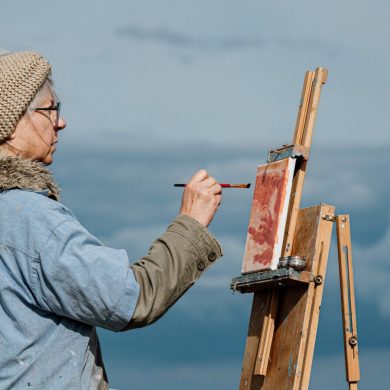
1874 – 2024: 150th Anniversary of Impressionism
Updated on 1 July 2024
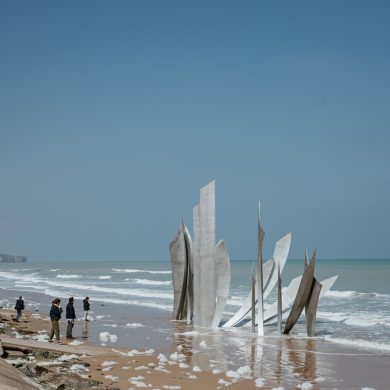
Exploring Normandy D-Day Landing Beaches without a car
Updated on 29 April 2024
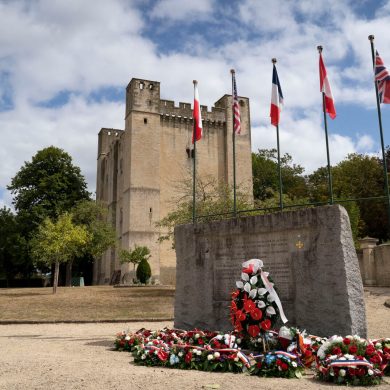
D-Day & the Battle of Normandy: 10 offbeat sites to explore
Updated on 5 September 2023
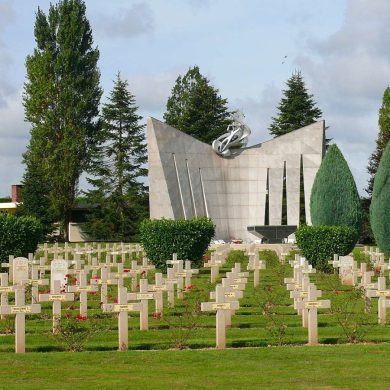
D-Day: 10 Unexplored Sites of Remembrance in Normandy
Updated on 11 July 2023
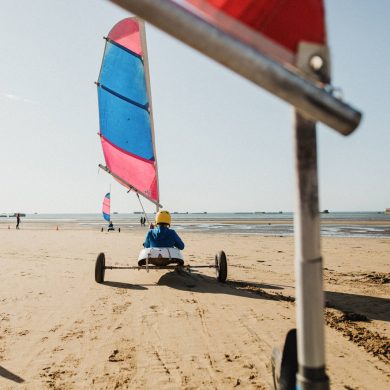
Explore the Past in Motion: History & Sports on D-Day Beaches
Updated on 8 January 2024
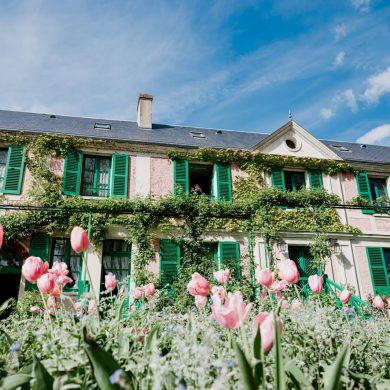
Touring Normandy’s Impressionist Sites Car-Free
Updated on 6 May 2024
See more articles
Major events

1944 – 2024: 80th Anniversary of D-Day and the Battle of Normandy
1 - 16 June 2024 (D-Day Festival) and beyond until December 14
Throughout Normandy

Normandy Impressionist Festival
22 March - 22 September 2024
Rouen, Caen, Le Havre, Cherbourg, Giverny, Honfleur, Fécamp, Saint Lô and across all of Normandy
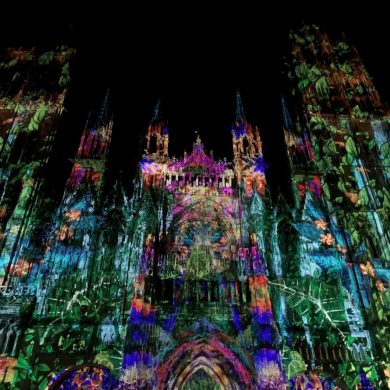
Rouen Cathedral light show
24 May - 28 September 2024
All major events in Normandy
More than just must-sees!
- 🧵 Alençon
- 🎖 Arromanches-les-Bains
- ⛲ Bagnoles-de-l’Orne
- 🛡 Bayeux
- 👫 Cabourg
- 🤴 Caen
- ☂ Cherbourg
- ⛱ Deauville
- 🎏 Dieppe
- 🗝 Étretat
- 🏰 Falaise
- 🐟 Fécamp
- ⛱ Granville and the Chausey Islands
- 🎨 Giverny
- 🏙 Le Havre
- ⛵ Honfleur
- ⛪ Lisieux
- 👼 The Mont-Saint-Michel and its Bay
- 👟 The Nez de Jobourg
- 🌳 The Perche
- 🕰 Rouen
- 🏝 Saint-Vaast-la-Hougue and Tatihou Island
- 🧗 The Suisse Normande
- 🎣 Trouville-sur-Mer
- 🌷 Normandy’s ‘most beautiful villages in France’
Return to top
Are you already in Normandy?
Plan what to see and do while you’re here by visiting normandy-secrets.com, which lets you in on all of the local secrets and hidden gems in the immediate vicinity!
Close search box

COMMENTS
Mont Saint-Michel. Mont Saint-Michel is one of the most glorious castles in Normandy, and a definite sight to see! It's an abbey that sits on top of a rocky island out at sea and looks like a mystical fortress from centuries past. Dating all the way back to the ninth century, it has been a Christian pilgrimage site, a prison holding those who ...
The castle grounds, outside of the keep, are free to visit and offer some good views of the surrounding area. The keep itself is great. At the time, 12 Euros for adults and free for children 5 and under. The tablet they give you to augment the visit is excellent and you can travel at your own pace to explore.
Read on to discover the most beautiful castles to visit in Normandy. Mont Saint-Michel . ... The chateau also played an important role in the D-Day landings of the Allied troops in Normandy, with the square tower serving as the BBC headquarters until 1944. The castle now holds events such as weddings, exhibitions and conferences. ...
Name of the castle - Castle of Gratot. Construction - Medieval castle built in the 16th century and modified by several generations (same family until the end of the 18th century) Location - La Manche, west coast 1 hour drive south of Cherbourg. Why I included it - It is not the most famous castle in Normandy.
Yes, the Château de Carrouges is well worth a visit. In fact, it's one of our Top 3 most beautiful châteaux in Normandy, for a number of reasons: Fascinating, immersive history: the château is a plunge into the great history of Normandy and France. The fantastic tales attached to it, legends and true stories, took us on a real journey back ...
Perched on its 120m-high rocky outcrop, the ruins of the castle of Monfort-sur-Risle overlook the tiny town in the valley of the Risle. You have an unrivalled view on the roads that led to Pont-Audemer, Brionne and Lieurey. The castle was built from the 16th to the 18th century, guarding one of the rare crossing points of the river.
Toggle Upper Normandy subsection. 2.1 Eure. 2.2 Seine-Maritime. 3 Notes and references. 4 See also. ... ° Chateau de Sommesnil in Sommesnil. Château du Taillis in ... See also. List of castles in France This page was last edited on 11 March 2022, at 06:02 (UTC). Text is available under the Creative Commons Attribution-ShareAlike License 4.0 ...
10. Colombières Castle. The Château de Colombières is a medieval castle built during the 14th century in Colombières, Calvados, Normandy. Located between Bayeux and Isigny-sur-Mer, near the Landing Beaches, the Château de Colombières is one of the most notable of Normandy at the time of the feudal military fortresses.
Chateaus and manor houses. From imposing medieval strongholds to peaceful half-timbered residences with thatched roofs, Normandy is a land rich in chateaus and manor houses. Our recommendations: Many prestigious monuments remain as illustrations of Norman military architecture from the days when English kings were Dukes of Normandy, such as the ...
15 Castles to Visit in Normandy. 1. Chateau de Caen. Built atop the fortress of William the Conqueror, Château de Caen is one of the largest medieval enclosure castles in Europe. It has been at the forefront of many battles over the years, with the English occupying it during the Hundred Years' War. From the castle, there are a number of ...
Listed as a historic site in 1875, Chateau d-Arques-la-Bataille is a castle of Normandy currently owned by the state and largely in ruins. However, the location is sublime and what remains of the structure provides glimpses into 12 th -century architecture and building. 11. Chateau d'Orcher.
One of the best places to visit in Northern France, the region of Normandy is known for its coastline, culinary delights, and historical sites, dating back to the Middle Ages and beyond. One sign of all this history is the many impressive Normandy castles, many of which experienced the Hundred Years' War.. The castles in Normandy are some of the most beautiful and well-preserved castles in ...
Medieval stone fortresses and elegant Renaissance manor houses, Lower Normandy is blessed with hundreds of ancient monuments. We have selected our favourites: ten châteaux to visit, dine in or stay the night in baronial style.#10 - Château des RavaletPhoto: Wikimedia CommonsOnce the property of the French King, François I, Château des Ravalet has a fascinating and chequered history. Jean ...
The castle grounds, outside of the keep, are free to visit and offer some good views of the surrounding area. The keep itself is great. At the time, 12 Euros for adults and free for children 5 and under. The tablet they give you to augment the visit is excellent and you can travel at your own pace to explore.
Château-Gaillard. Considered a cuttung-edge example of military architecture in its day, the Château-Gaillard was constructed by Richard the Lionheart in record time on the high chalk cliffs dominating a great meander in the River Seine. Today it is a ruin, but two villages below, Le Grand Andely and Le Petit Andely, merged over time to form ...
THE LOCAL AREA. Chateau Les Douves lies in the heart of the wild and beautiful Cotentin Peninsula area in Normandy, in Fontenay-sur-Mer, 300km west of Paris. The closest train station is Valognes (12 km). You can discover and enjoy the local area by walking or biking through the beautiful and peaceful countryside.
Chateau La Cheneviere Bayeux (Normandy) 29 rooms from £237. See more photos. Local exploring - Some of Normandy's most famed attractions are nearby including the Bayeaux Tapestry and D Day landing beaches. Foodies - The restaurant serves classical cuisine based on the flavours of Normandy.
The evocative ruins of Chateau Gaillard, built in the 12th century by Richard the Lionheart, are one of the most imposing sites in Normandy . See guide. Cherbourg (Manche) ... No visit to Normandy would be complete without visiting the iconic Abbey and island of Mont-Saint-Michel . See guide. Mortagne-au-Perche (Orne)
A favorite beach vacation destination on the Côte d'Albâtre, Fécamp is one of the best places to visit in Normandy for a relaxing holiday break. Established in 1832, Fécamp was one of France's first seaside resorts, known for attracting a high-society crowd. Today, sunbathers and socialites alike enjoy the refreshing ocean scenery.
The Mont-Saint-Michel is one of Europe's most unforgettable sights. Set in a mesmerising bay shared by Normandy and Brittany, the mount draws the eye from a great distance. This staggeringly beautiful location has long captured the imagination. The story of how the mount came to be a great Christian pilgrimage site dates back to the early 8th ...
The chateau is a 5 star property with comfortable beds, traditional decor, cozy sitting rooms and plenty of outdoor space to enjoy in the summer. ... When to Visit Normandy. Admittedly, mid-March was not the most ideal time to visit Normandy. We got very lucky with hardly any rain despite a forecast to the contrary.
4. Tapisserie de Bayeaux. Source: flickr. Tapisserie de Bayeaux. This world-renowned Anglo-Saxon embroidery is 70 metres long and half a metre high, depicting the events leading up to the Norman Conquest of England. The tapestry is on display in its entirety in a glass case at this museum in Bayeaux.
1944 - 2024: 80th Anniversary of D-Day and the Battle of Normandy. 1 - 16 June 2024 (D-Day Festival) and beyond until December 14 . Throughout Normandy